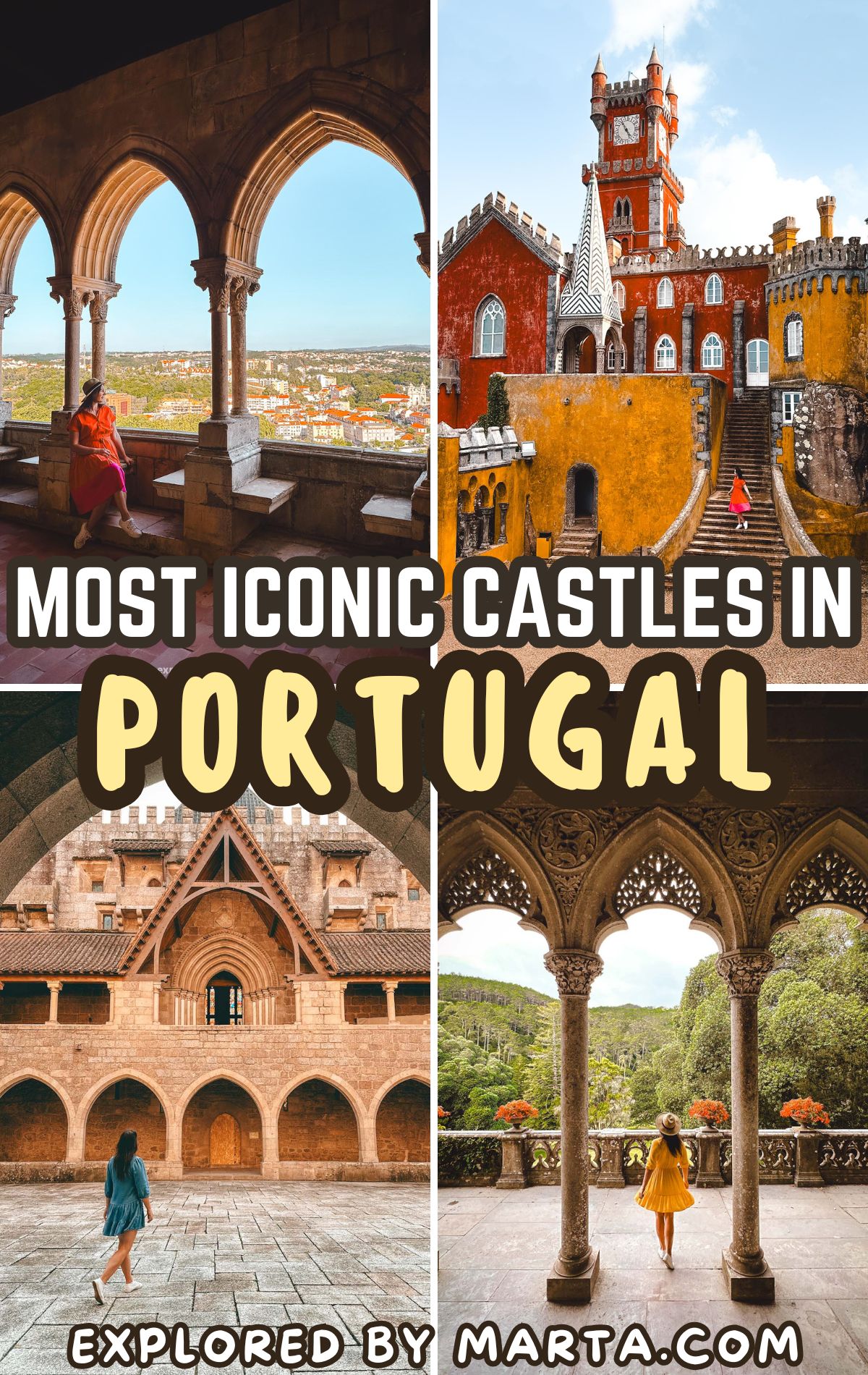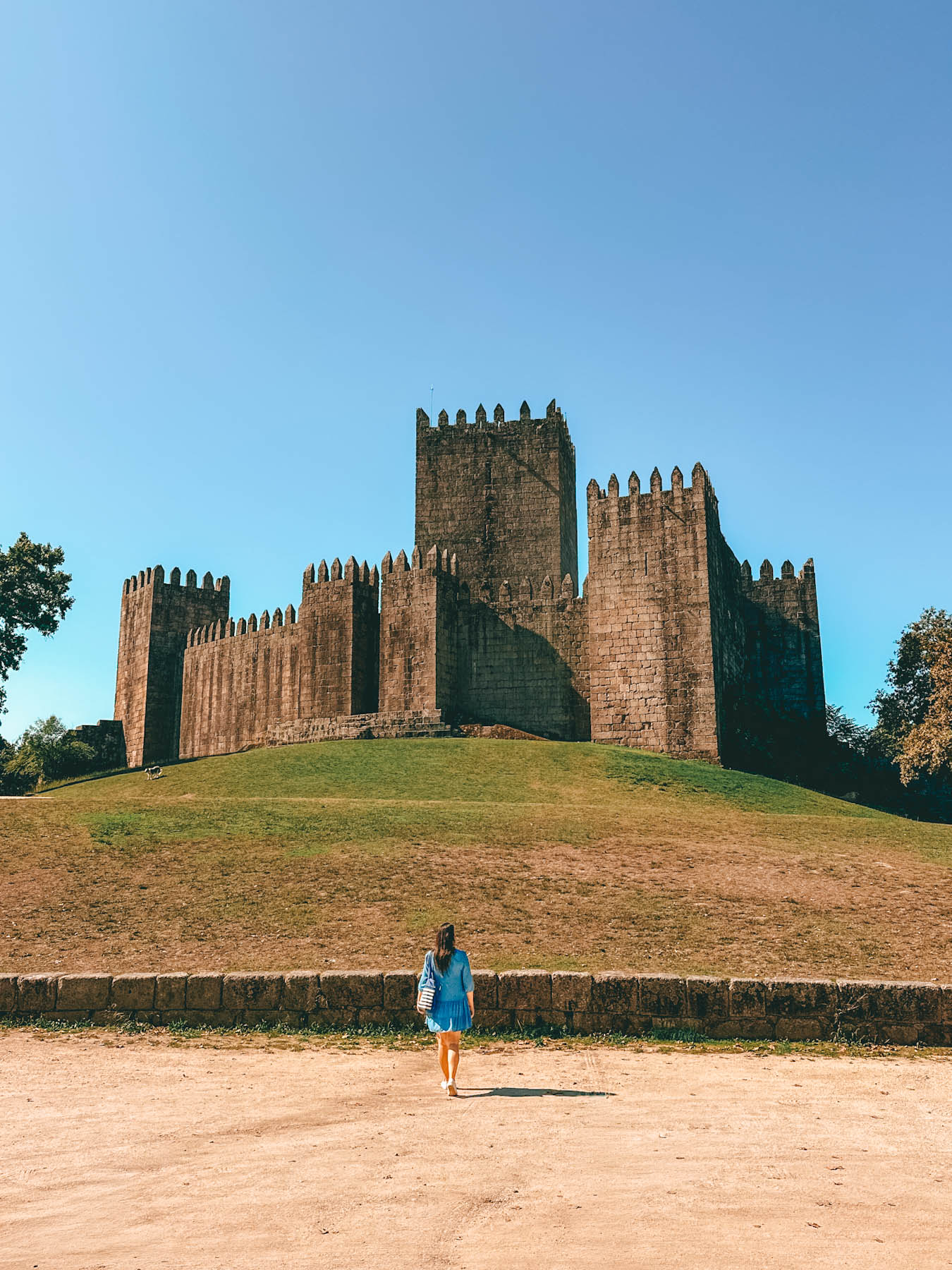23 fairytale palaces and castles in Portugal
This post may contain affiliate links. If you use these links to buy something I may earn a small commission at no extra cost to you! Thank you for your support!
Come with me to explore the most iconic palaces and castles in Portugal! From royal residences filled with history to fairytale-like palaces and mighty medieval fortresses, Portugal is home to some of the most stunning castles in Europe.
We’ve spent months traveling around Portugal and visiting all of these landmarks, each with its own story and character. From the romantic Pena Palace in Sintra to the ancient walls of Guimarães Castle, this country truly feels like stepping back in time!
In this blog post, you’ll find a list of the most iconic palaces and castles in Portugal, complete with descriptions, photos, and locations on Google Maps. Get ready to plan your perfect Portuguese adventure and include some of them in your own travel itinerary! Enjoy!
1. Pena Palace
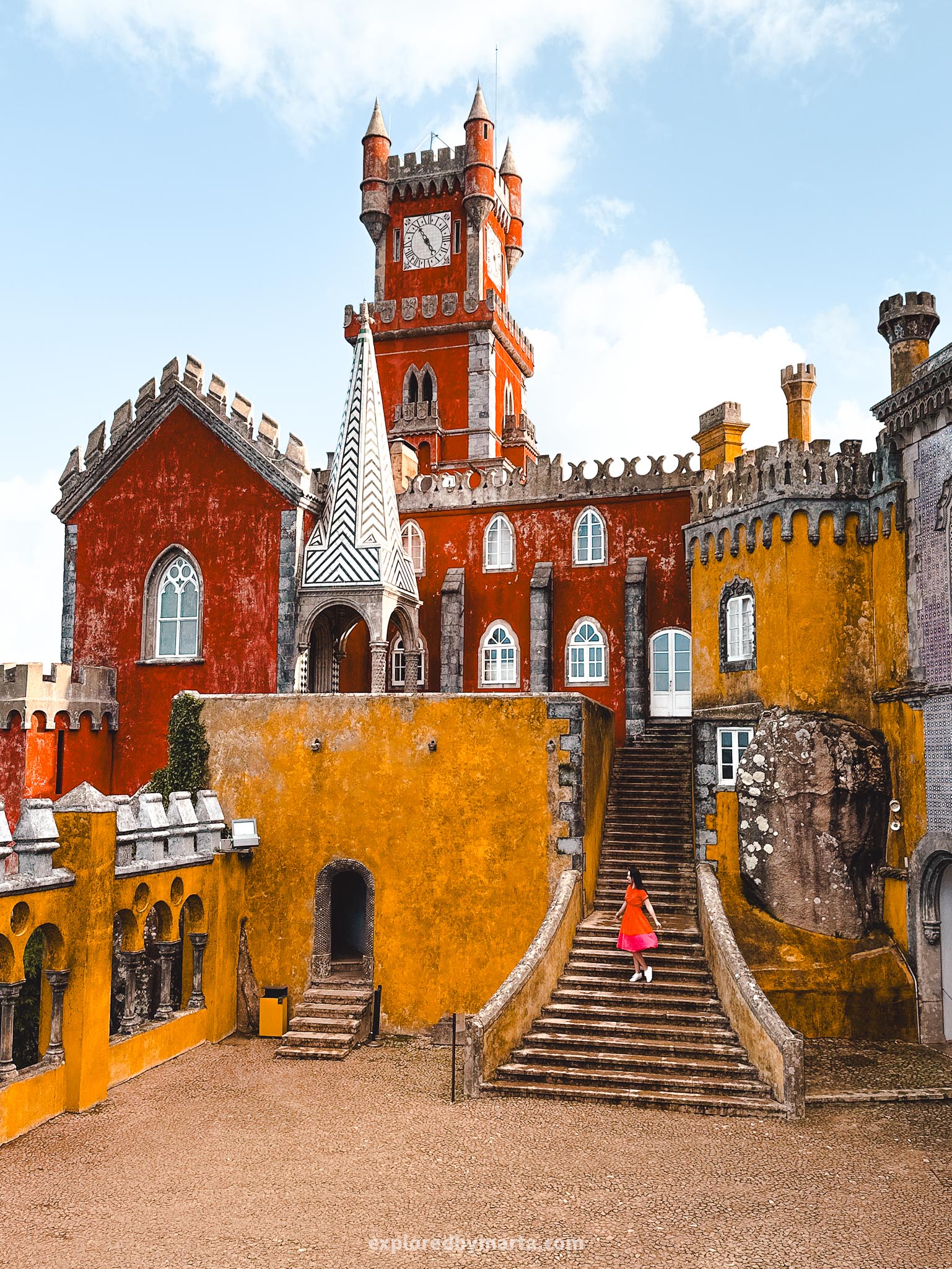
Out of all the palaces and castles in Portugal, the fairytale-like Pena Palace (Palácio Nacional da Pena) in the small town of Sintra is the most famous one of all. It is the most visited tourist attraction in Portugal!
The 19th-century palace is also a national monument and was voted as one of the Seven Wonders of Portugal by the public. Pena Palace sits on top of a hill in the Sintra municipality near Lisbon, making it the perfect destination for an easy day trip from Lisbon.
The Romanticist palace is famous for its colorful appearance, which makes it look like it came straight out of a Disney movie.


Fun fact! The Pena National Palace was built on the site of an old monastery. When King Ferdinand II of Portugal married Queen Maria II in 1836, he wanted to build a summer residence for the family and fell in love with this place in Sintra.
So he bought the convent as well as the surrounding area and started building a palace. Today, you can actually distinguish between the two parts of the palace – the red part is the old monastery, but the yellow and blue parts are the new building.
King Ferdinand not only ordered the building of the Palácio da Pena but also a large park around it. The exotic park includes diverse trees and plants from all corners of the Earth, including North America, China, Japan, Australia, and New Zealand!

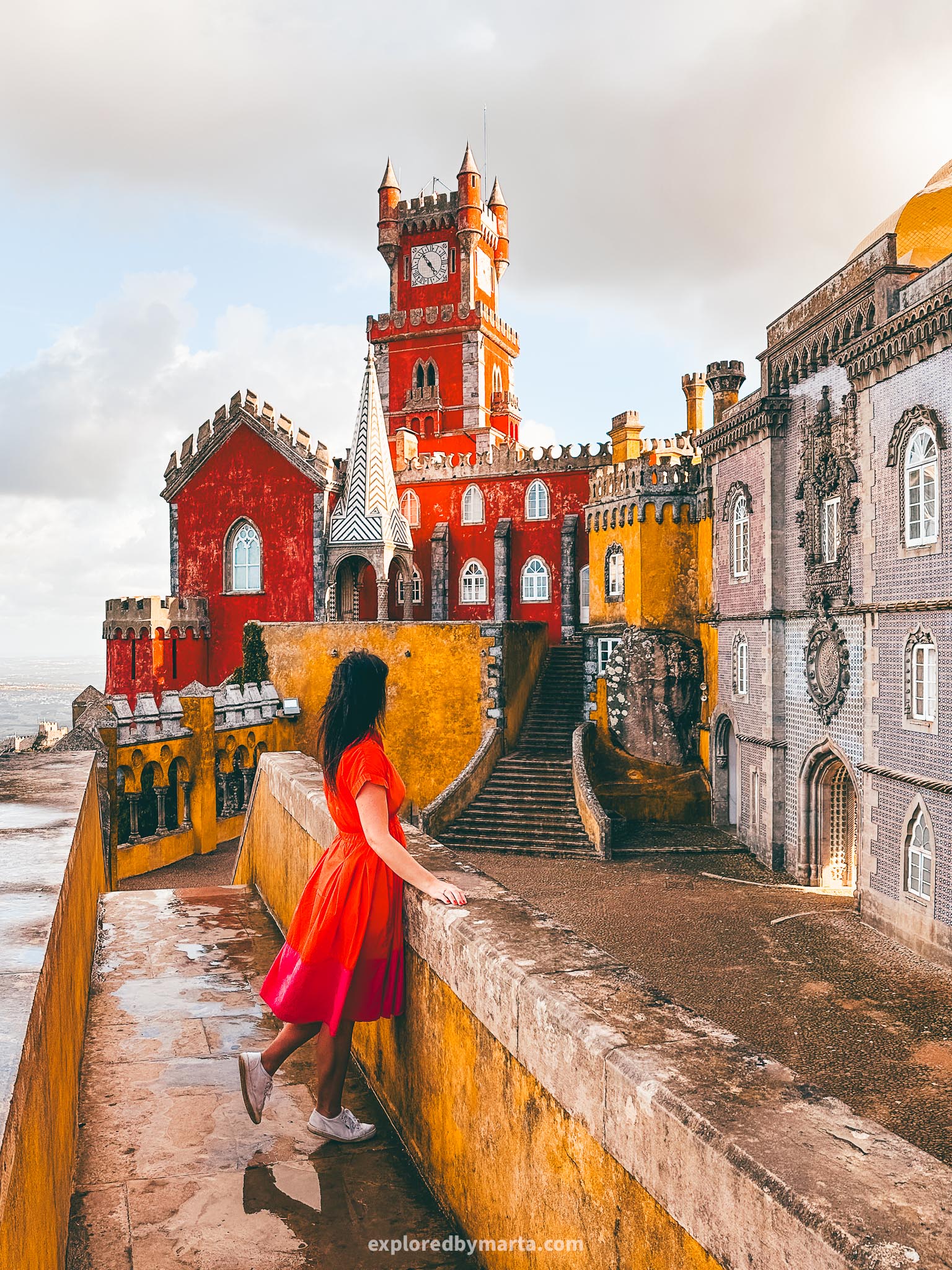
The unique climatic conditions up on the mountain (not too cold, not too hot) are very suitable for the exotic foreign plants. It is also very common to see a big cloud of fog surrounding the palace when the humidity arrives from the nearby ocean.
The Pena Palace is a must-see spot to visit in Sintra, so I would highly recommend visiting this place first thing in the morning, before it turns into chaos with long lines and crowds, or go there right before closing. And buy your tickets online!
My favorite place in Pena Palace was the inner square next to the red Clock Tower. Not only does it have incredible panoramic views over the West Coast of Portugal, but it is also the most picture-perfect place in the palace!
Location: Palácio Nacional da Pena – Entrance ticket
2. Guimarães Castle
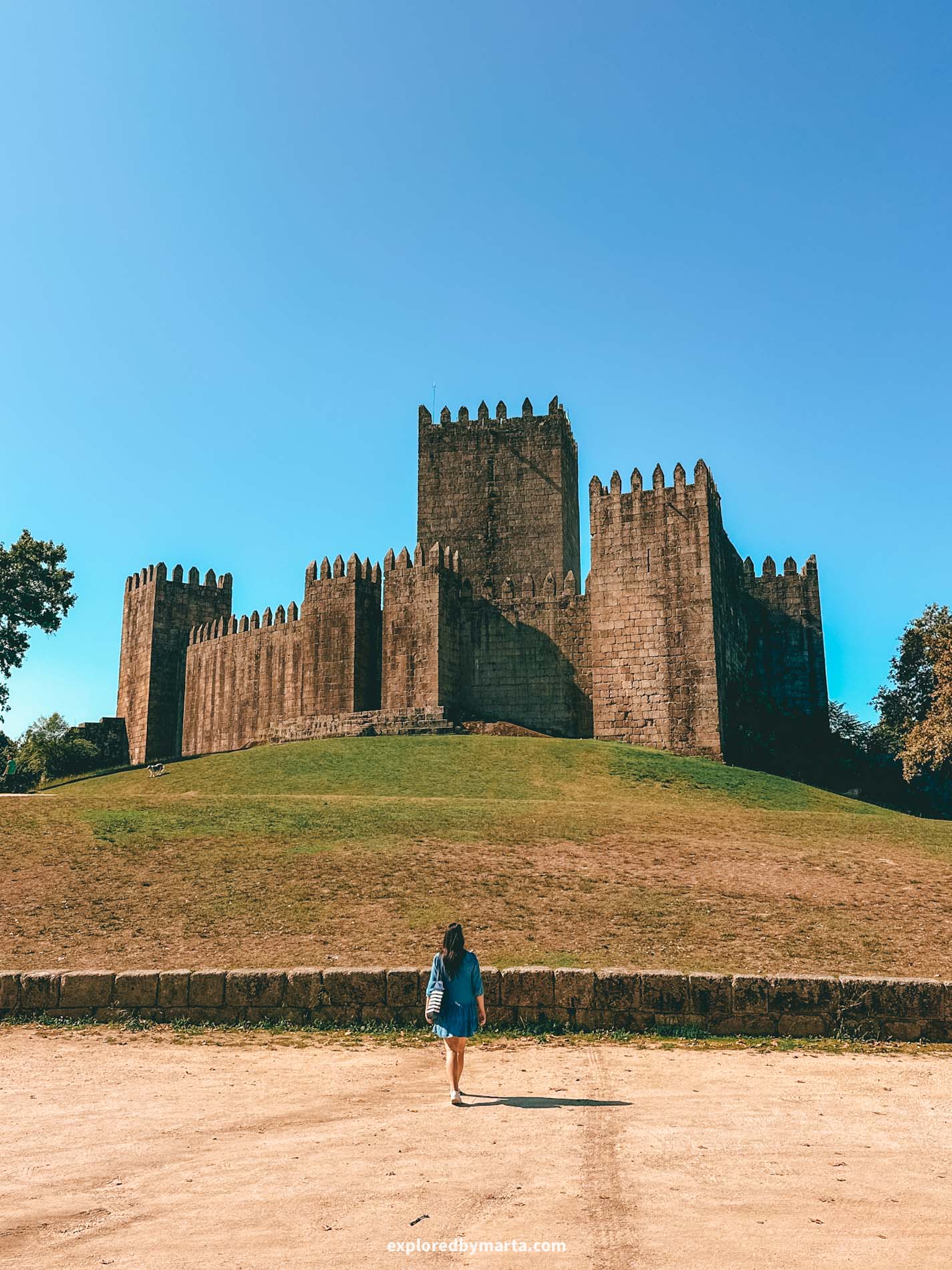
Known as one of the Seven Wonders of Portugal (a list of popular and significant attractions voted by the Portuguese themselves), Guimarães Castle sits on a green hill overlooking the Guimarães town.
The castle dates back to the 10th century and was built to defend the local settlement from attacks. It is more like a fortress, so you won’t find there any grand bedrooms or halls – just thick stone walls drenched in 1,000 years of history.
What you see there today mostly dates back to the 12th century, when Count Henry of Burgundy lived there with his wife Teresa. Their son, Afonso Henriques, later became the first king of Portugal.
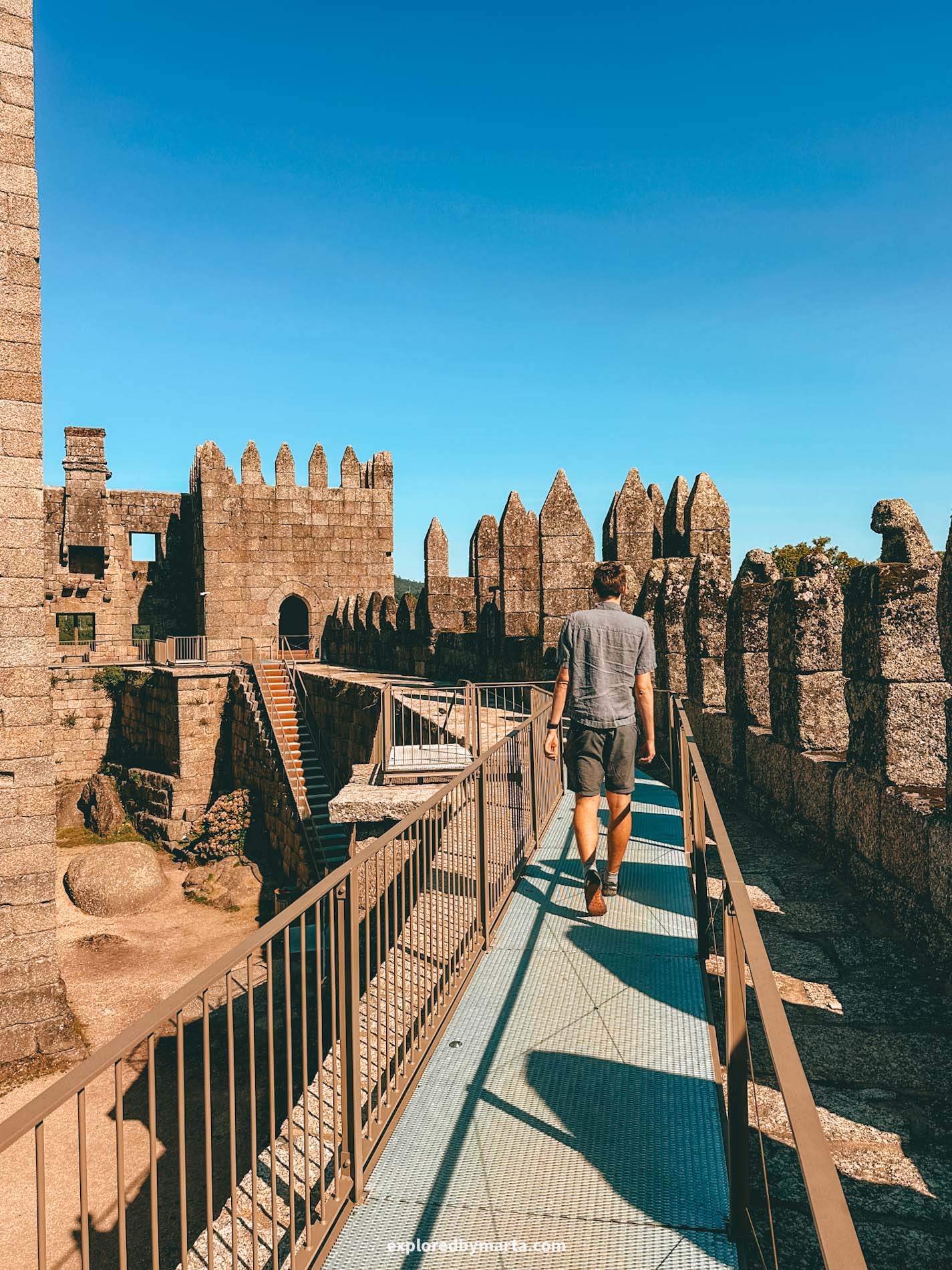
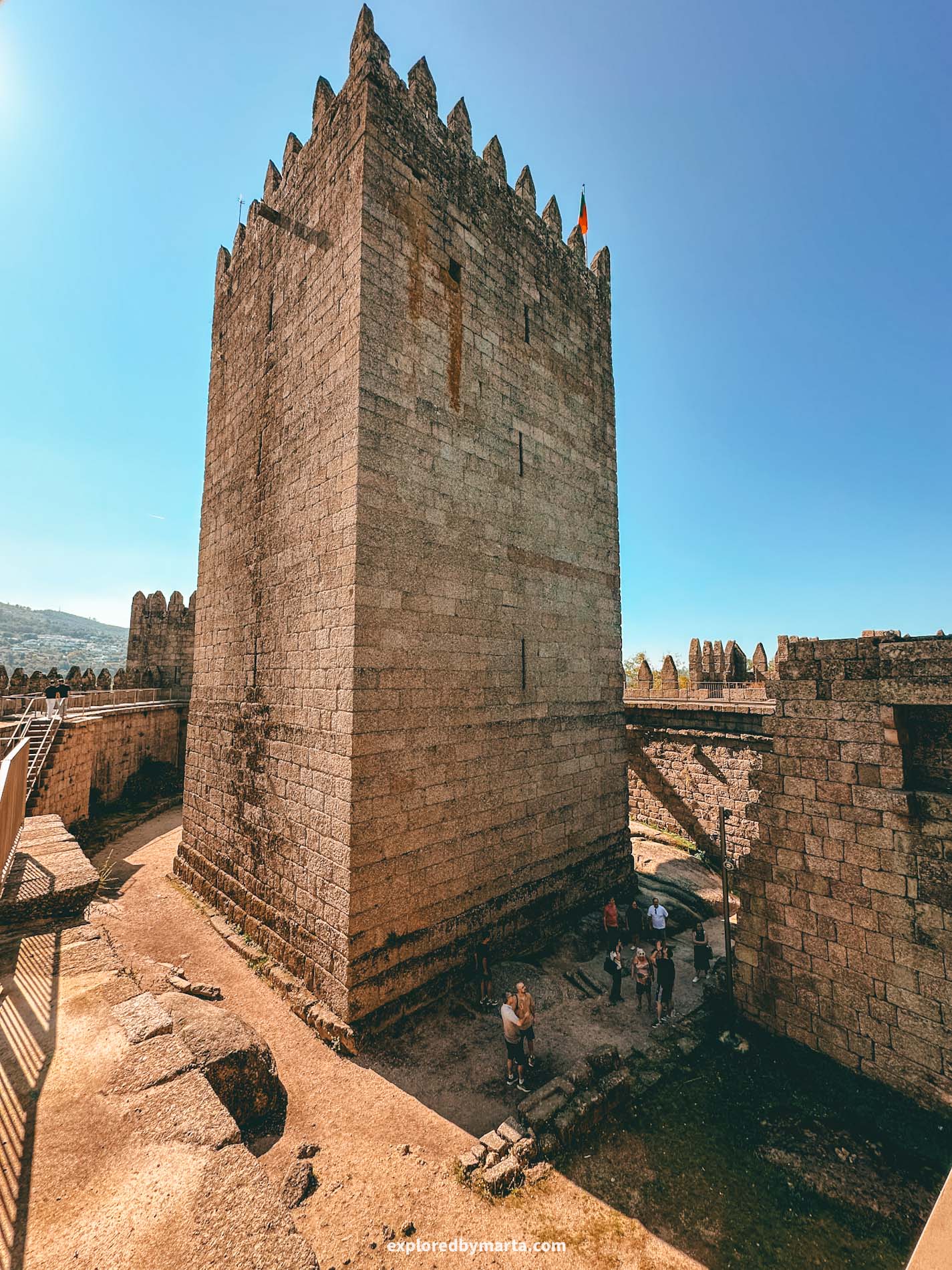
It is believed that King Alfonso Henriques spent part of his childhood within the walls of this castle, so today people see it as the cradle of the nation – the place where Portugal was born!
Exploring the Guimarães Castle is one of the best things to do in Guimarães. There is a small entry fee to enter the castle.
To be honest, there is not a lot to see – the inner courtyard, the fortress walls and eight defensive towers, and that’s about it. Plus, the views of the city, however, due to its historical significance, it is considered one of the most important attractions in the country.
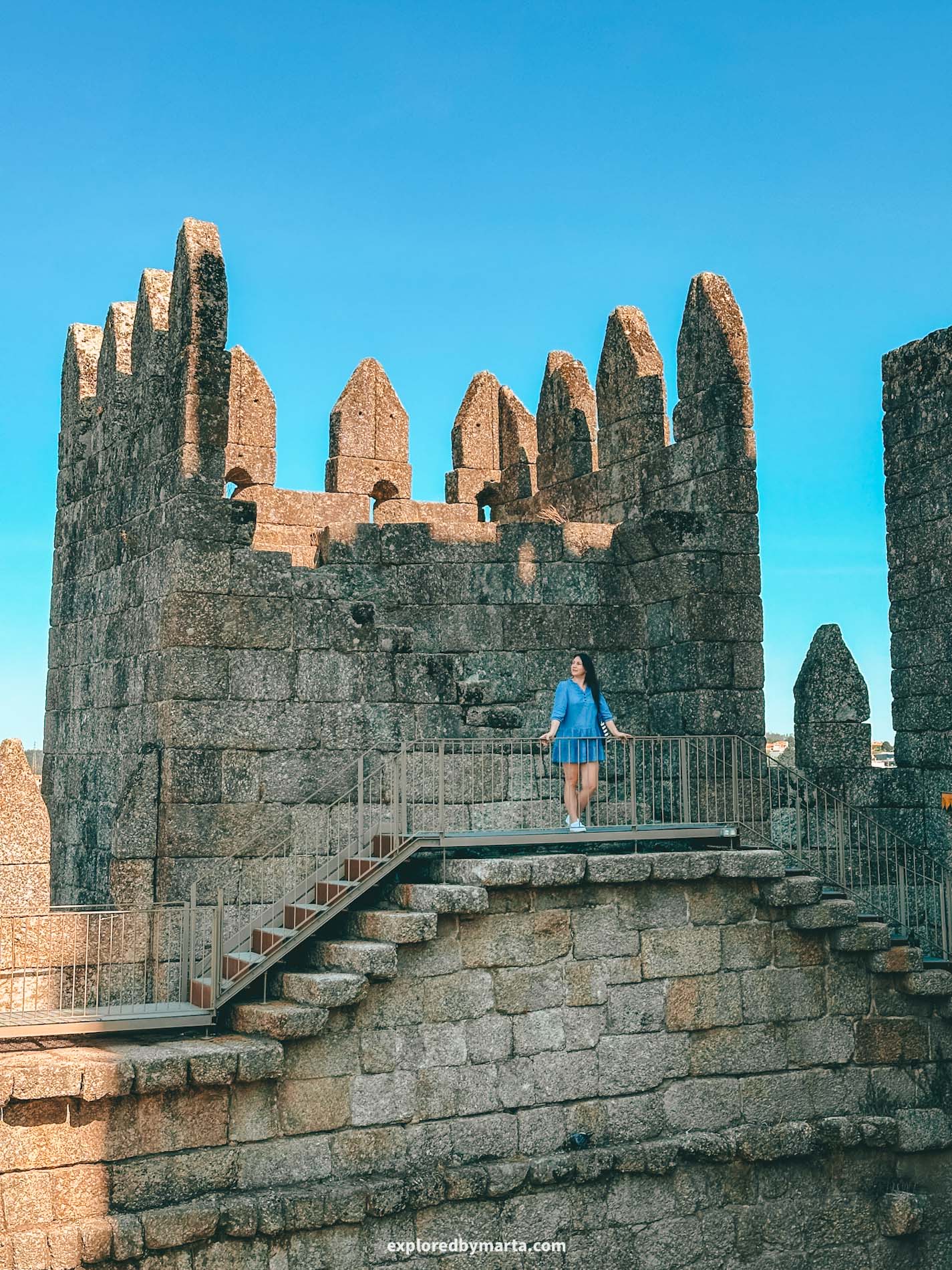
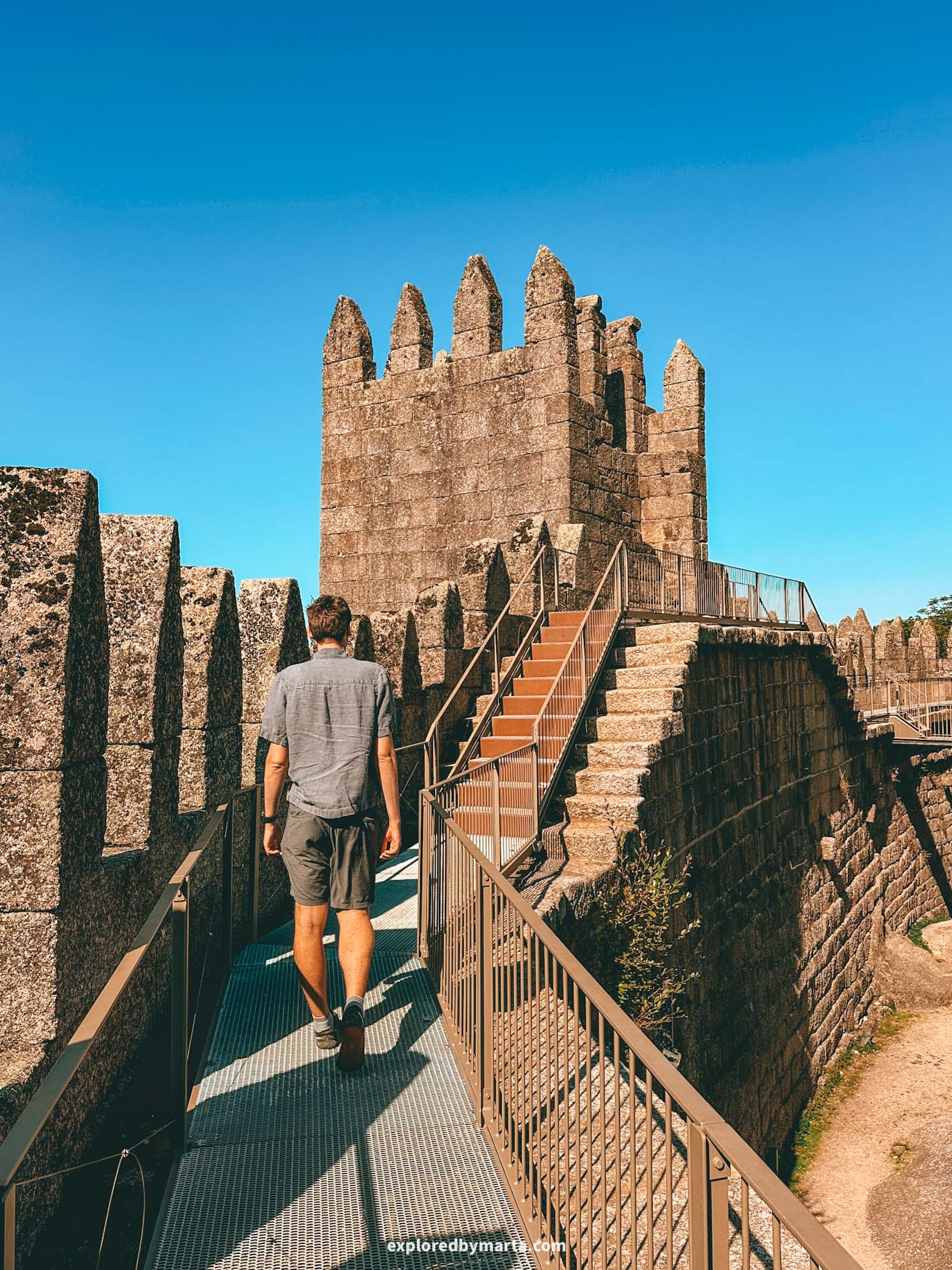
Walking around the walls does feel like stepping back in time.
We climbed up the stairs and walked around the top of the walls, and, of course, admired the panoramic views of Guimarães.
After the visit, we walked around the castle and found the perfect vantage point for a photo of the castle sitting on a green hill (see the first photo).
If you are visiting Northern Portugal, this is one of the top places to include in your itinerary. This is where the story of Portugal truly began.
Location: Guimarães Castle
3. Castelo dos Mouros
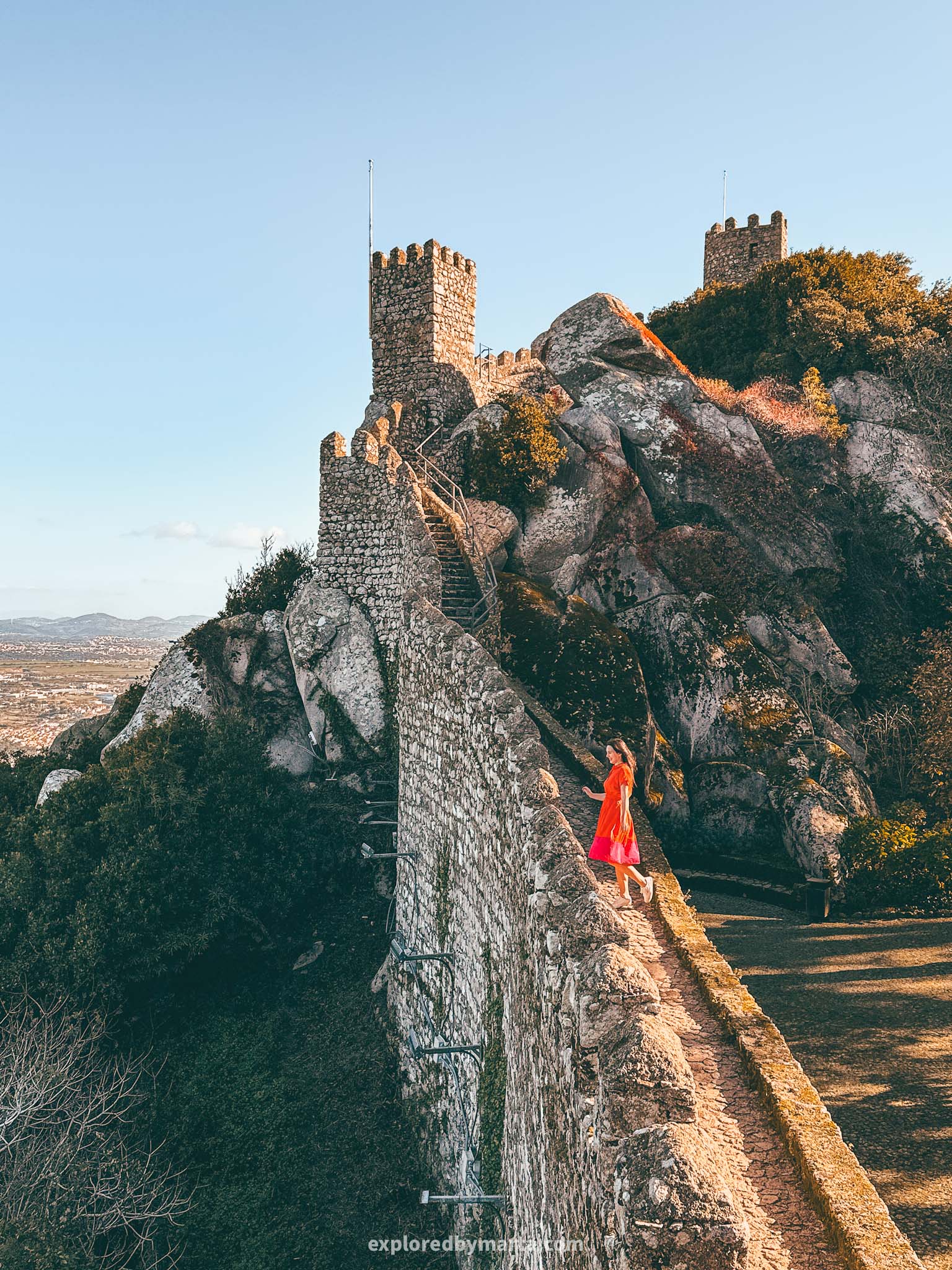
Now, back to Sintra!
Sintra is full of magical places, and Castelo dos Mouros, or the Moorish Castle, is one of them. This medieval castle, which was built during the 8th and 9th centuries by the Moors, is amongst the most impressive castles in Portugal.
Castelo dos Mouros was conquered by the first king of Portugal, Afonso I of Portugal, also called Afonso Henriques, in the 12th century. It is, in fact, a medieval fortress (not a livable castle) as it was built as a strategic military structure.
Despite its name, you won’t see much of a castle today – all you can explore during your visit are 450-meter-long massive stone walls with multiple defensive towers built on large rock formations.
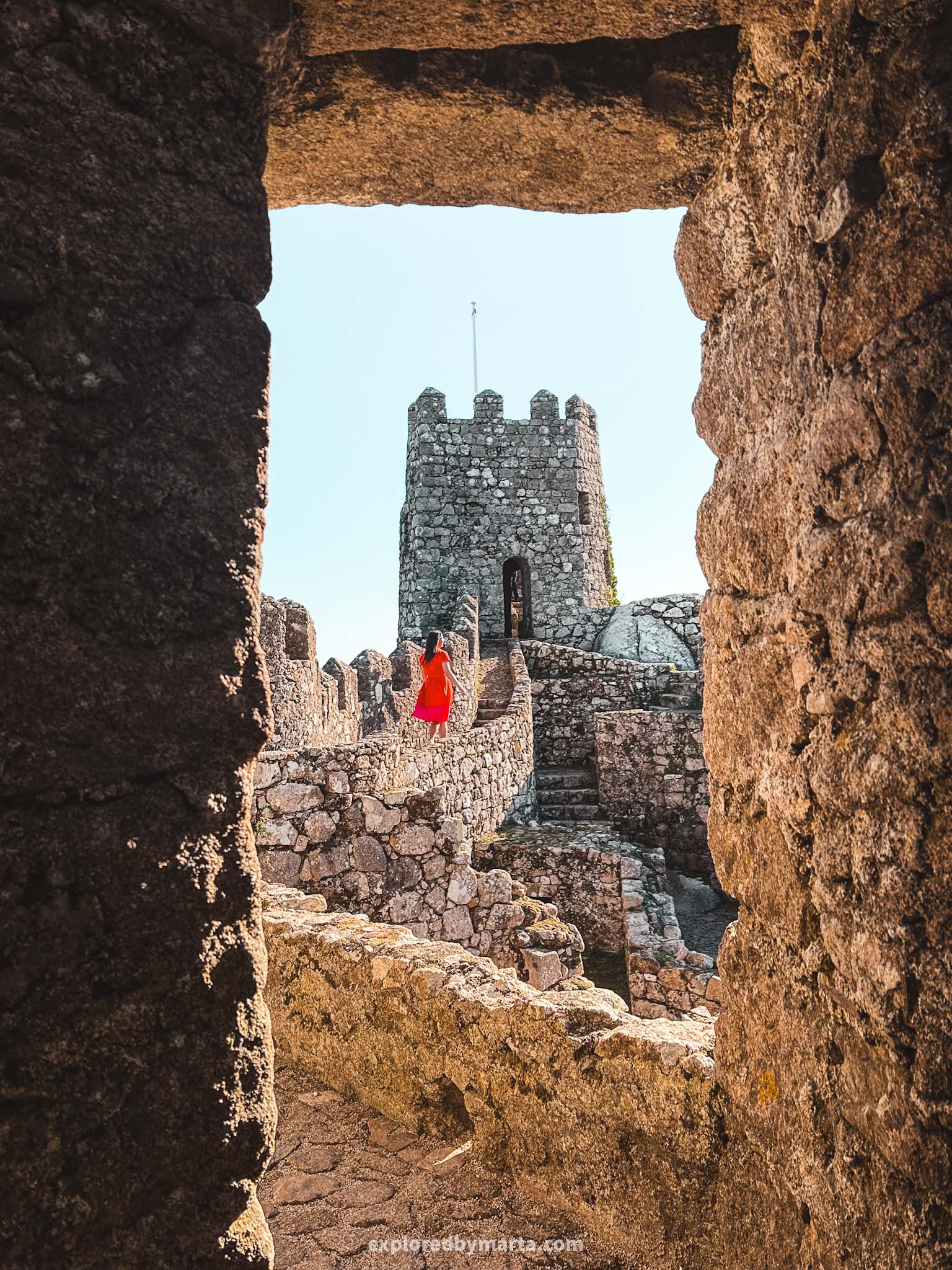

When visiting the Castle of the Moors, definitely walk around the whole perimeter of the walls. They offer some of the best views over Sintra-Cascais Natural Park and Sintra Mountains. Fingers crossed for a clear day and blue sky on the day of your visit!
It helps if you can arrive in the morning, but this castle is not as crowded as the famous Pena Palace.
If you really come here first thing in the morning, know that the entrance to the castle is located a good distance from the main road! You have to enter the gate and walk about 350 meters to the actual entrance to the castle (exact location below).
Location: Castelo dos Mouros – Entrance to the castle – Entrance Tickets
4. Palace of Monserrate

Now, one of my personal favorites of all the palaces and castles in Portugal: the Palace of Monserrate.
The majestic Palace of Monserrate in Sintra stands out as one of the most gorgeous palaces in terms of architecture. The unique palace was built in the middle of the 19th century, and it serves as the perfect example of Sintra romanticism.
The credit for creating this masterpiece goes to an English merchant, Francis Cook, who created this vision by mixing elements of Gothic, Indian, and Moorish styles.


The palace features romantic archways and overlooks the natural beauty of the gardens and forests surrounding the palace. It is part of the Sintra Cultural Landscape, which, unsurprisingly, is listed as a UNESCO World Heritage Site.
Despite the unique exterior, I do think that the most iconic part of the Palace of Monserrate is the inside. Although the palace is rather small compared to other palaces and castles in Sintra, it is packed full of dazzling beauty.
As you enter the palace, you will have the opportunity to explore two floors connected by a staircase. The rooms upstairs are less impressive than downstairs, where you can observe an exotic mix of architectural styles.
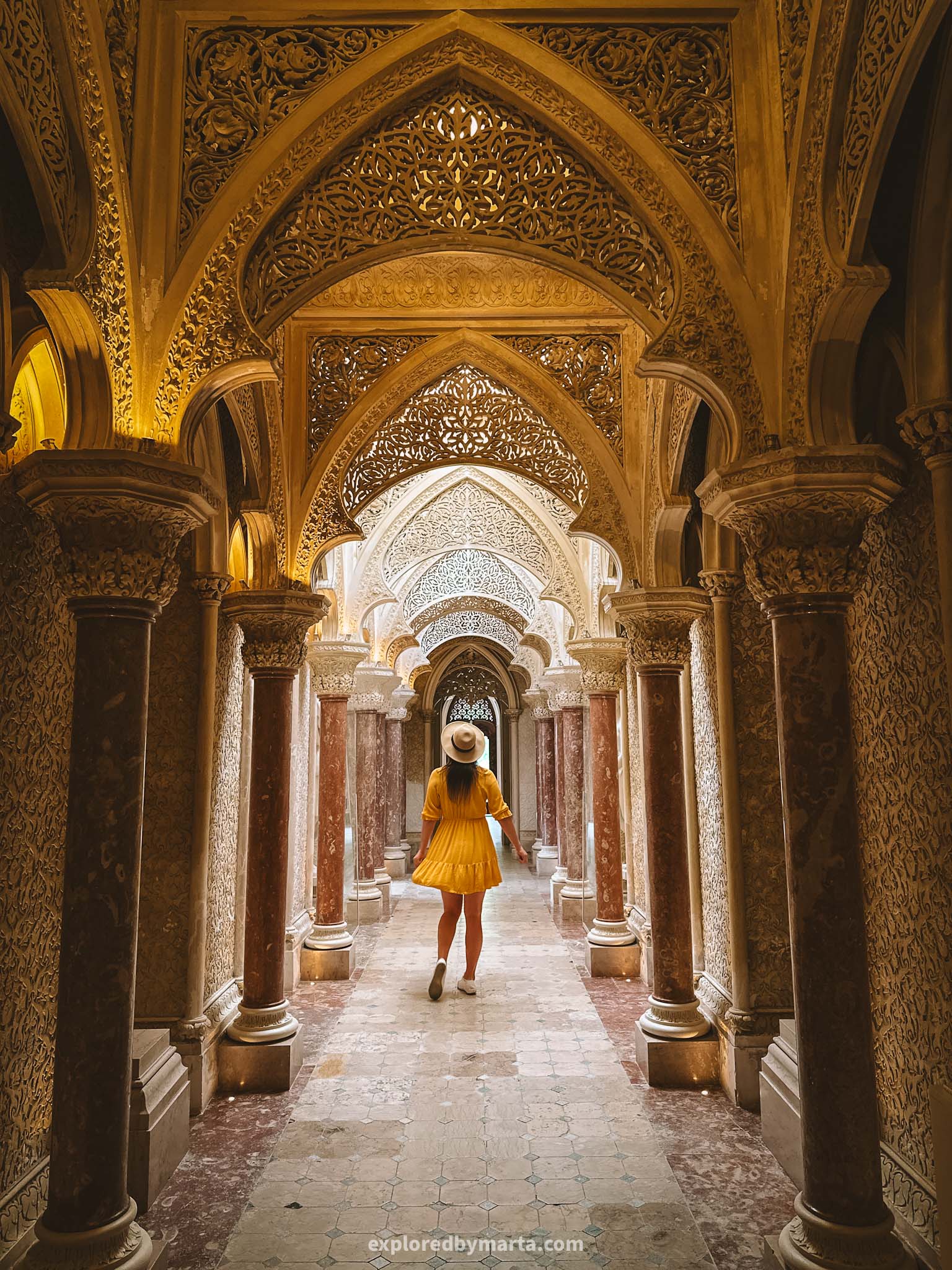
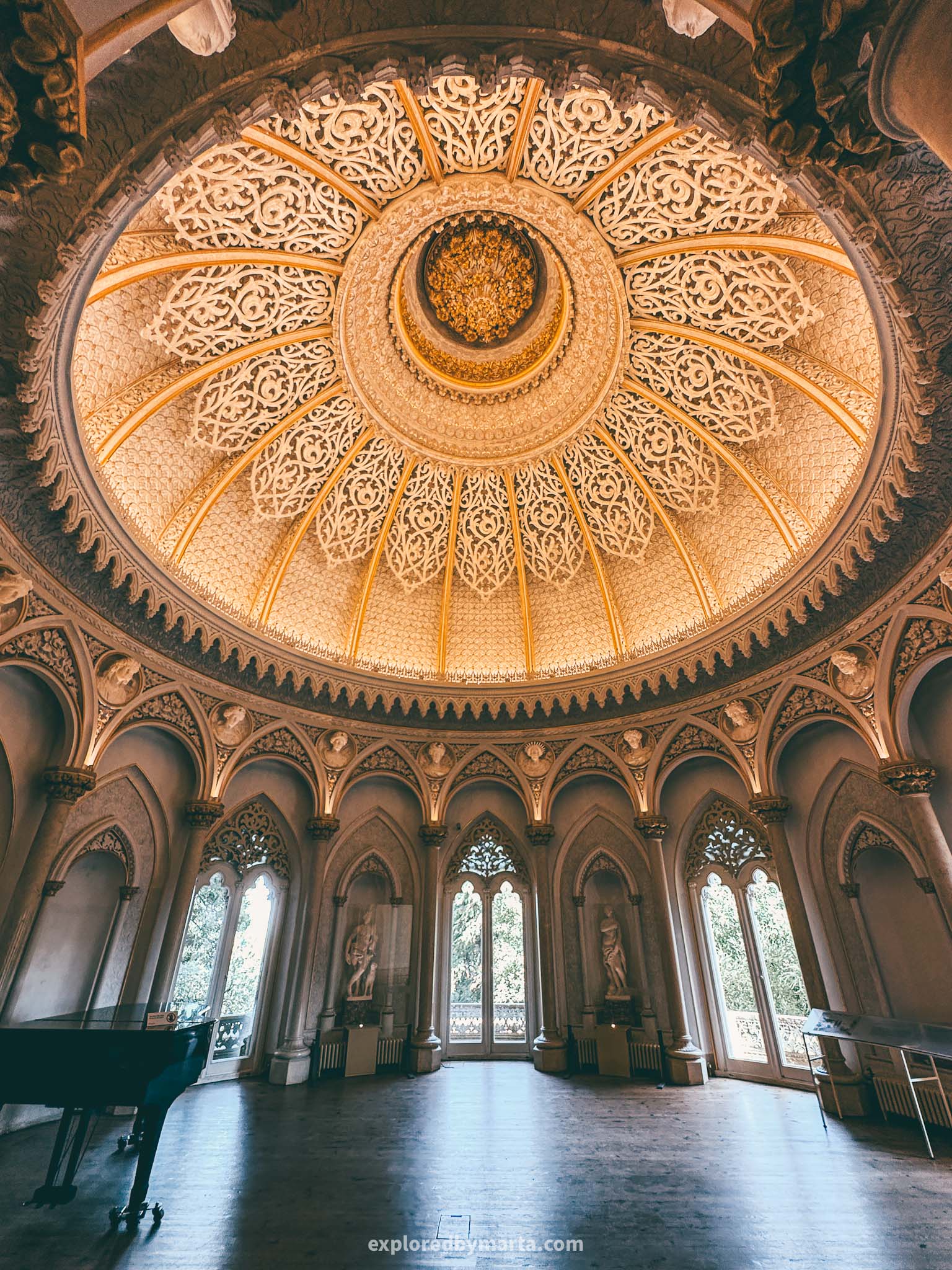
One of my favorite places in the Palace of Monserrate is the hallway lined with golden Moorish-style arches decorated with carved elements and details (photo above). This picture-perfect hallway is one of the top Instagram spots in Sintra!
After visiting the palace, don’t forget to stroll around the gardens and the park. It hides some beautiful hidden gems, like ruins of an old chapel already overgrown with trees and plants.
The whole palace felt like a magical fairytale. No wonder it is amongst the most amazing wedding venues in Portugal. There is an entry fee to the palaces, and I highly recommend buying tickets online before your visit.
Location: Palace of Monserrate – Entrance tickets
5. Castle of Óbidos
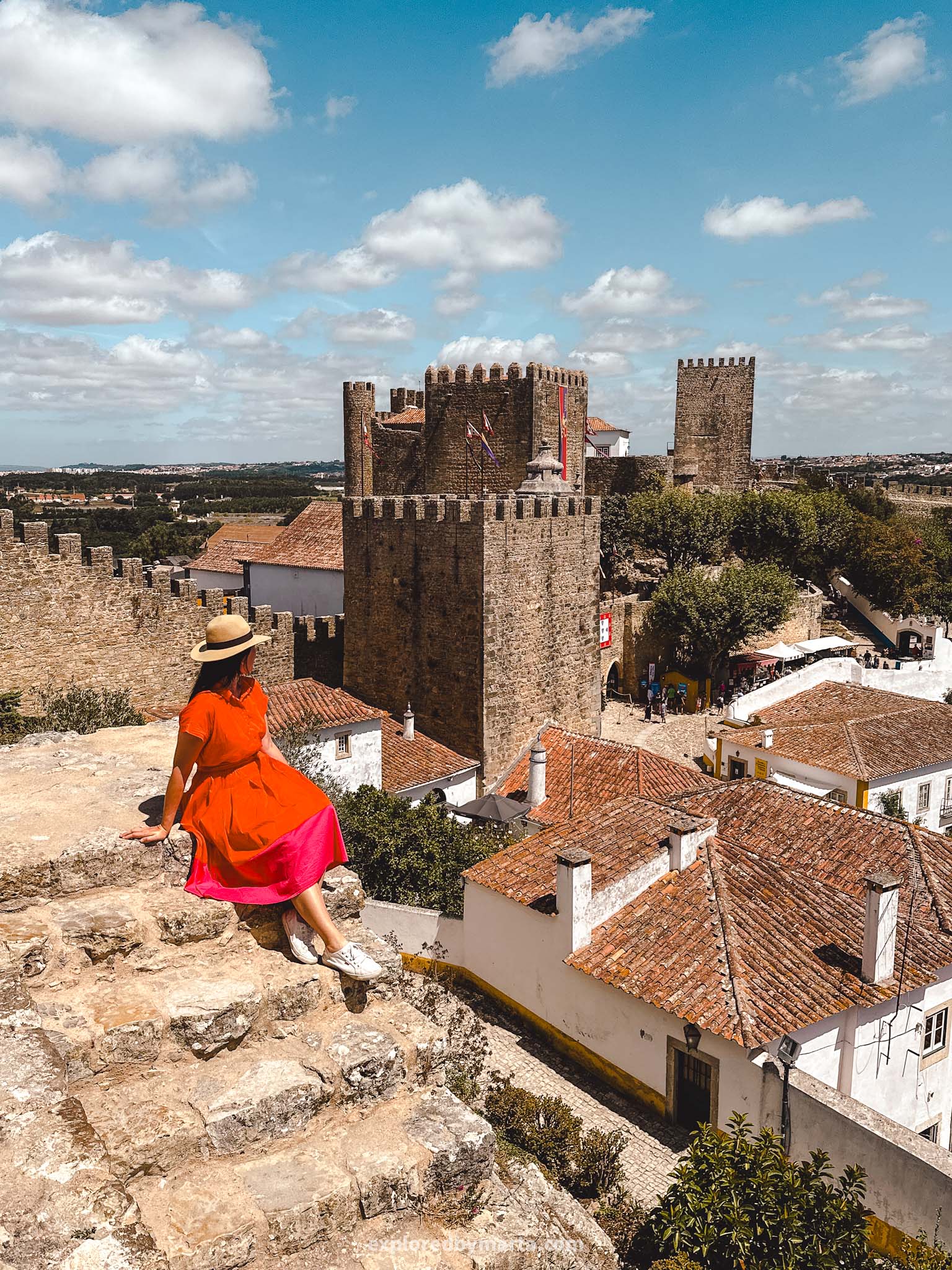
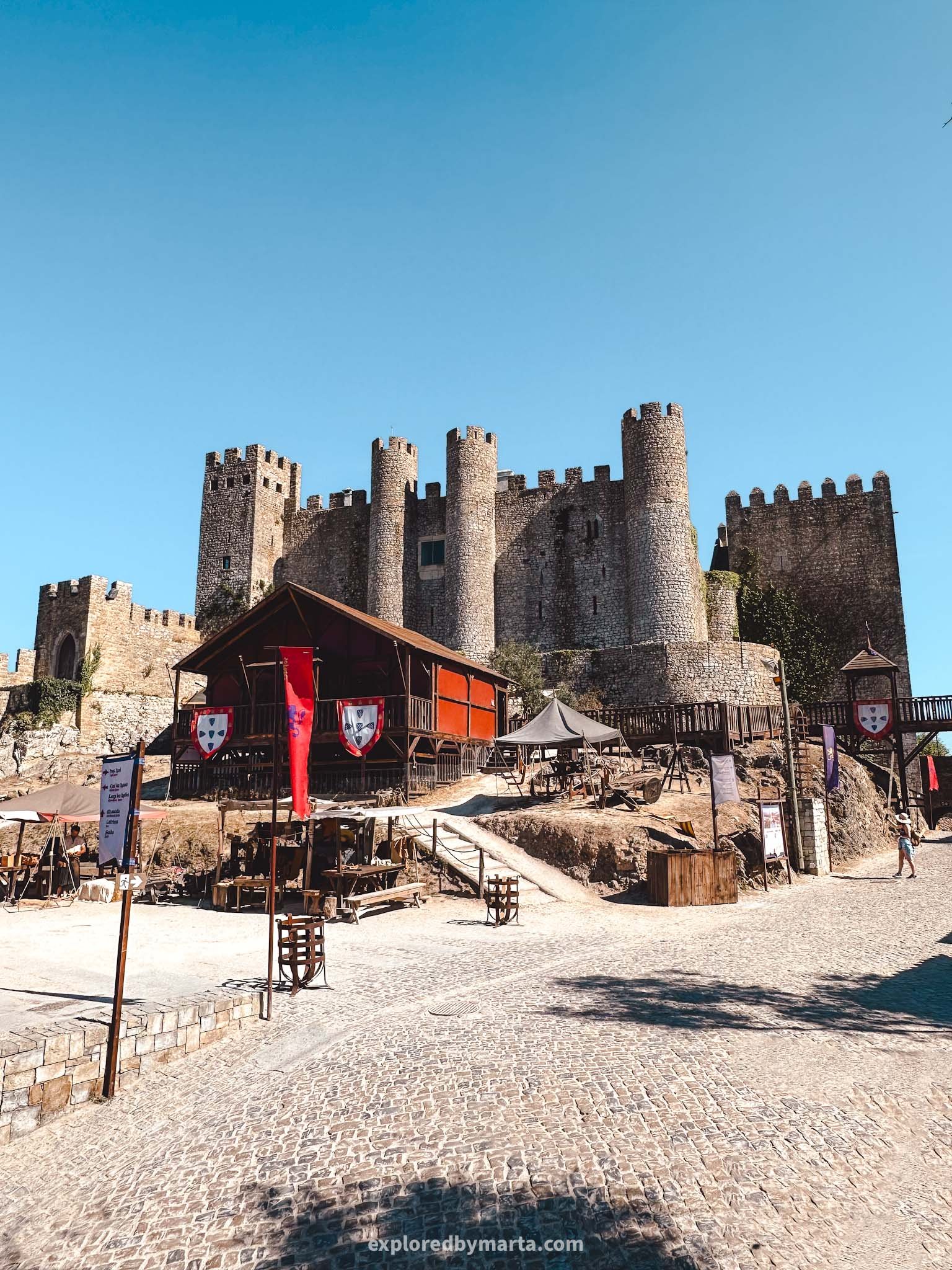
One of the most iconic Portuguese castles is located in a charming town called Óbidos (a must-visit place!), just a short drive from Lisbon. Just look at that massive stone structure!
The Óbidos Castle is one of the most famous medieval castles in Portugal and is among the Seven Wonders of Portugal – the most iconic landmarks in Portugal voted by the Portuguese people.
Construction of the castle took place during the 12th and 13th centuries, but the castle and the fortifications were rebuilt, expanded, and renovated over the centuries that followed.
It also suffered great damage during the 1755 Lisbon earthquake.
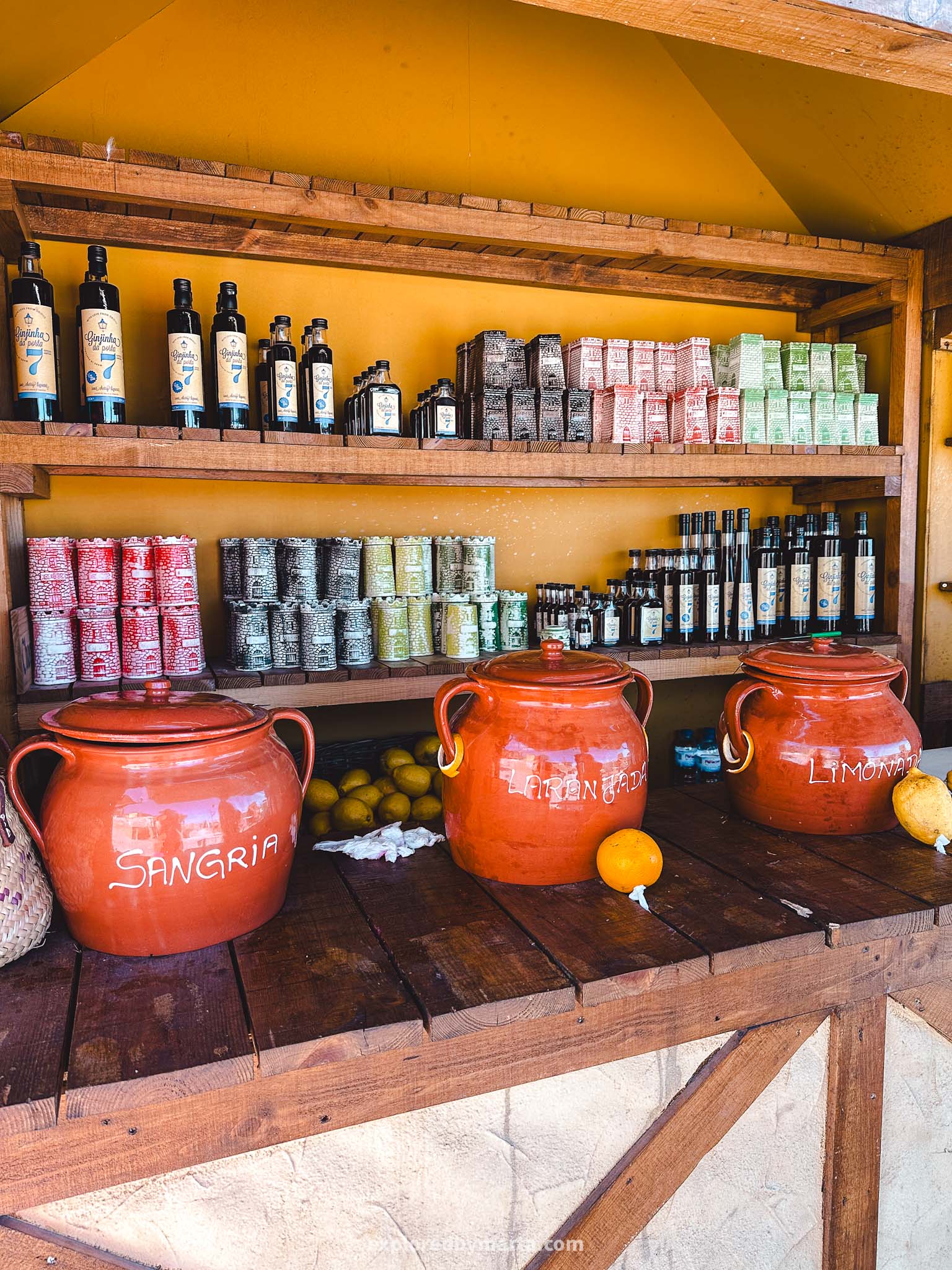
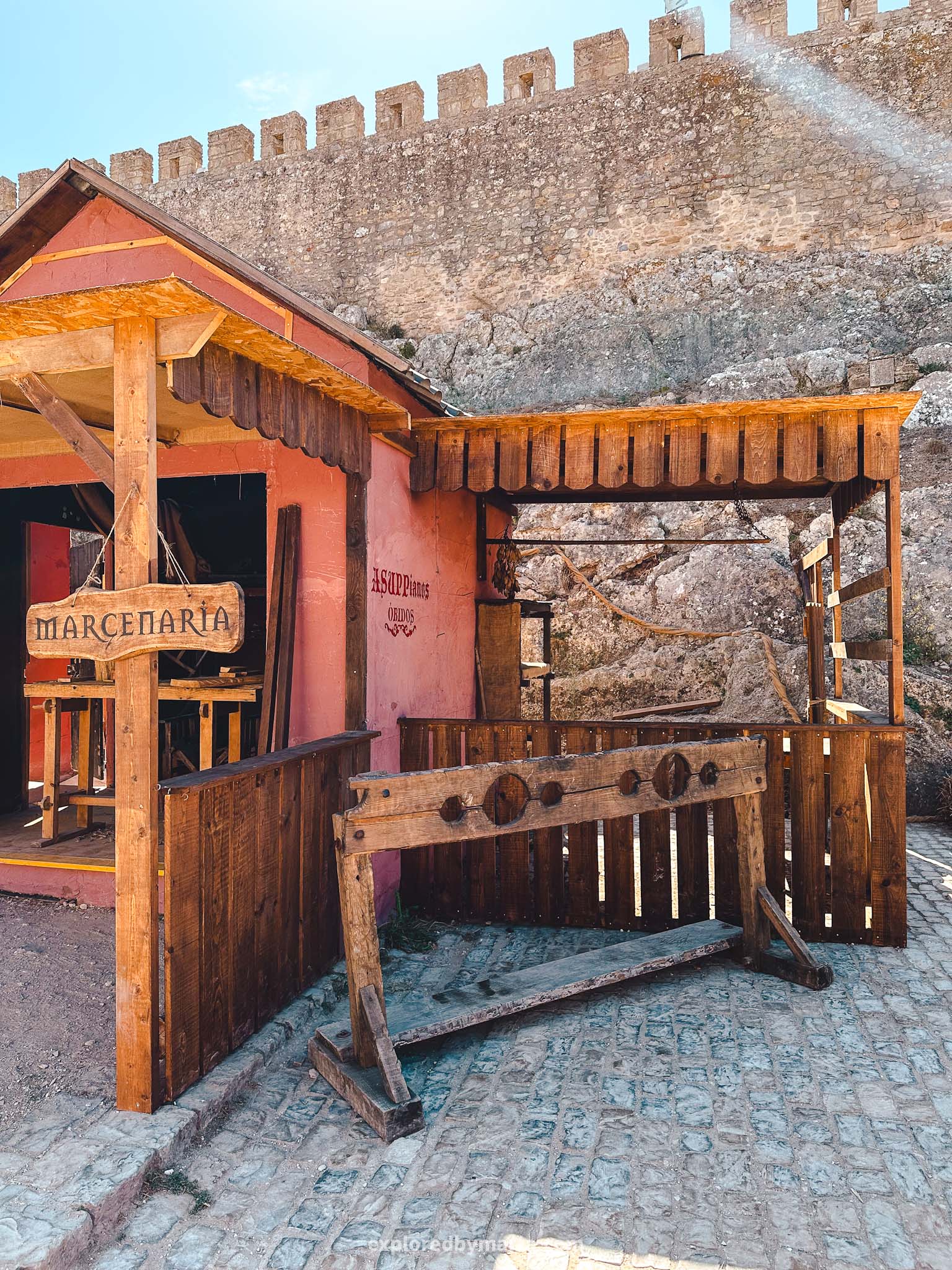
Óbidos Castle sits on a hill about 80 meters above sea level. It is part of a defensive structure that consists of the castle, towers, and defensive walls that completely encircle the Óbidos Old Town.
The castle building mixes different architectural styles and has elements of Gothic, Manueline, Baroque, as well as Romanesque architecture.
During the medieval centuries, this town and castle were favored as a residence by many Portuguese queens. The castle itself today is turned into a luxury hotel, so you cannot visit the castle as a tourist unless you book a stay there.
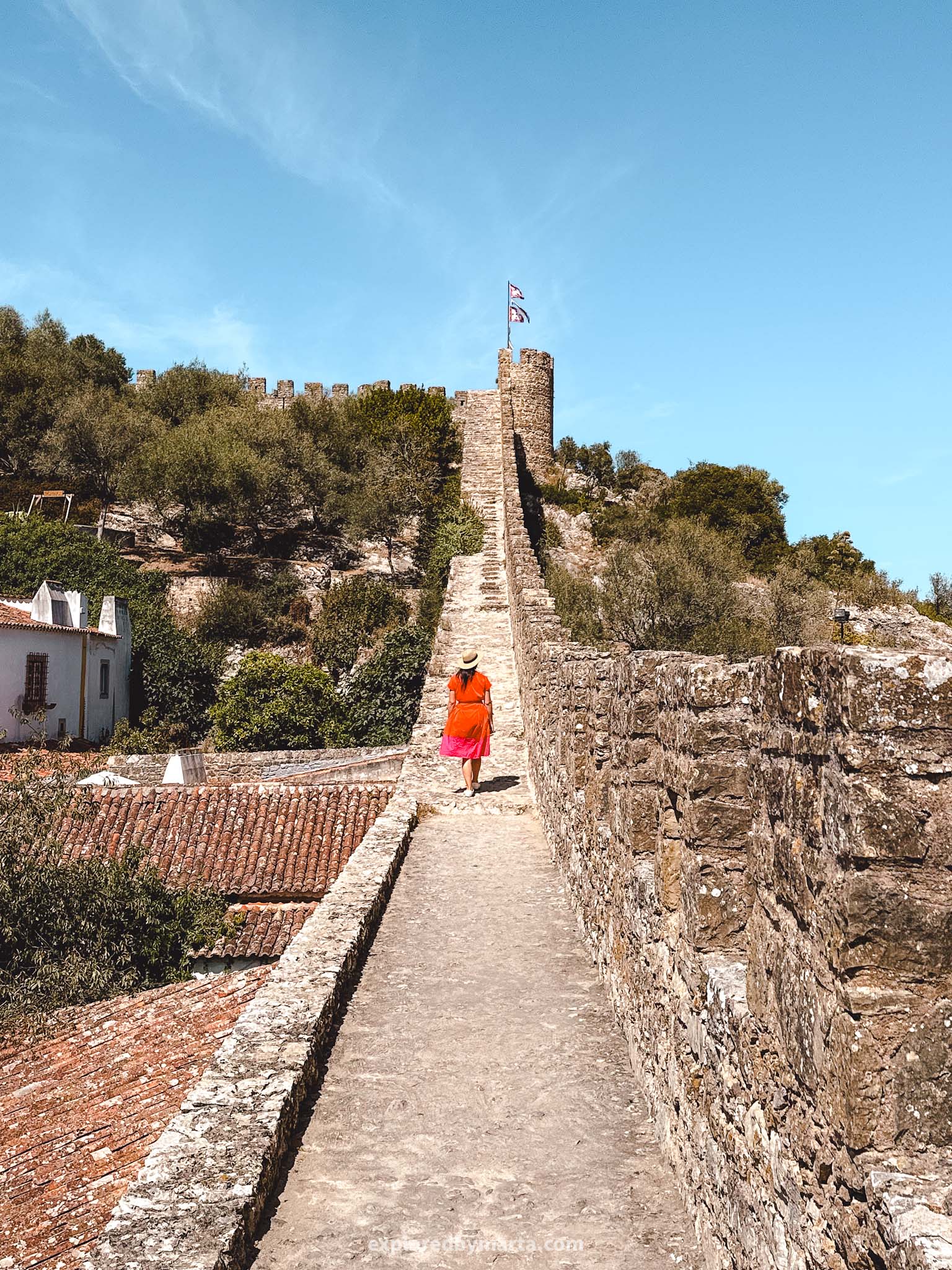
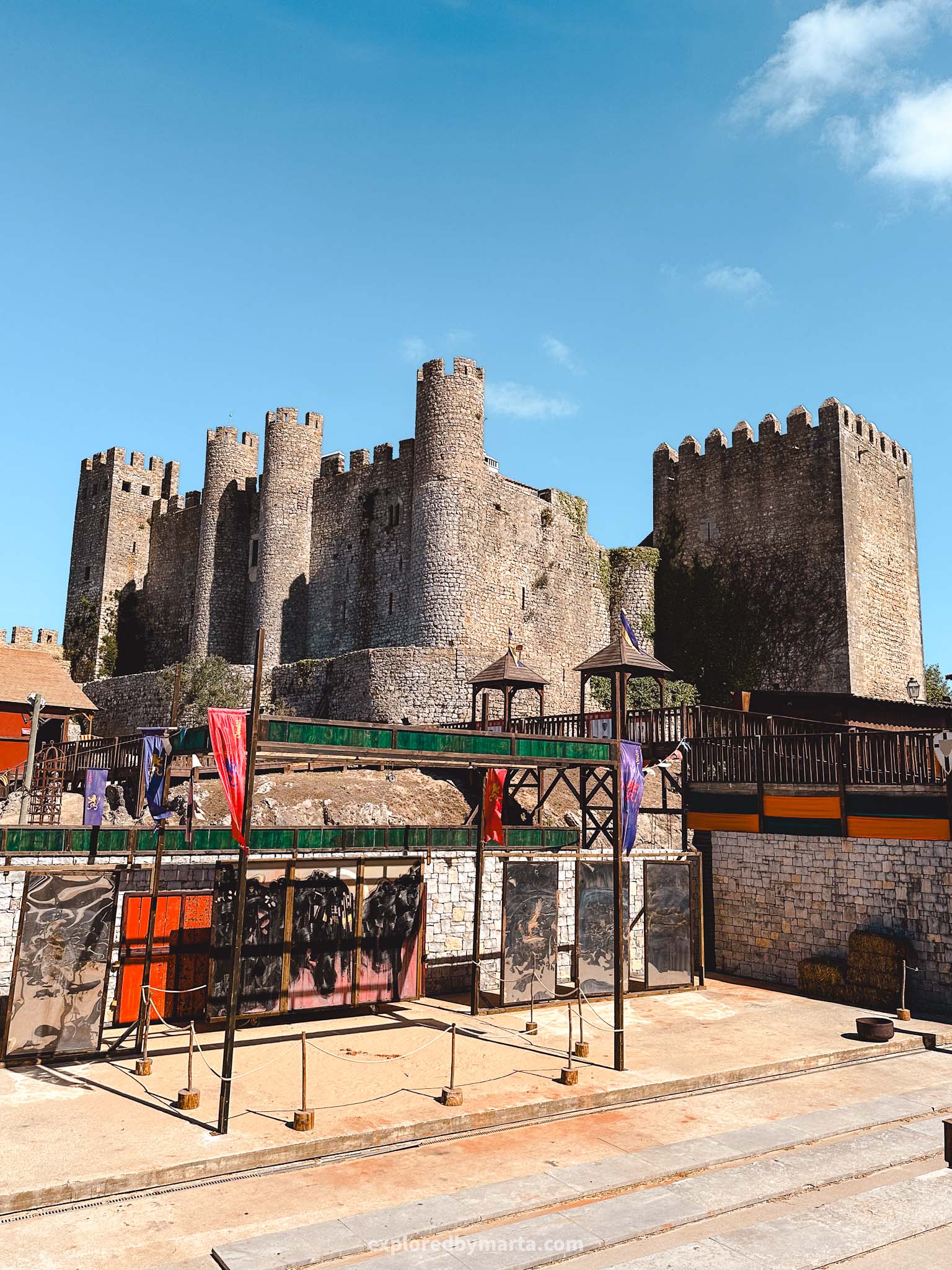
It is part of a hotel network in Portugal called ‘Pousadas de Portugal’, where historic state-owned buildings (like castles and palaces) are turned into hotels. This helps the state earn income to maintain the old buildings.
Óbidos Castle also hosts medieval shows and activities. It looked like a fun place with medieval singing, different tools and arms, some food, and other activities. We tried a typical Portuguese lemonade in a special clay pot in the shape of a castle tower, haha!
After the visit to the castle, we climbed up to the defensive walls and walked around the whole town. Definitely a must-do thing when visiting Óbidos!
Location: Castle of Óbidos
6. Mafra National Palace
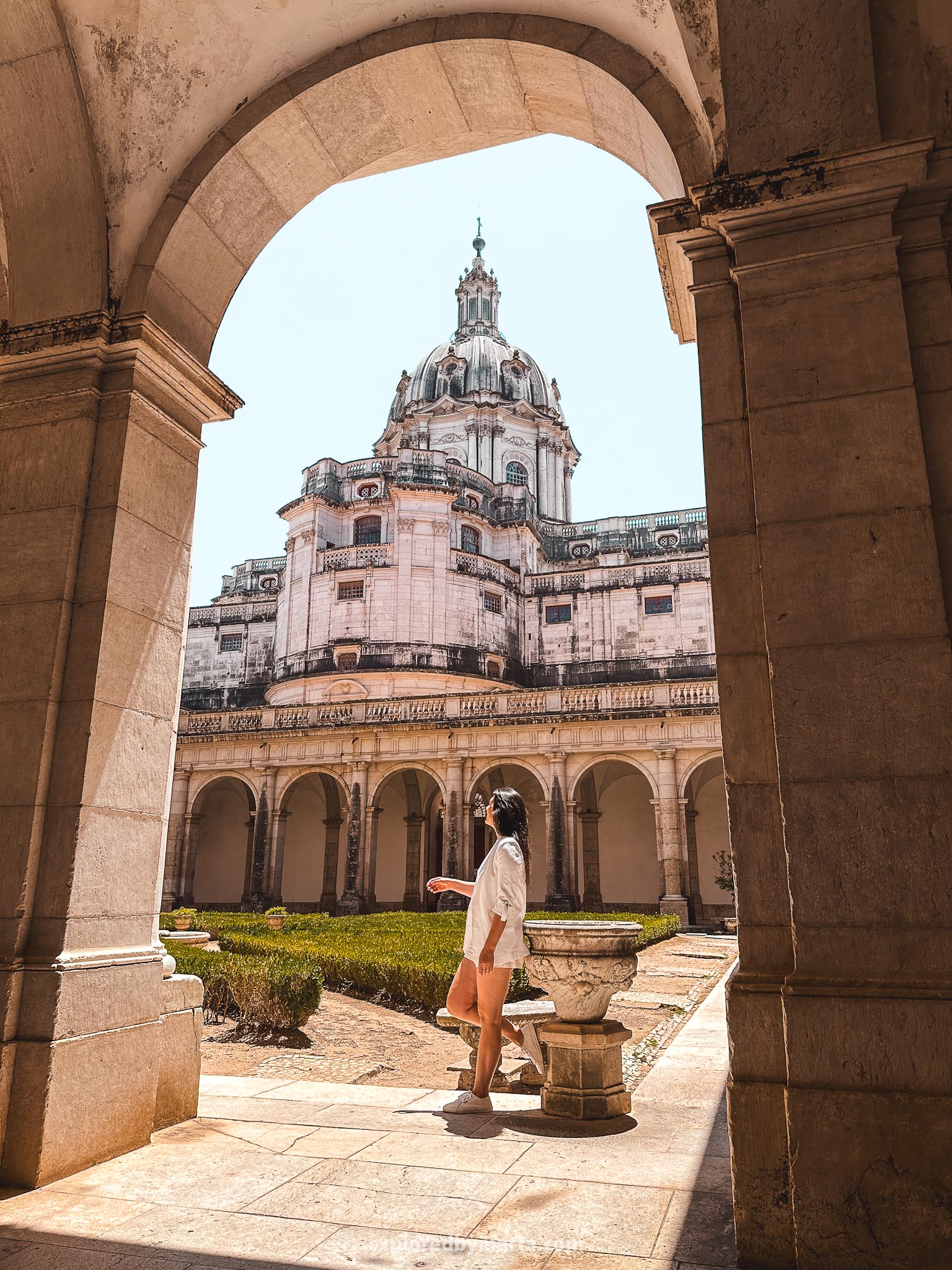
Located in Mafra city, about a 40-minute drive away from Lisbon, Mafra National Palace is a crown jewel amongst all the palaces and castles in Portugal!
This incredibly massive palace with a basilica and a monastery is one of the best places to visit in Portugal and one of the most beautiful palaces you will find near Lisbon!
The monumental Mafra National Palace was built back in the 18th century and today is one of the largest palace complexes in the country. It boasts a Baroque and Neoclassical architecture and is listed as a UNESCO World Heritage Site.

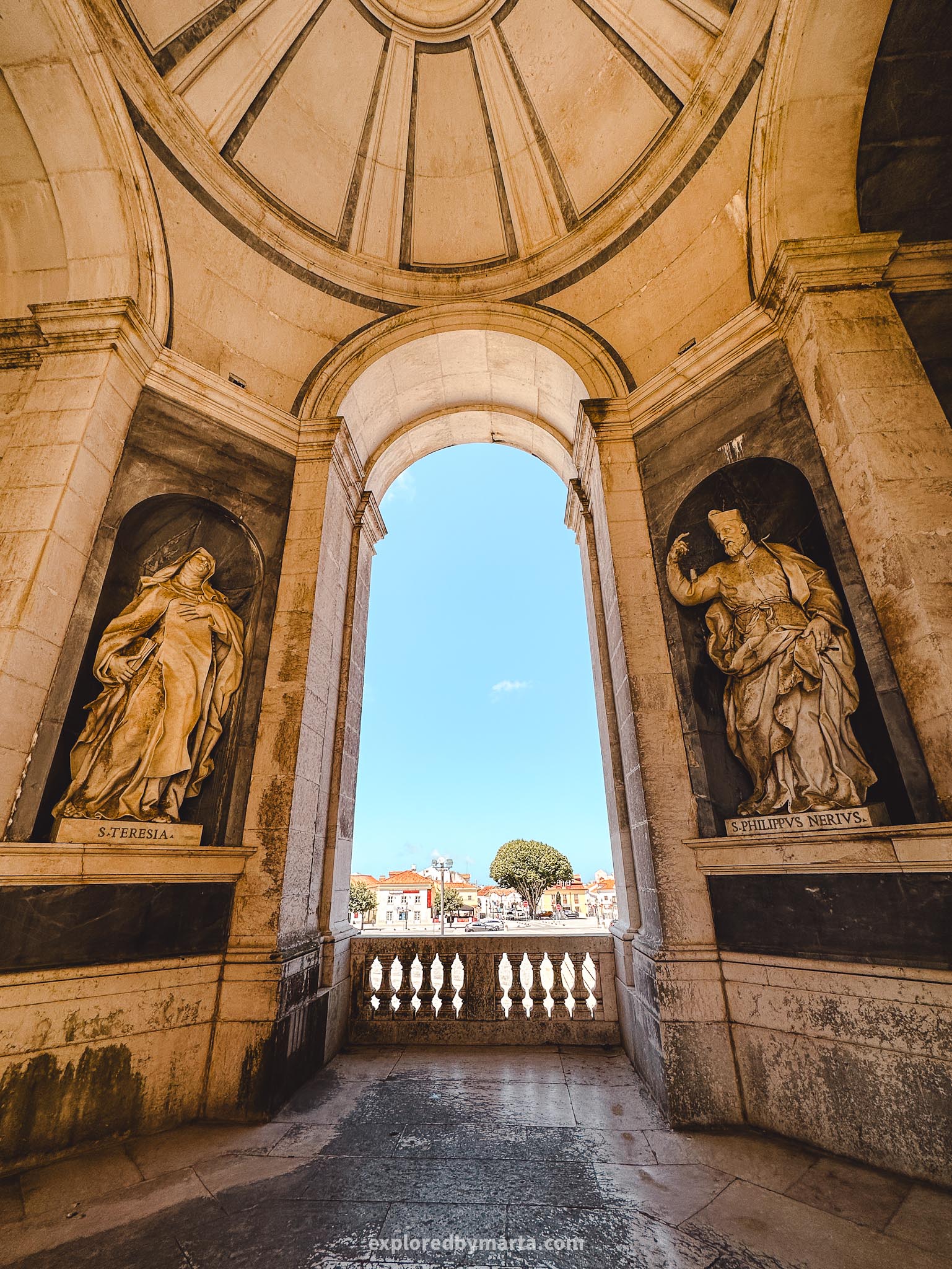
The palace complex includes 1,200 rooms, halls, and 156 stairways, as well as a large library with over 30,000 rare books. It really is huge!
The library is actually famous for housing bats, which protect the books from insects.
The central part of the building is a basilica with the royal palace stretching to both sides of it. The impressive facade is 220 meters long. However, behind the main facade hides a monastery with cells for about 300 monks.


A visit to the basilica is free, but there is an entrance fee if you want to explore the palace and the monastery (which you definitely should!).
Visits take place individually, however, there is a designated route that takes you through all the halls and rooms, including the monastery and the famous library. It’s a maze!
I thought we would never get through that building in a day, haha, but somehow we managed to do that! It isn’t the most glamorous palace in Portugal, but I’m glad I got to visit this place because of its historic importance!


The Palace of Mafra was the final residence of the last king of Portugal, Manuel II, who left the palace to go into exile on 5 October 1910 after it was announced that the monarchy was overthrown and Portugal was now a republic.
If you ever get to visit the Mafra National Palace, just know that it won’t be a quick stop if you want to see the palace with its iconic library and all the rooms in the monastery part!
It took us around 1 or 2 hours at a quick pace to see all the rooms and halls, so it will definitely be a couple of hours if you don’t rush as we did. There’s just so much to see, and you have to walk hundreds of meters around the palace!
Location: Mafra National Palace – Entrance tickets
7. Sintra National Palace
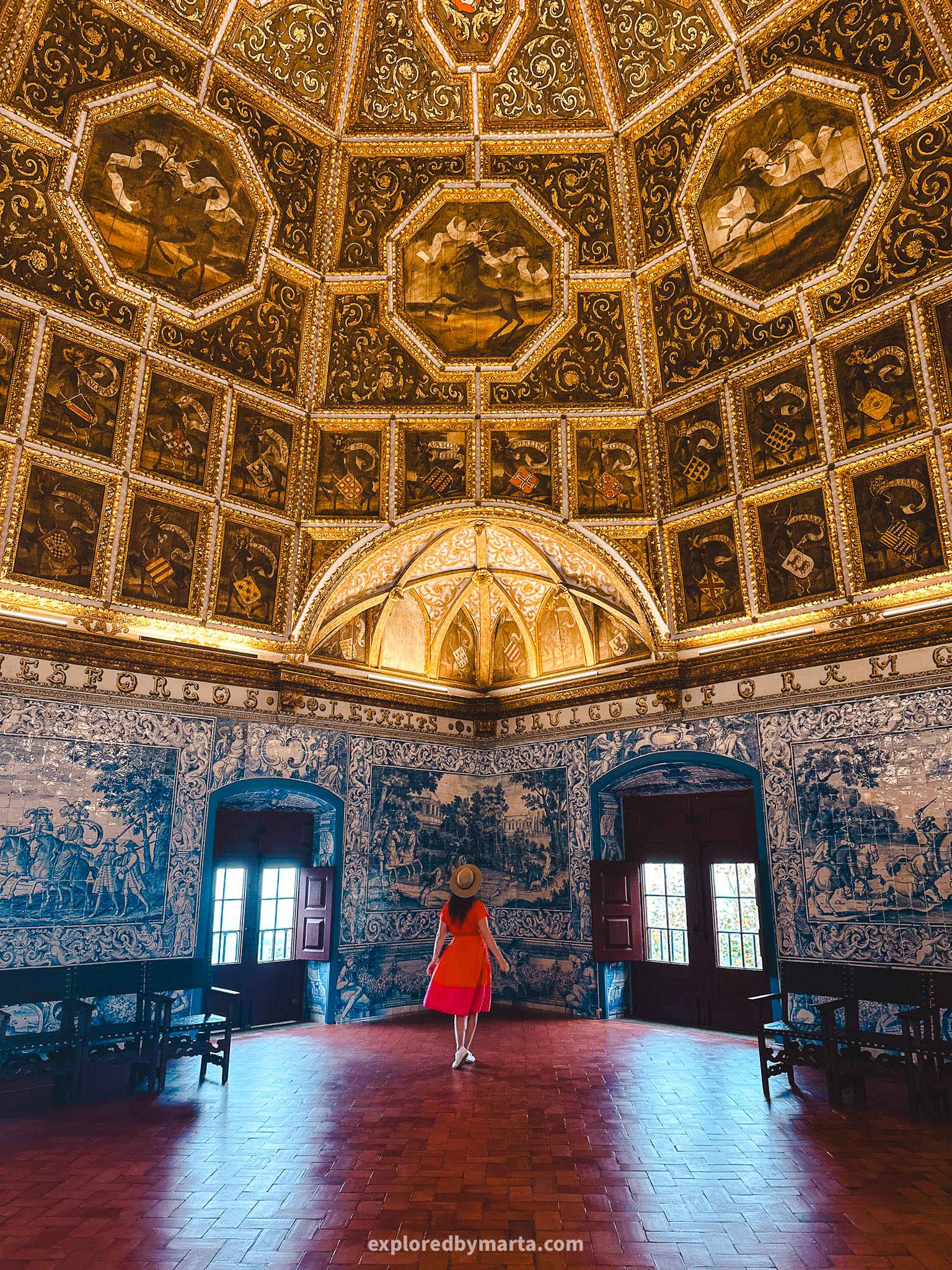
Did you think we were done with Sintra? No.
Although Sintra National Palace is not as well-known as some other castles and palaces in Sintra, it is definitely one of the most historically significant palaces in Portugal.
Sintra National Palace is considered the best-preserved medieval residence of Portuguese royalty in the whole country.
And do not mistake it with the famous Pena Palace! This one – Sintra Palace – is located inside the old town, but the one sitting on top of a hill is Pena Palace!

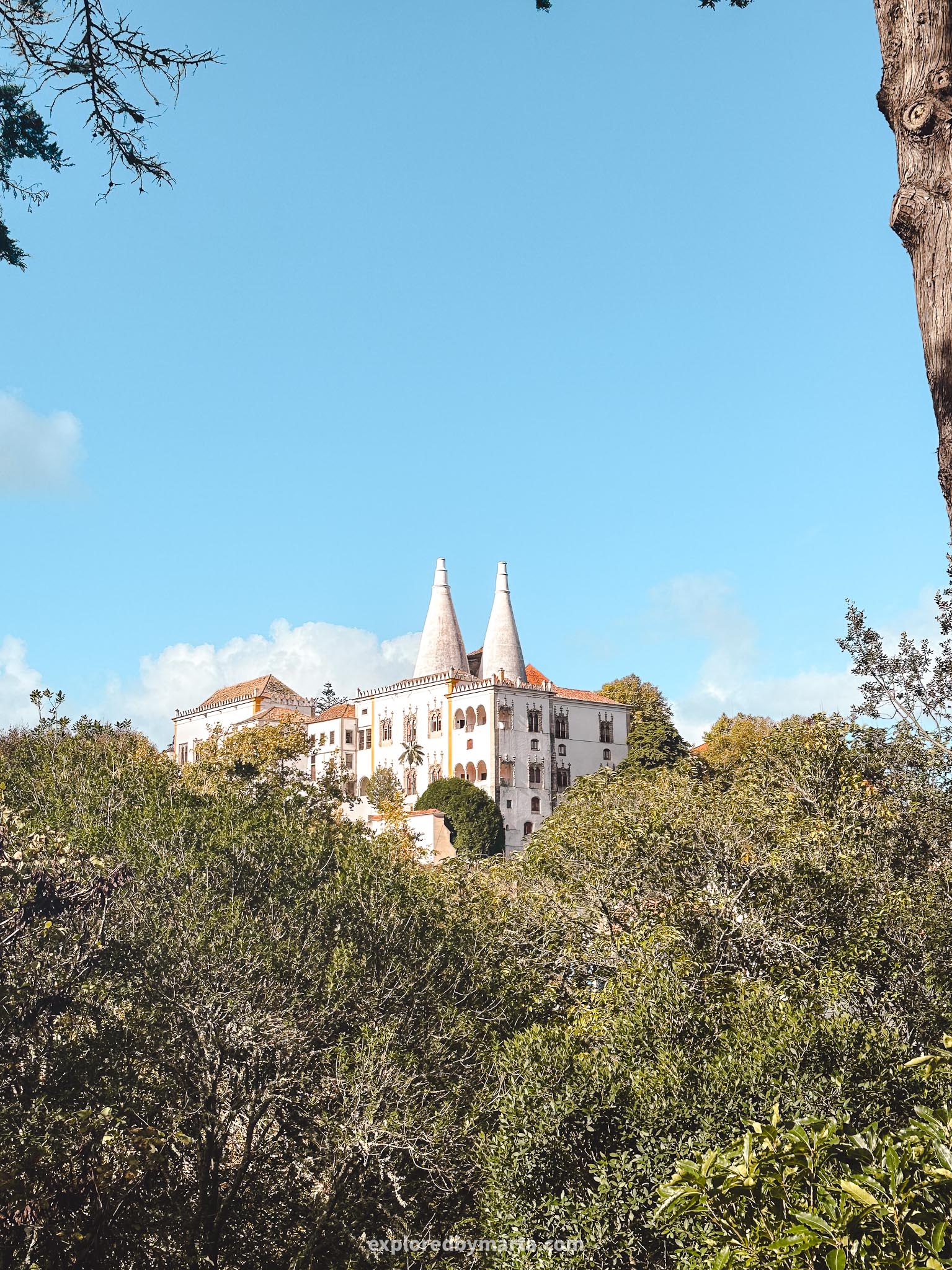
Despite being less known, I’m glad we got to visit Sintra National Palace. There’s so much to see!
The royal residence stands out with its two gigantic conical chimneys rising above the palace’s kitchen into the skyline of Sintra. It is believed that the first foundation of the building complex was built in the 10th century, making it the oldest palace in Portugal.
However, the palace as we see it today was built, shaped, and redesigned over the next centuries. Practically every king and queen of Portugal has spent some time in this palace, leaving a rich mix of architectural and cultural heritage.
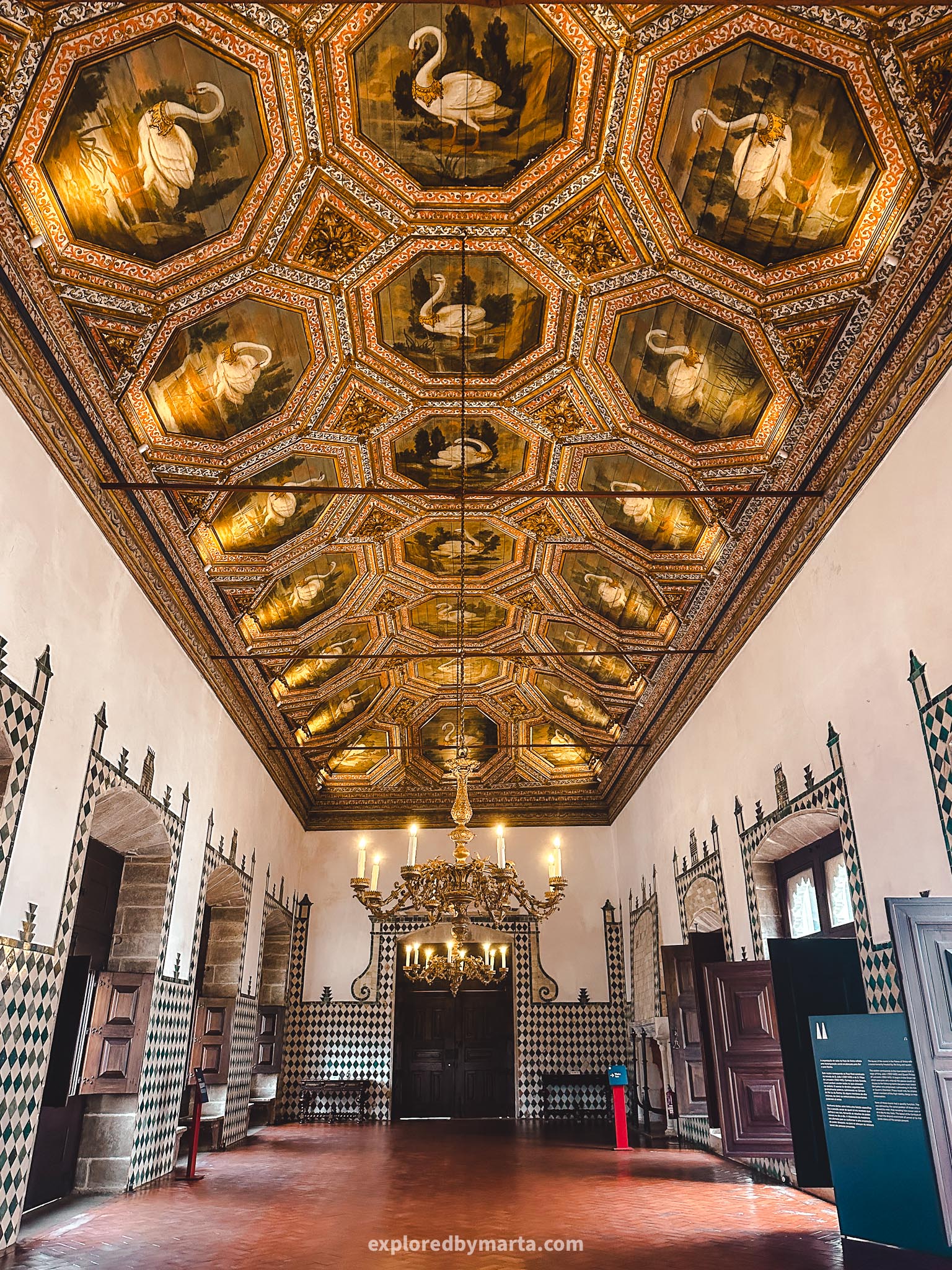
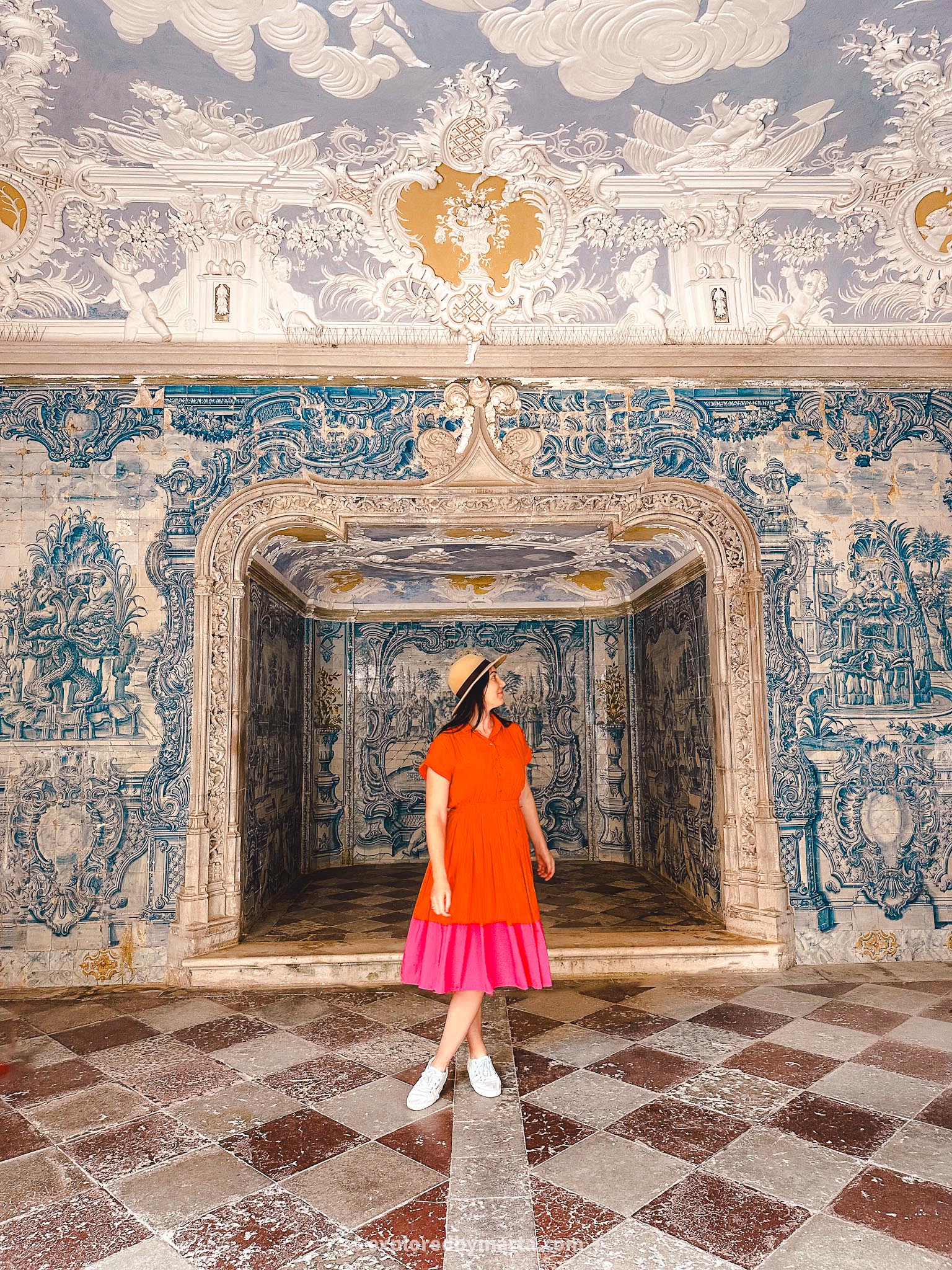
The palace is truly massive, and most of what we see today was created during the 15th-16th centuries. For me, the place that stood out the most was Sala dos Brasões or Coat of Arms Room (first photo).
The impressive room is the most beautiful spot in Sintra Palace. It is a large 13-by-14-meter room proudly boasting walls covered with painted Portuguese tiles and a high golden ceiling with paintings of 72 coats of arms of Portuguese noble families.
I also loved The Swan Room as well as the inner courtyard with a nook full of beautiful Portuguese ‘azulejos’ tiles and paintings on the ceiling. If you have an extra hour to spend in Sintra, I recommend paying a visit to this historic palace!
Location: Sintra National Palace – Entrance Tickets
8. Quinta da Regaleira
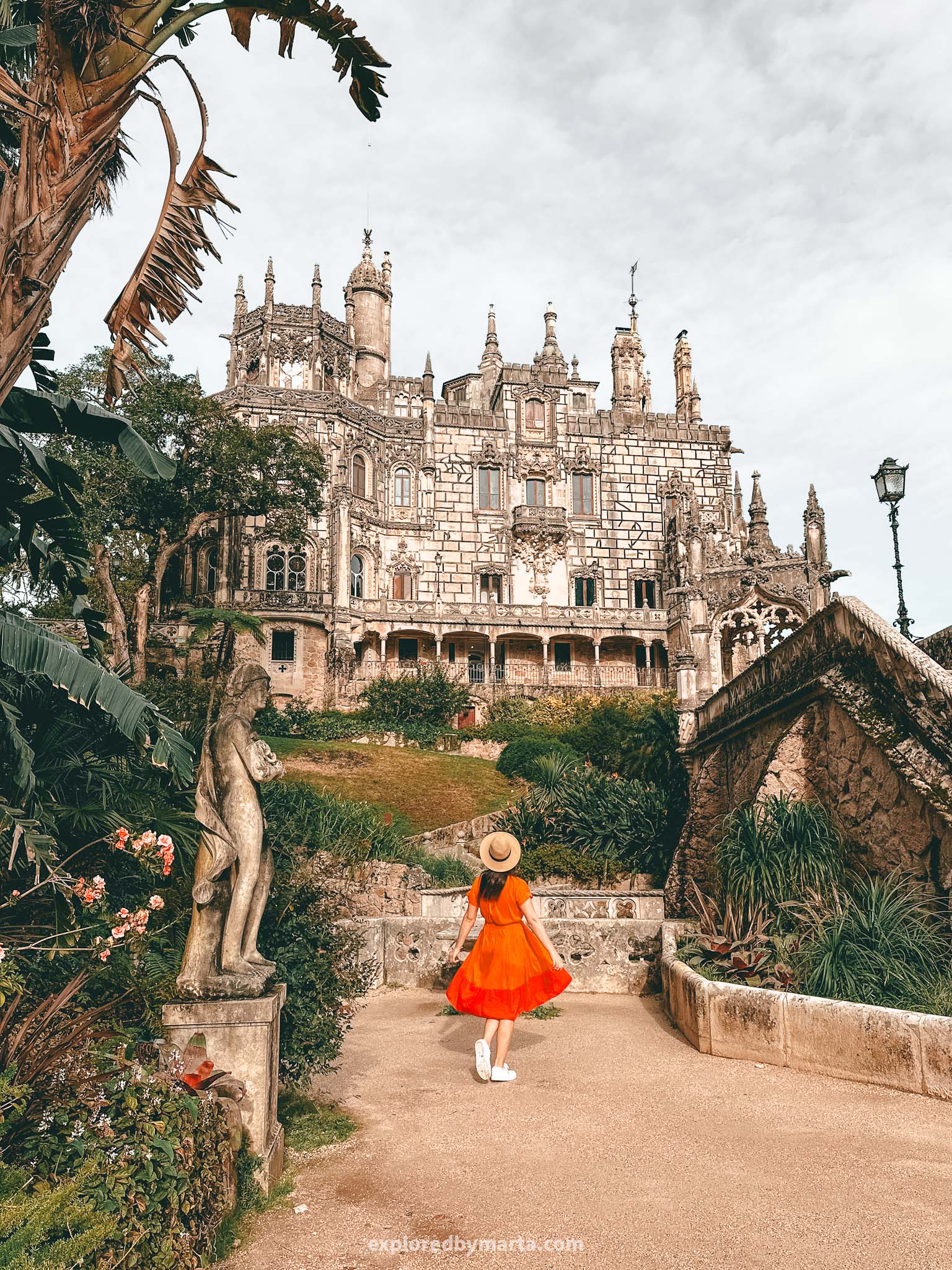
Ok, this is really the last one in Sintra!
Designed by an Italian architect, the spectacular Quinta da Regaleira or Regaleira Palace is one of the landmark tourist attractions in Sintra. It is a stunning early 20th-century palace with vast gardens, lakes, fountains, and underground passages.
The Romantic-style palace stands out with its Gothic-style pinnacles, towers, and gargoyles. While the Pena Palace with its colors looked fun and princessy, the moody and dark grey Quinta da Regaleira kind of feels more like the villain’s castle you see in cartoons.


The spectacular palace incorporates a beautiful mix of Gothic, Renaissance, Manueline, and Roman styles. However, Quinta da Regaleira is truly famous for only one thing – the Initiation Well (also called the inverted tower).
There are actually two wells, however, only the bigger one has this photogenic spiral staircase with 23 niches inside the wall (see photo above). The well was never used as a water source but instead served for spiritual ceremonial purposes.
Besides the Initiation Well, there are many other cool spots to explore! After visiting many palaces and castles in Sintra, I can safely say that Quinta da Regaleira gardens are easily the most extravagant and luxurious of all the properties we visited!
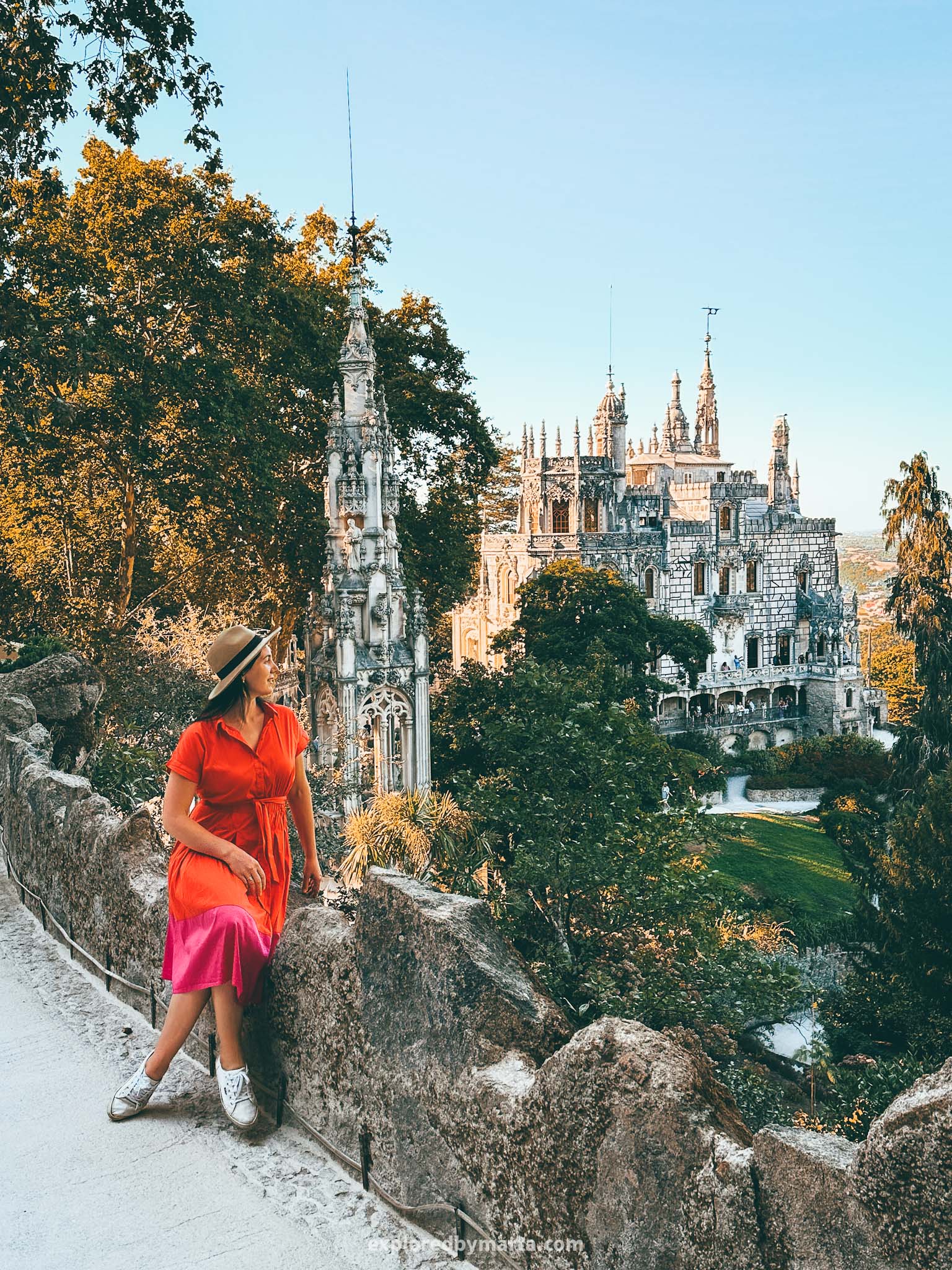
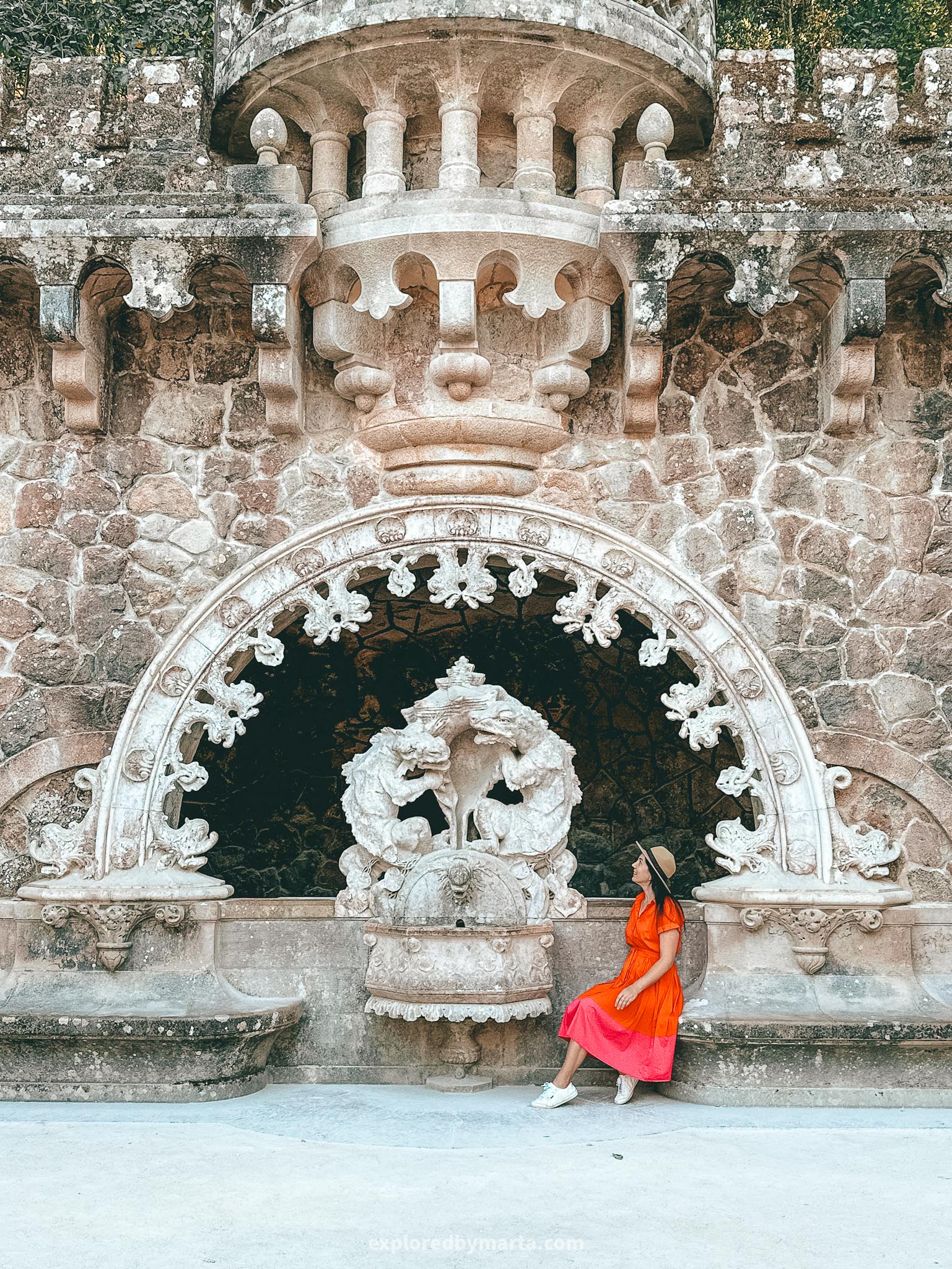
The terraced gardens feature beautiful viewpoints, lakes, scenic benches, towers, fountains, statues, and bridges, as well as a chapel and a large collection of plants, bushes, and trees. Almost got lost in the winding network of paths, haha!
We visited Quinta da Regaleira in early November, bought our tickets in advance, and arrived at the entrance 30 minutes before opening time, so we could be the first ones to enter. When the palace opened, the line behind us was already massive!
Quinta da Regaleira palace is located very close to the Sintra Historic Center, so it is easy to reach on foot. We stayed in Sintra town, not too far away, so we just walked there. It’s an easy walk and only goes slightly uphill, but you can also catch a tuk-tuk or a taxi.
Location: Quinta da Regaleira – Initiation Well
9. Castelo de Leiria

Leiria Castle is a beautiful and picturesque medieval castle built in the 12th century by the order of King Afonso I, the first king of Portugal, to protect, at that time, the Southern border of his country.
Throughout the centuries, it has served as the residence for Portuguese monarchs and played a strategic role in the defense of the country.
Today, the iconic castle is accessible to the public, where you can step back in time and explore one of the most iconic medieval attractions in the country.

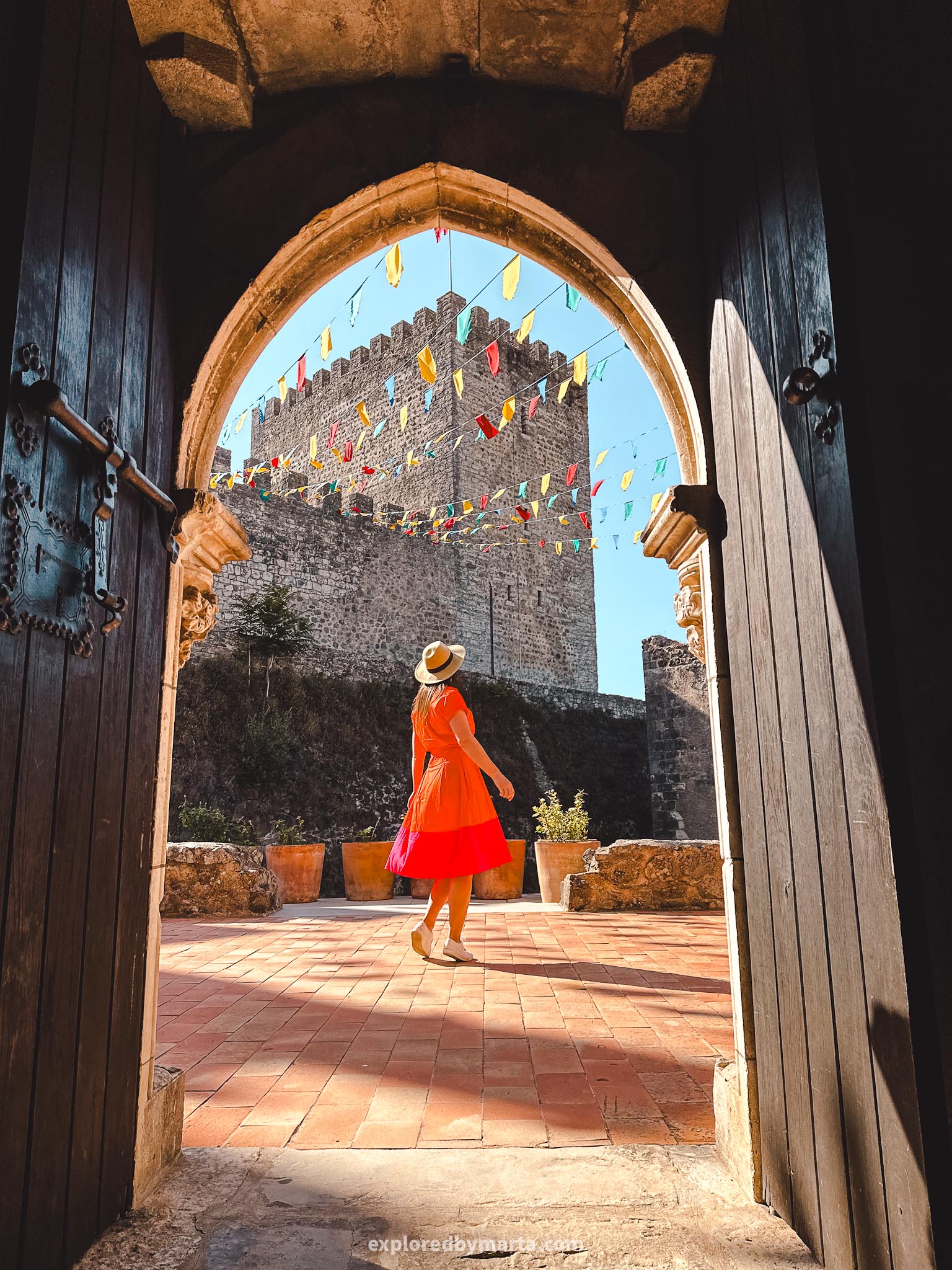
There are a couple of legends involving the castle – one of them claims that there is a dormant volcano under the castle that is responsible for heating the water in the hot spring.
Another legend says that one winter morning, the queen left the castle to distribute bread to poor people in Leiria. When the king inquired about her plans and what she was hiding in her clothes, the queen said that there were roses.
So when the king seemed surprised that she would carry roses in January, the queen then revealed her clothes, and there were indeed roses instead of bread that she had hidden there.
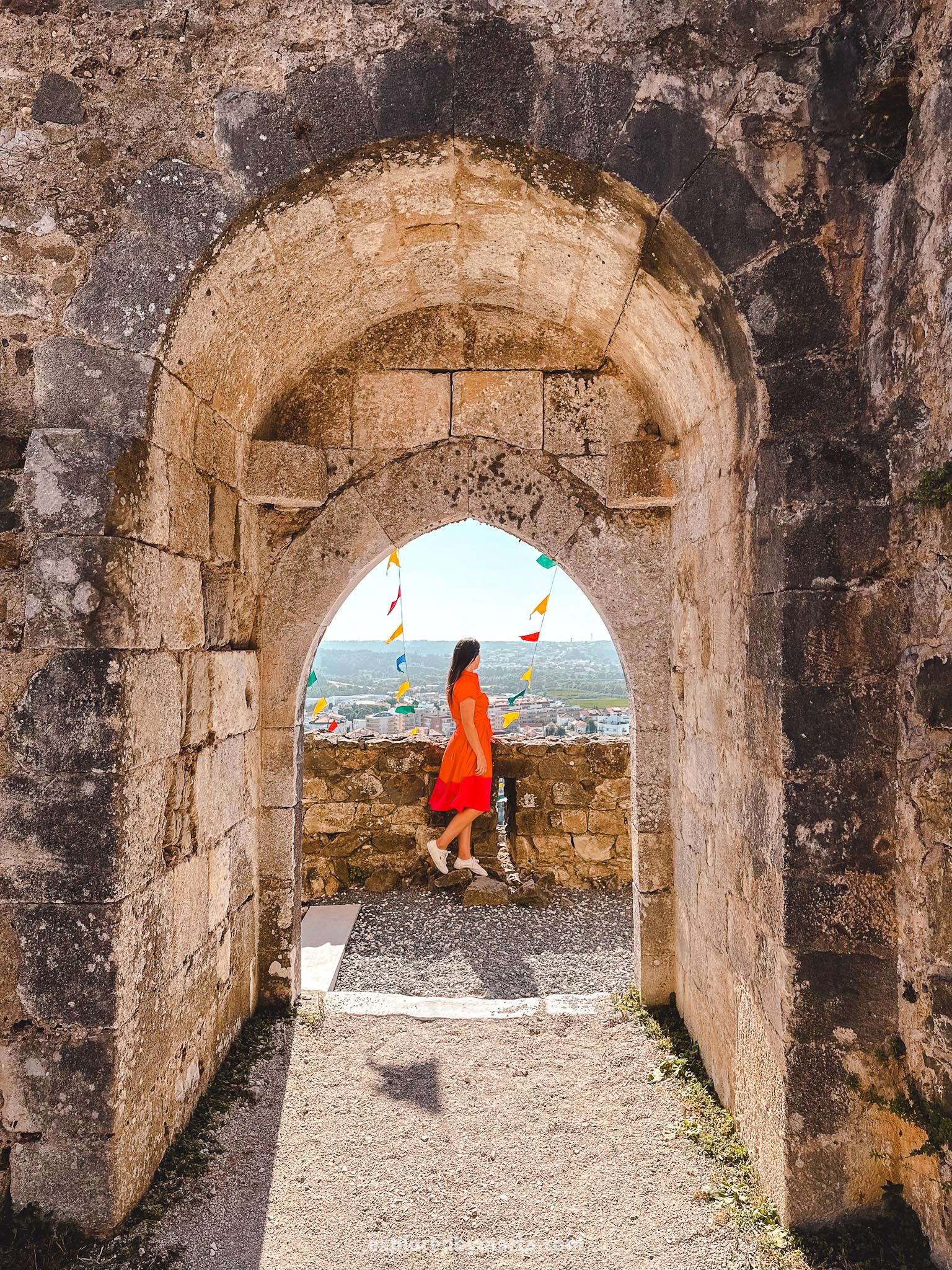
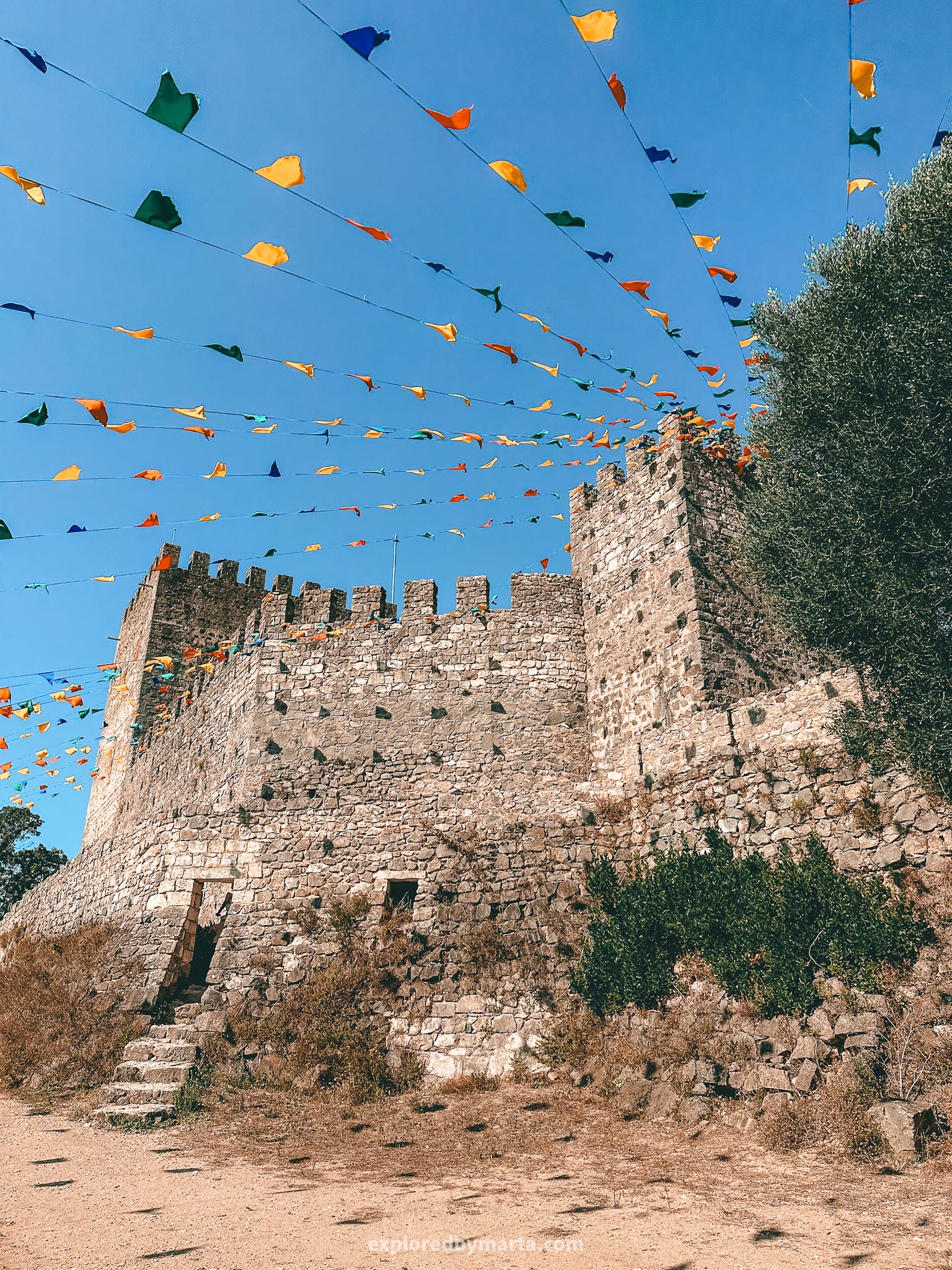
The Castle of Leiria is located in Leiria city, a 1h 30min drive from Lisbon. Each year, Leiria hosts a Leiria Medieval Fair – a big medieval festival where the whole city is turned into a medieval-themed playground. One of the best places to be for history lovers!
If you happen to be around during those days, I highly recommend paying a visit to Leiria and the castle, as everything will be beautifully decorated and there will be medieval celebrations throughout the city.
We happened to be there a day before the festival started, so we saw different performances, everything in festive colors, and a city full of medieval markets and street food stands. Sadly, we could not stay longer, but it definitely looked quite fun.
Location: Castelo de Leiria
10. Queluz National Palace
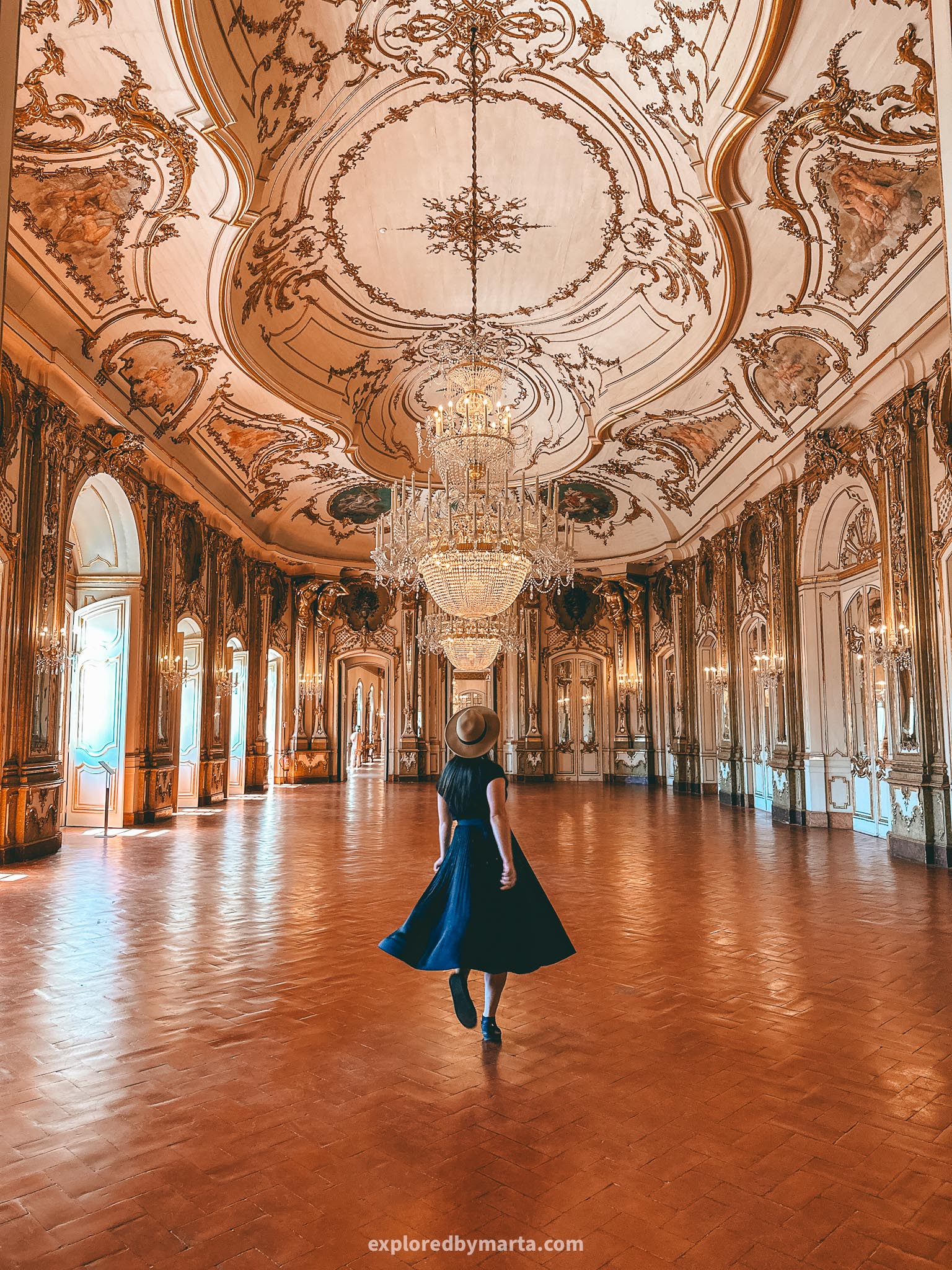
The glamorous 18th-century Queluz National Palace is amongst the last major Rococo buildings designed in Europe and served as a residence and a retreat for many different members of the Portuguese royalty.
Although it was built as a place for leisure and recreation for the Portuguese royal family, at times it became an official residence for some members of the monarchy.
Today, Queluz National Palace is a member of the European Royal Residences Network.
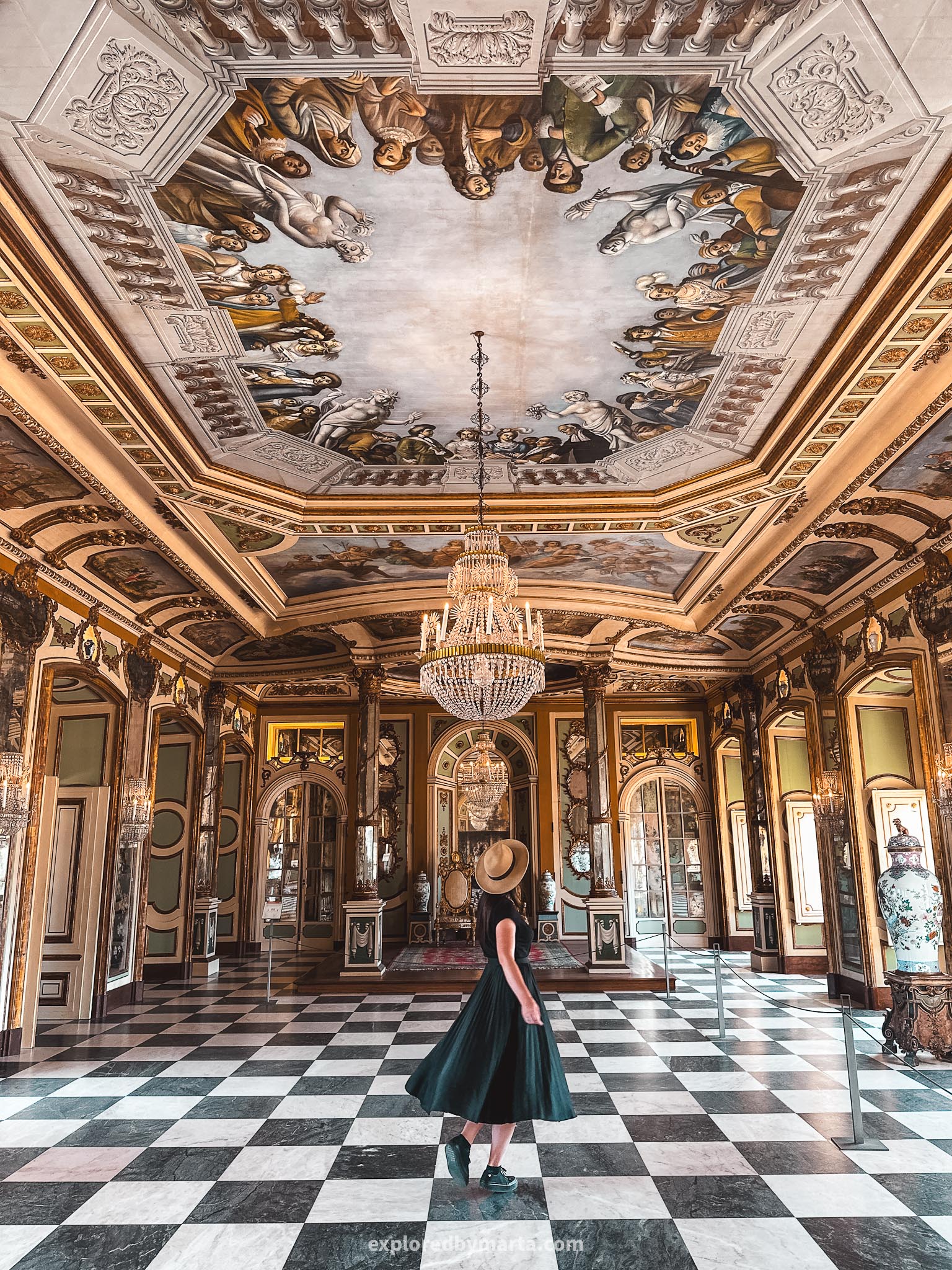

The Palace of Queluz is often referred to as the ‘Portuguese Versailles’. Founded by Queen Maria I and King Pedro III, the palace displays an abundance of extravagant architecture.
Of all the Portugal’s palaces, this is amongst the most beautiful ones for sure!
I loved wandering around the halls, corridors, and rooms of the extravagant palace. The architecture here was truly majestic! My favorite places inside the palace were the Ballroom, the Hall of Ambassadors, as well as Sala das Mangas gallery with tiled wall panels.
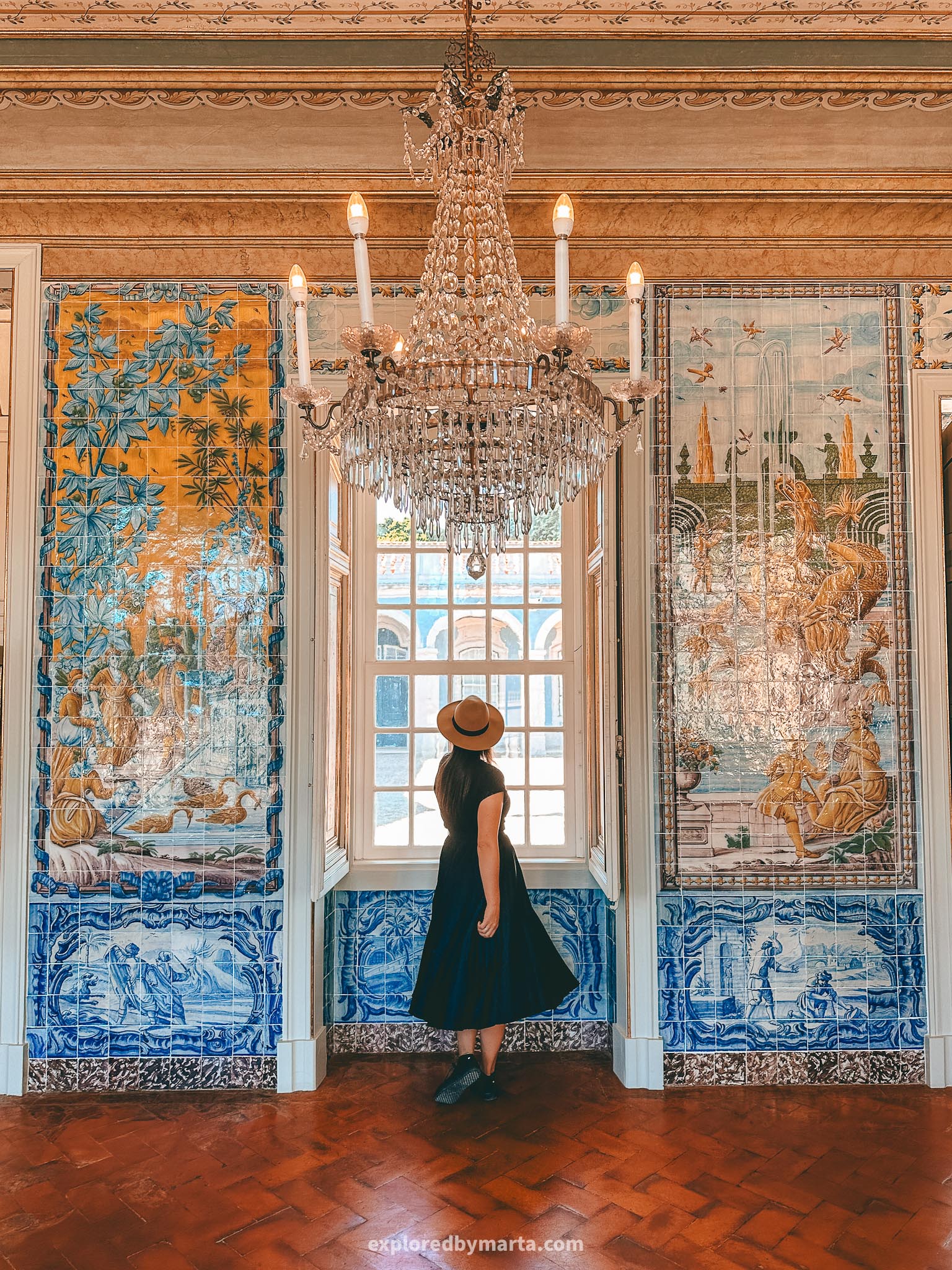

However, it is especially known for its majestic gardens, including the famous Fountain of Neptune. The gardens feature statues, terraces, fountains, as well as a cascade, the first artificial waterfall to be built near Lisbon.
It was pretty hot outside in the sun, but we spent quite some time in the garden – it was so beautiful and we wanted to enjoy it despite the heat!
Queluz National Palace is located in the Sintra municipality, just a 20-minute drive away from Lisbon, making it one of the best historic sites to visit near Lisbon! You can buy entrance tickets online before the visit. This is one fantastic place!
Location: Queluz National Palace – Entrance tickets
11. Castelo de São Jorge
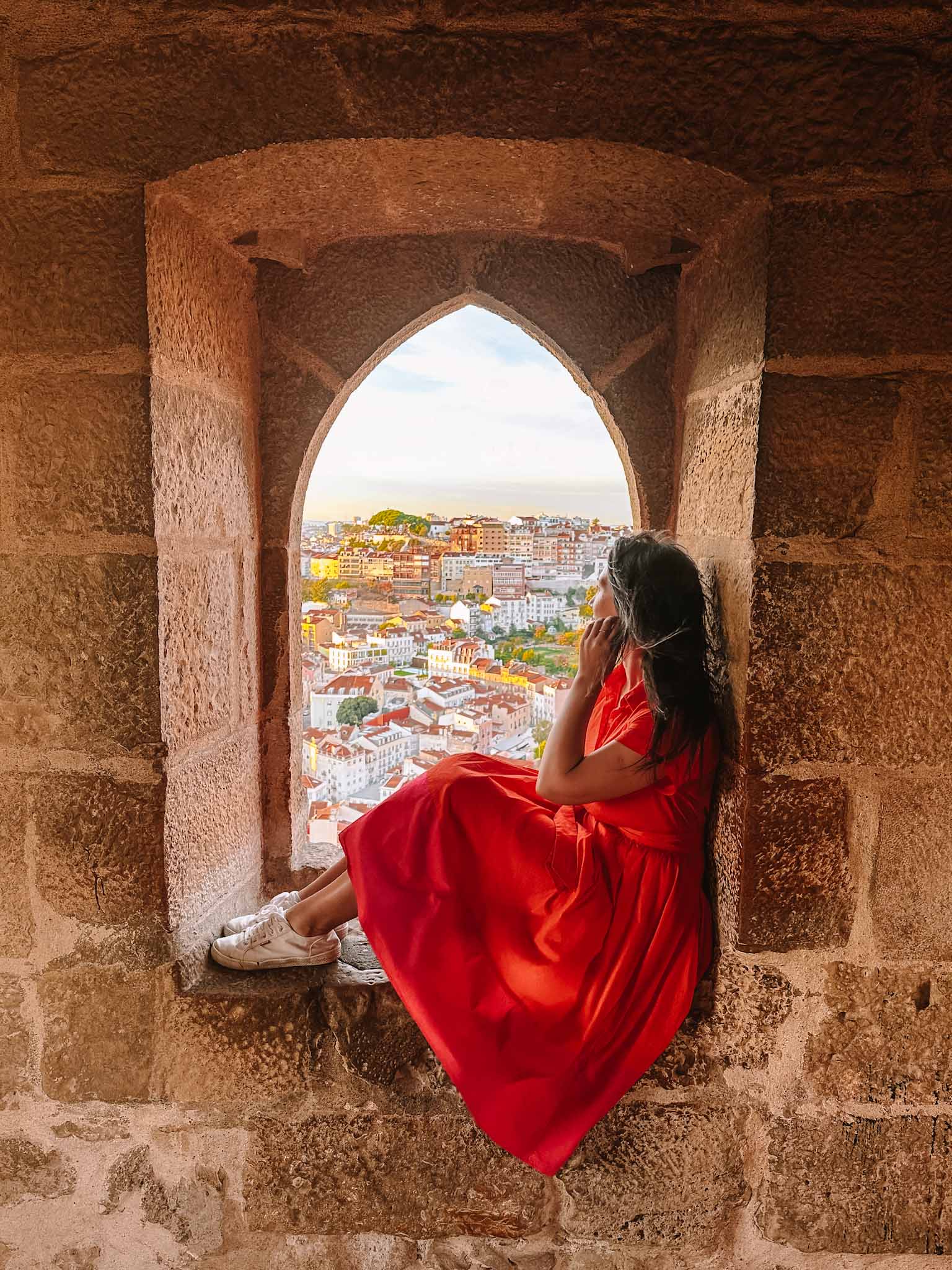
If you are heading to Lisbon during your travels around Portugal (which you should), you don’t have to look far for iconic medieval castles – there is one right in the heart of Lisbon!
When exploring the capital, it is impossible to miss the majestic São Jorge Castle sitting atop a hill right in the city center.
It is one of my favorite places to see Lisbon from above, as well as one of my favorite spots to watch the sunset in Lisbon.


The fortifications of a castle that we see today date back a thousand years, when they were built by the Moorish forces that had occupied the territory of Lisbon.
However, there is evidence that humans lived on the castle hill as far back as the 8th century BC.
São Jorge Castle is one of the bucket list places to visit in Lisbon. During the Middle Ages, this site had a royal palace that was the residence of the kings of Portugal. As of today, not much is left of the castle except the impressive defensive towers and walls.

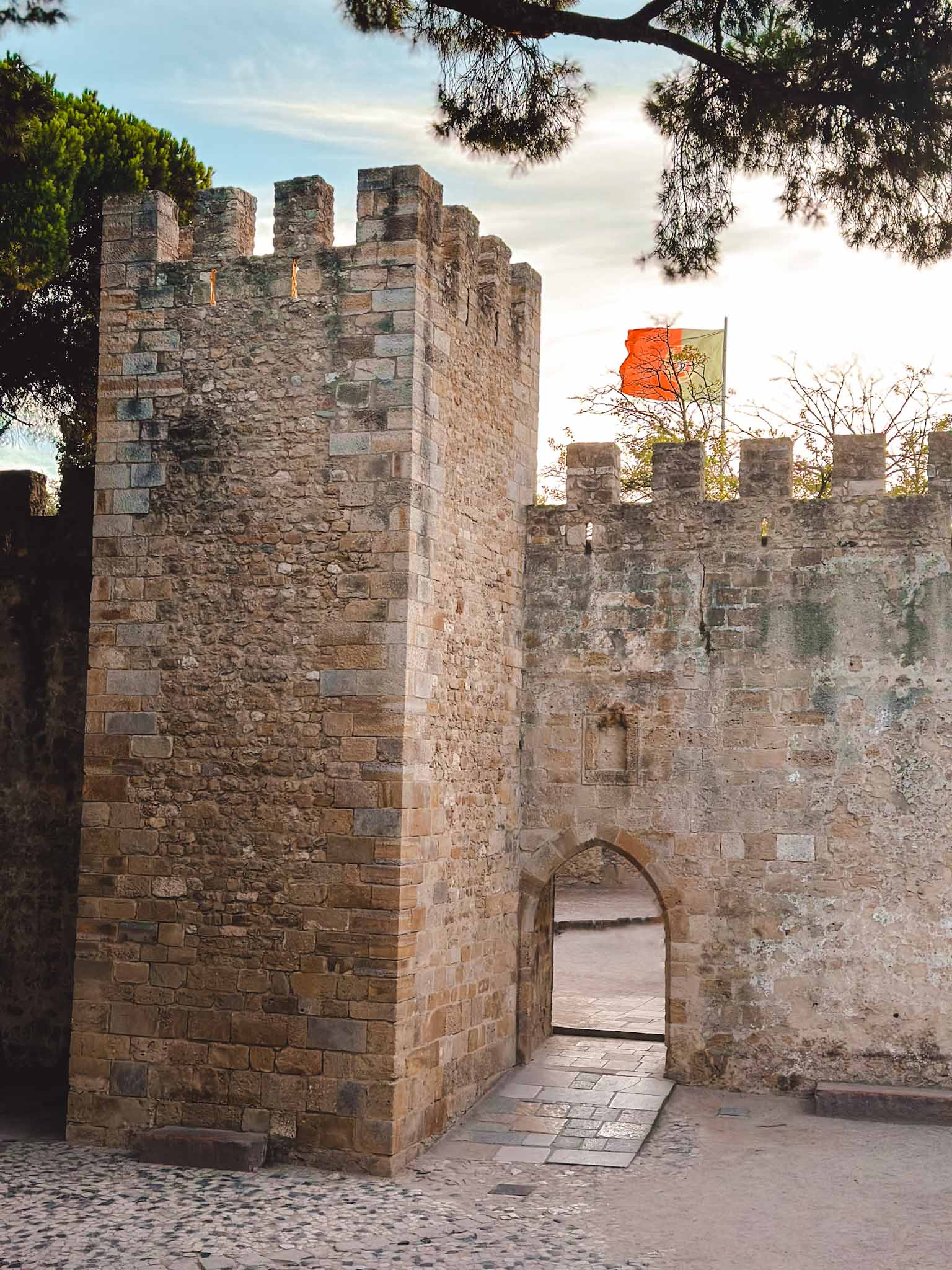
A visit to the castle cost us 11 EUR per person, which is a bit pricey to see the walls of a castle from the Middle Ages, but if you time it around sunset, then you can get some magical golden views over the whole city.
Plus, there are smaller crowds in the evening!
As a castle, it is not as impressive as some of those famous palaces in Sintra, however, if you don’t have much time to wander around Portugal, then this medieval time monument is, indeed, a great place to explore!
Location: Castelo de São Jorge
12. Palace of the Dukes of Bragança
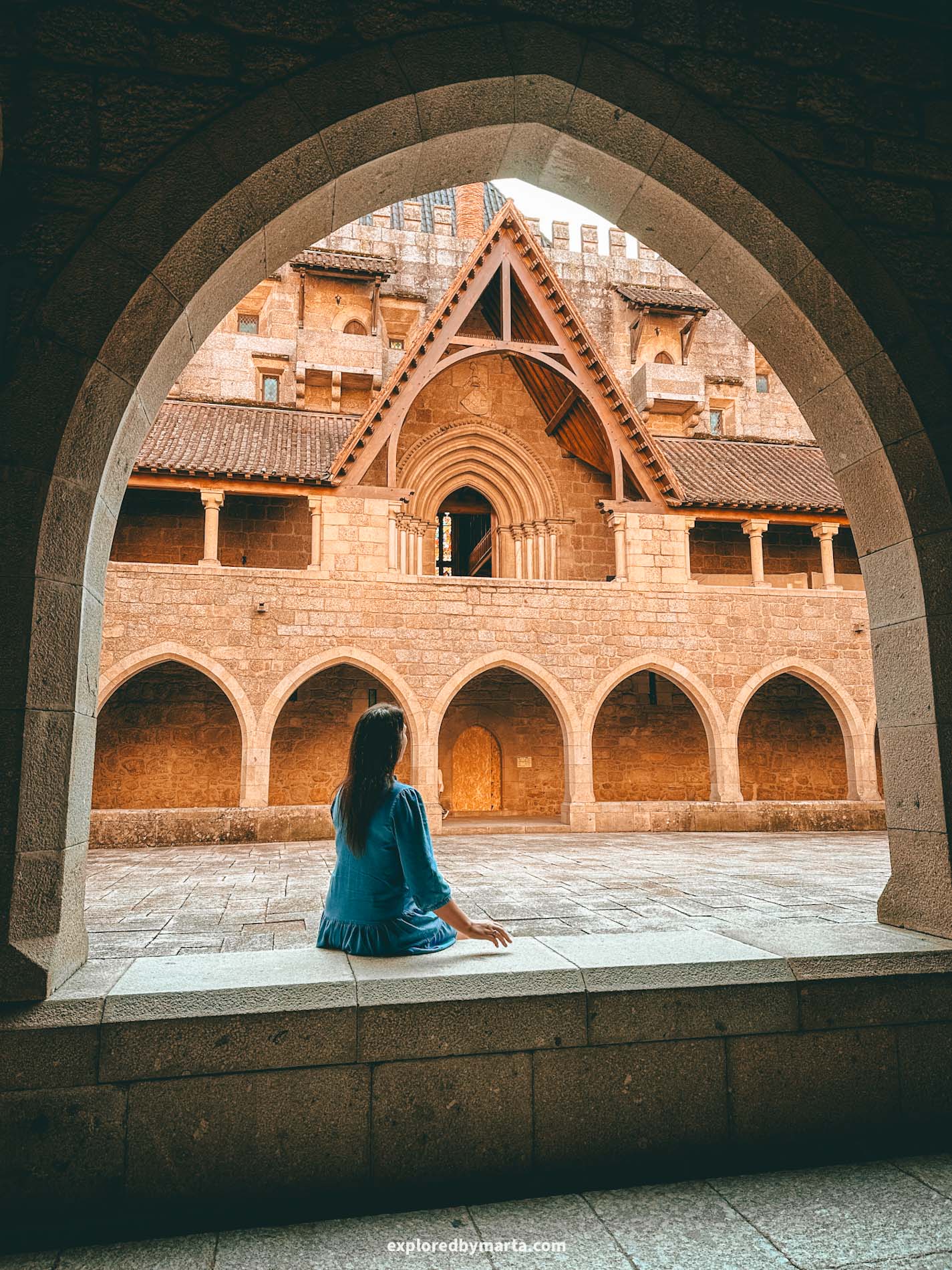
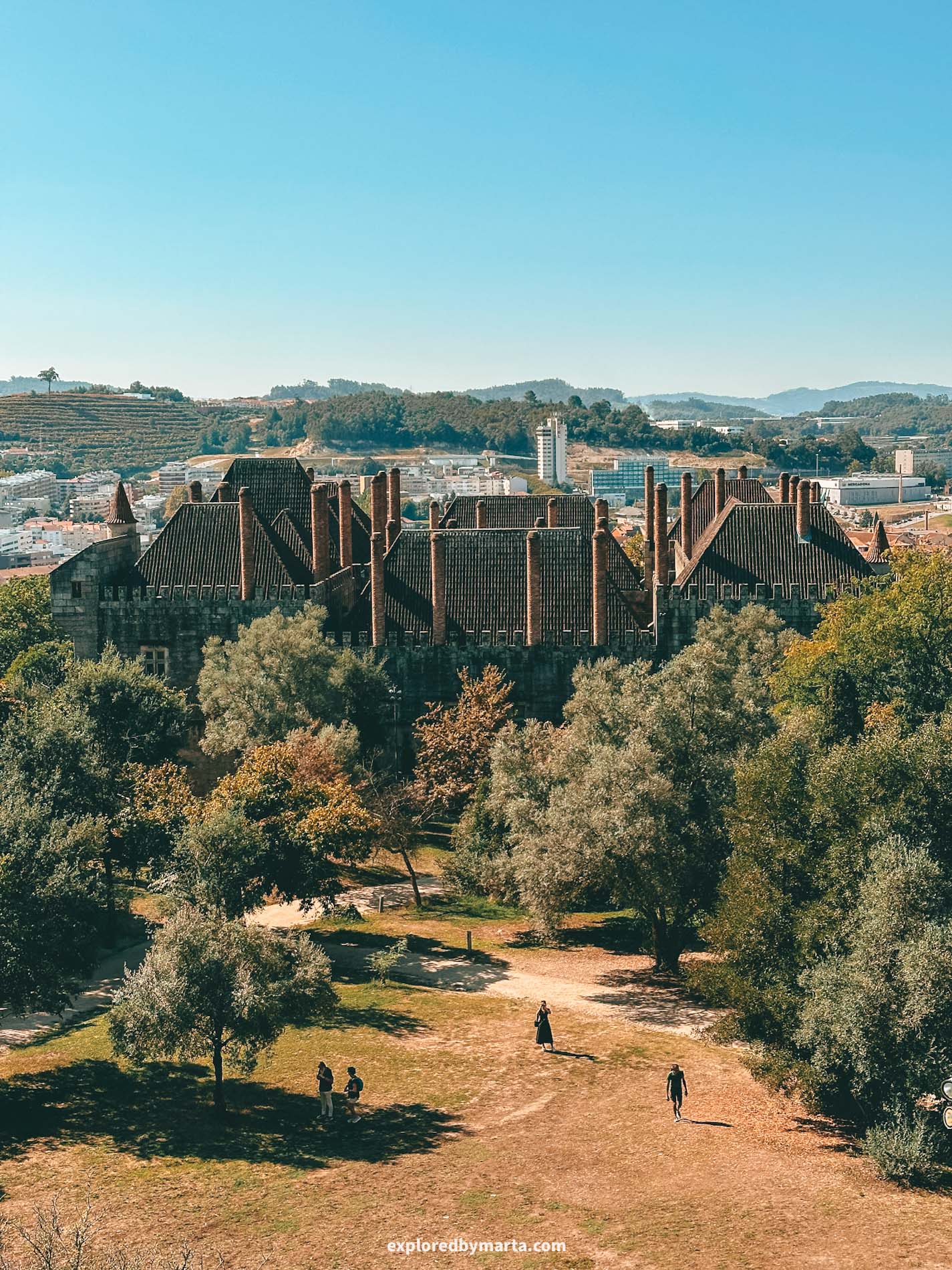
One of the most famous attractions in Guimarães is the majestic Palace of the Dukes of Bragança.
This medieval stone mansion was built in the first half of the 15th century for Afonso, 1st Duke of Bragança (one of the king’s sons), and stands out with its sturdy architecture and very distinctive chimneys towering high above the city.
Tip! If you visit the Guimarães Castle afterward, you’ll see the palace from afar with its countless iconic chimneys (see photo above!).
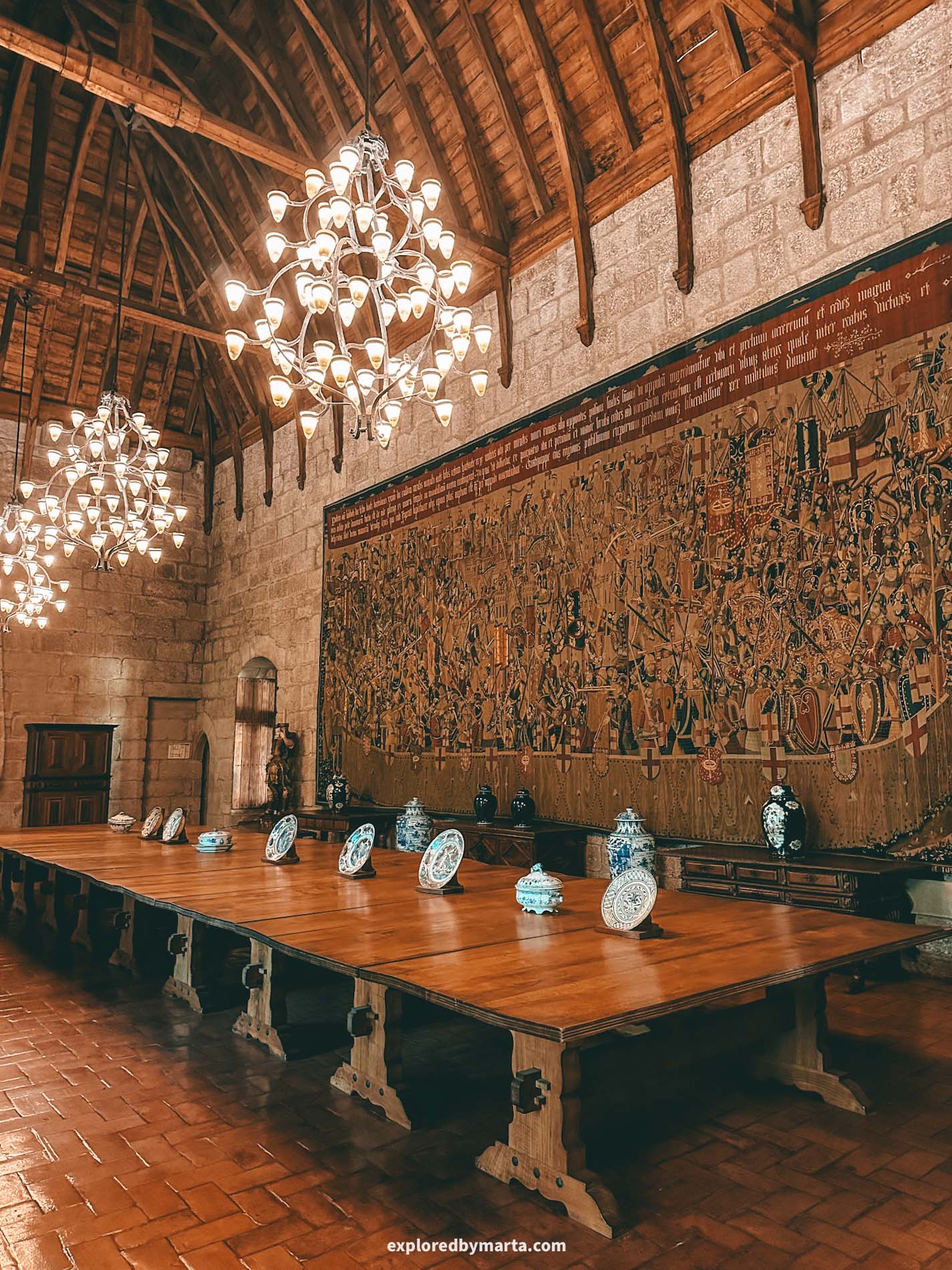
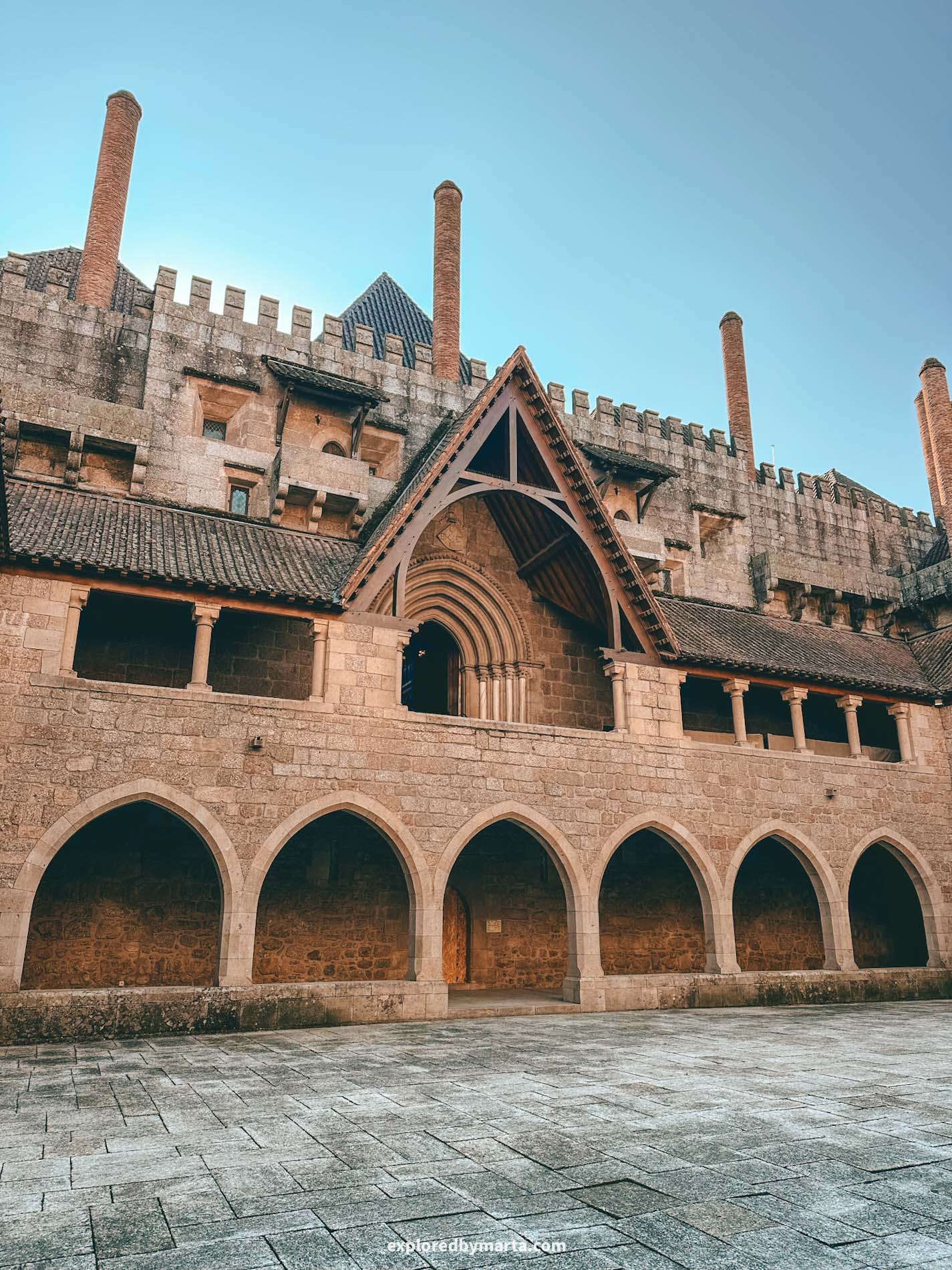
Exploring the majestic Palace of the Dukes of Bragança was one of my favorite things to do in Guimarães. I loved its charming courtyard surrounded by a beautiful arcade and all the stone halls and medieval vibes!
May I say, this grand palace is one of the most beautiful attractions in Northern Portugal, and I took way too many photos here, especially in the courtyard!
If you are into photography and want to take some beautiful photos, make sure to arrive shortly after opening times to beat the crowds!
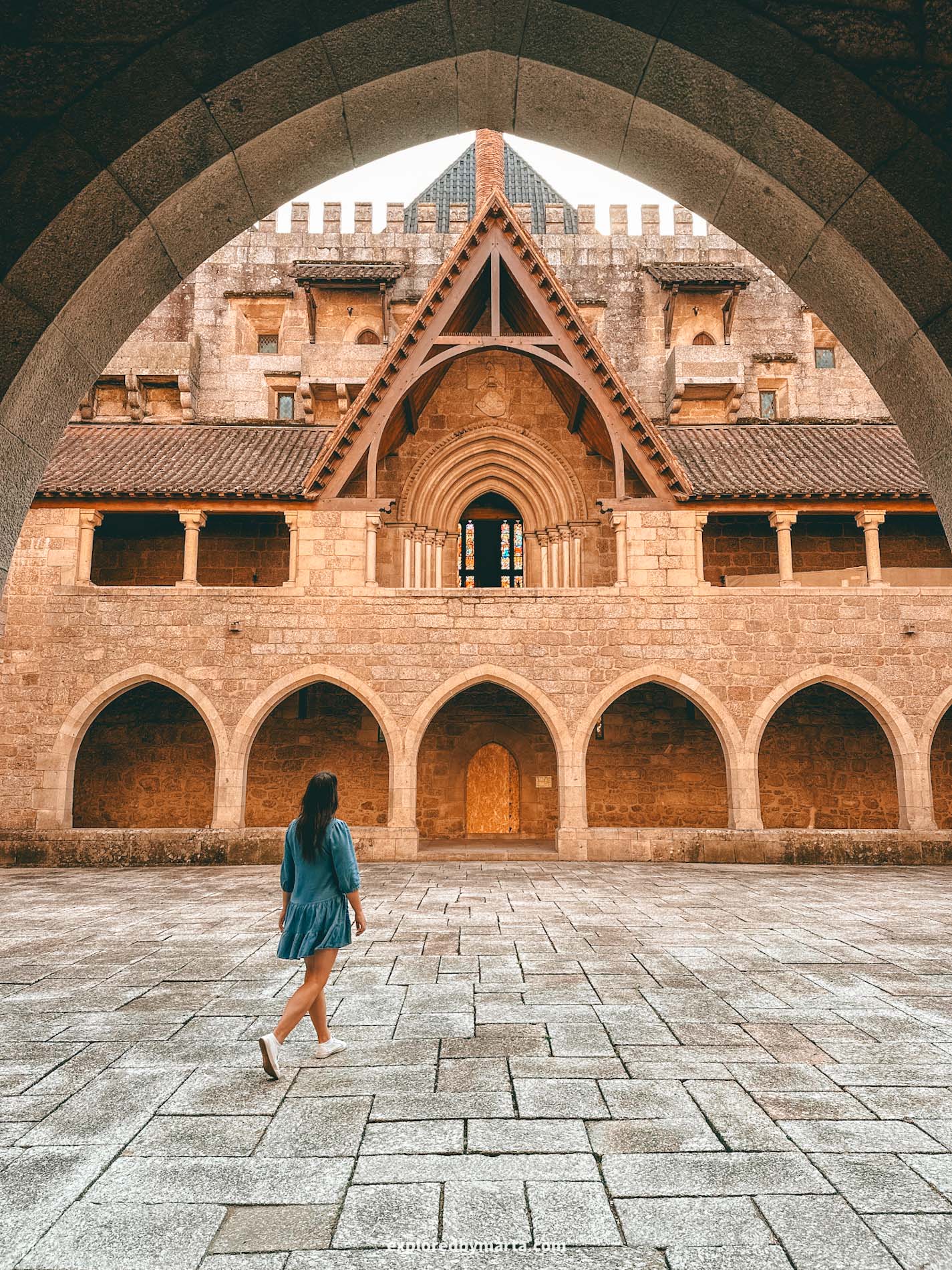

Once we finished exploring the courtyard, we went up to the upper floor to see the actual rooms and halls where they lived.
The rooms were beautifully decorated with rich tapestries, swords, paintings, and period furniture. Some of the massive tapestries showed scenes of some historical Portuguese battles.
Just a note – this isn’t an actual room layout from the 15th century, but rather a remake, because the palace was later significantly renovated and turned into a museum worth visiting. But they did a great job! It did feel like visiting something from medieval times!
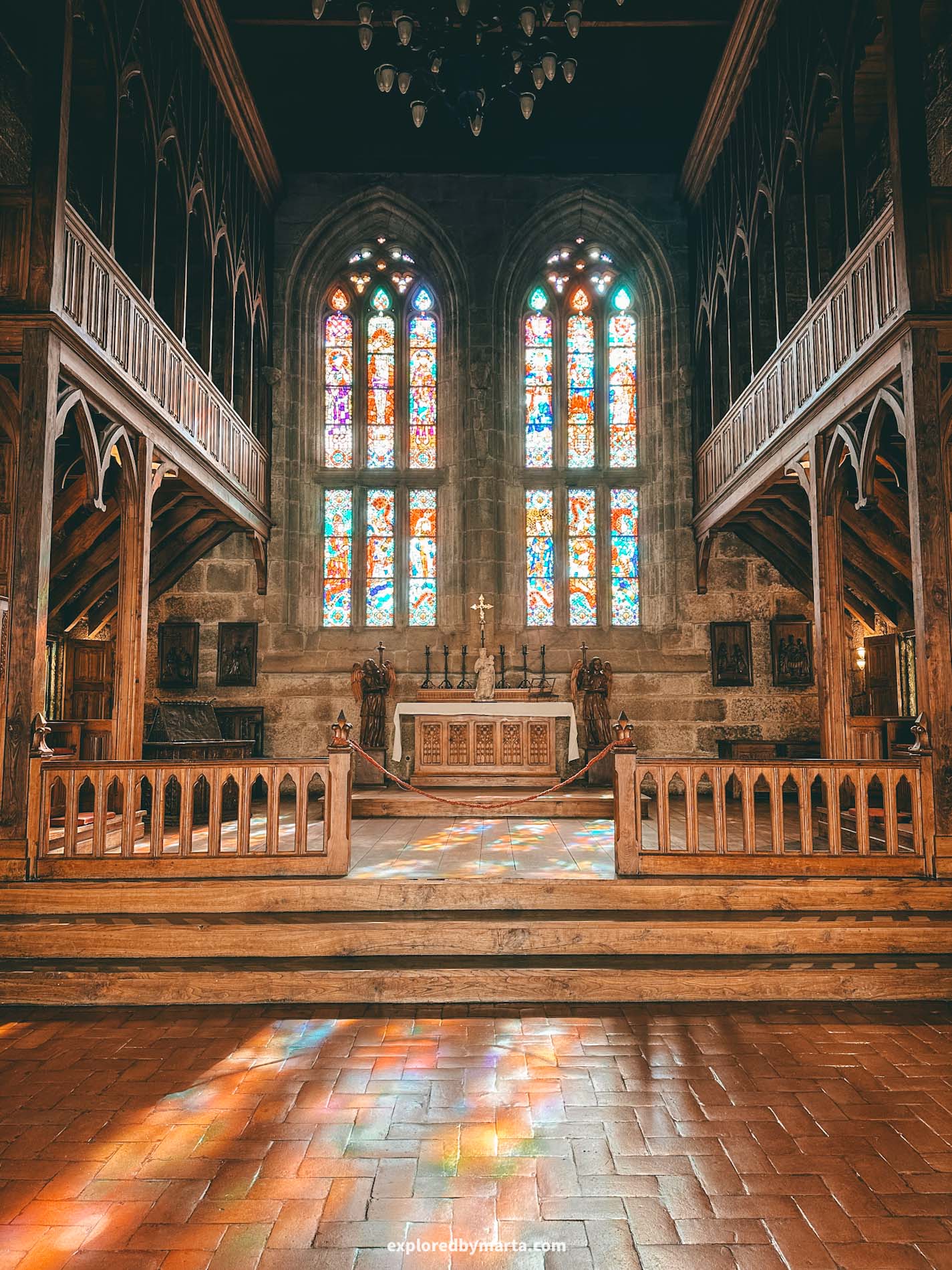
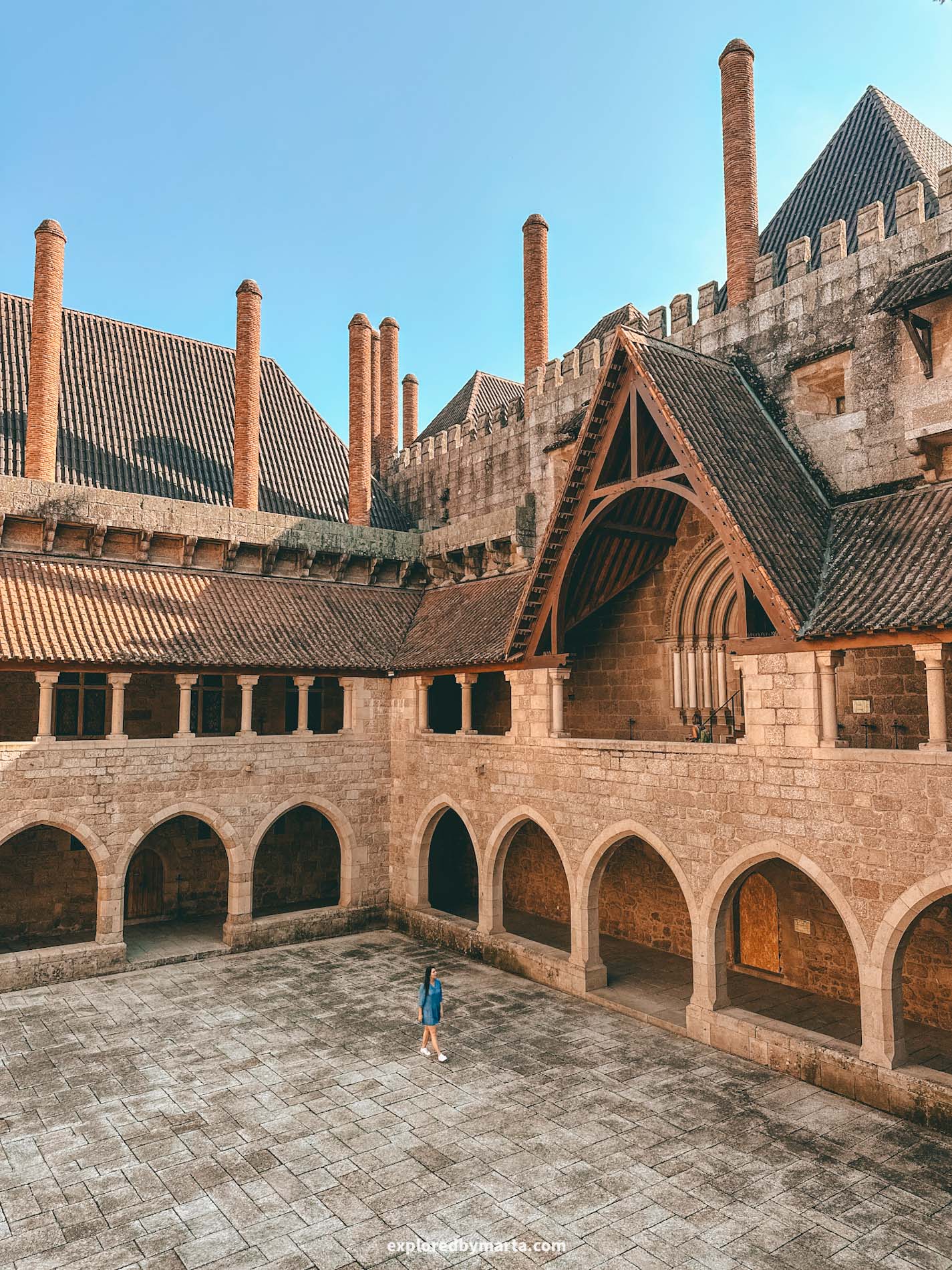
One of my favorite places was the chapel on the second floor, right across the palace entrance. It featured stunning stained-glass windows and wooden balconies. We arrived at the right time when the sun was shining through the window. It looked so serene!
From the upper floor, you also get a great overview of the courtyard from above. The only puzzling question I had was – why did they need so many chimneys? I guess the palace was quite cold, so there might have been a fireplace in each room?
Overall, I loved this place. If you are traveling to Northern Portugal, I highly recommend stopping by Guimarães and including this palace, as well as the iconic Guimarães Castle, in your itinerary!
Location: Palace of the Dukes of Bragança
13. Palace Hotel of Buçaco
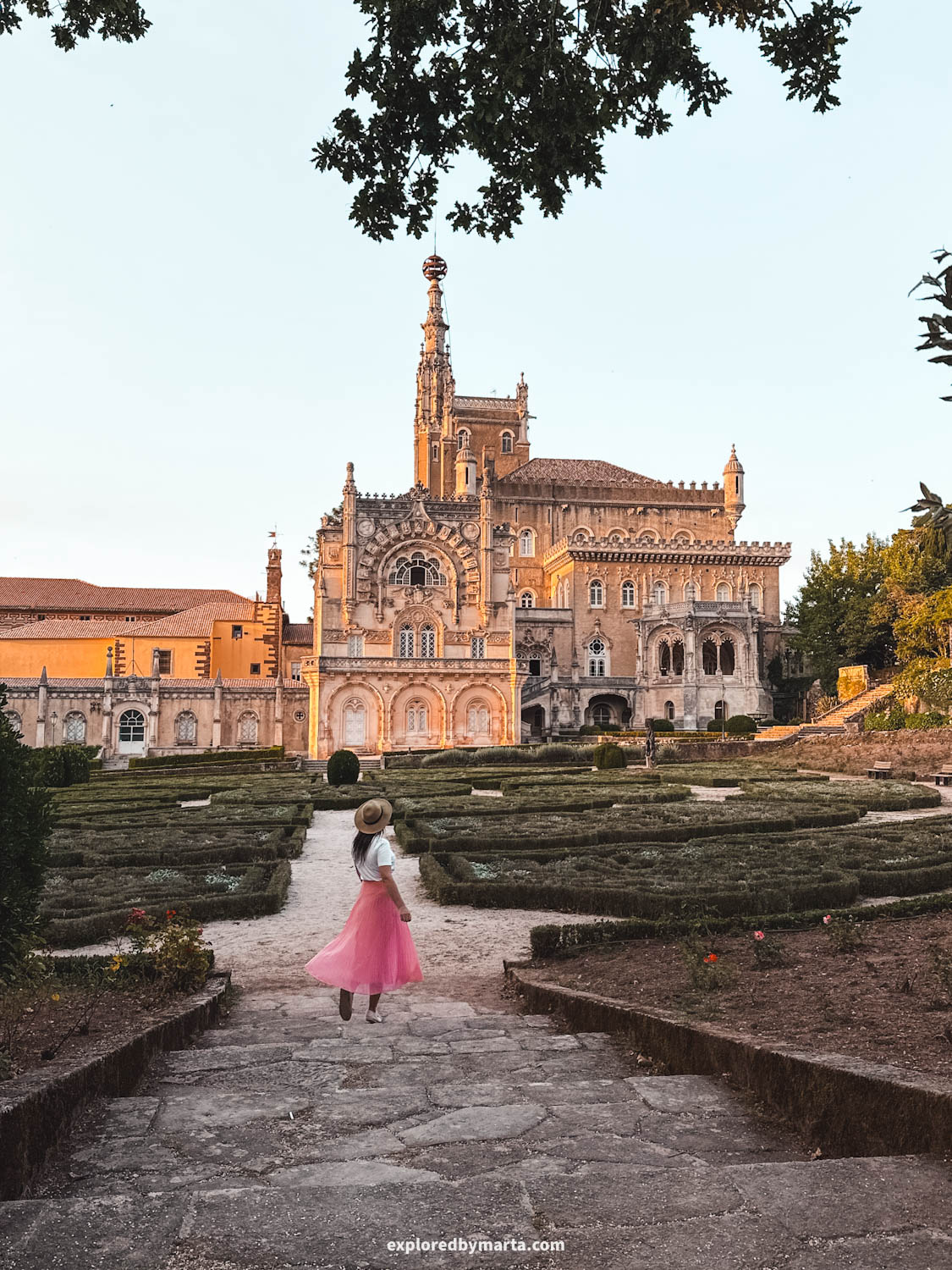
Located in an old, lush forest, the Buçaco National Forest, is a wonderful gem – the Buçaco Palace. While it looks like a palace, it actually is a former convent, and today it houses a luxury hotel.
Nevertheless, this absolute marvel was one of my favorite hidden gems in Portugal!
However, in order to visit the palace, you don’t have to book a stay there – the property is accessible to the public for free, and we used this opportunity to explore this architectural marvel in the Aveiro district.


This secret convent, along with the luxurious garden with countless species of trees, was built in the 17th century.
Part of that convent, as well as a church, is still preserved beside the palace to this day, but much of it was rebuilt. The Palace Hotel of Buçaco, as we see it today, was finished in 1907.
The palace proudly boasts a Neo-Manueline architectural style (a style born in Portugal). It is definitely one of the most beautiful buildings in Portugal!


You can freely walk around the surroundings of the palace, the spectacular garden, and the forest with its 250 plant species. It is also possible to peek inside the palace, however, we did not have time to do that.
Buçaco National Forest also hosts a 19th-century stairway right by the Fonte Fria cold water fountain. By the way, this area also sources my favorite water brand in Portugal – Luso (Luso town is next to this forest).
I loved exploring this place! The ancient arboretum, with its thick vegetation, pathways, stairs, and fountains, only added to the beauty of the palace hotel. If you are in the area, definitely stop by this hidden place!
Location: Buçaco Palace – Fonte Fria fountain
14. Castelo de Almourol, the castle inside the river

The Castle of Almourol is a medieval castle sitting on a small 300-meter islet in the middle of the Tagus River – the same river that flows through Lisbon and into the Atlantic Ocean, which makes it one of the most unique castles in Portugal.
The Almourol Castle was built during the 12th century to protect the Southern border of the Portuguese lands against the Moors. At least, at that time, this location along the river was the border.
The castle, which is like a small fortress, was controlled by the Knights Templar, one of the most influential Catholic military orders.
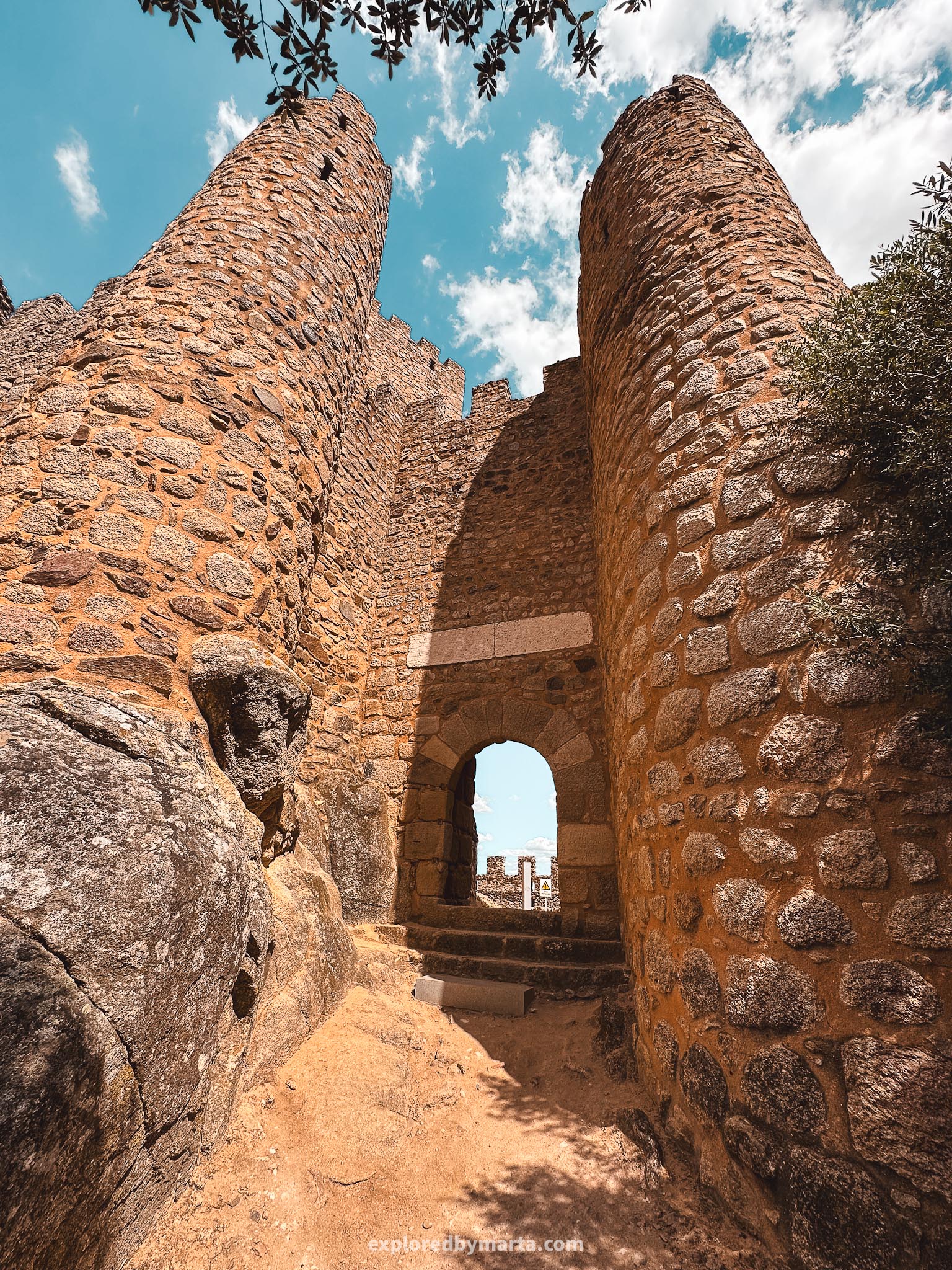

It is believed that the castle was built on top of a military structure from ancient times that was later conquered by the Romans during the 1st century before our era. This makes it pretty special!
Visits to the castle are free; however, to get to the castle, you must take a boat (it cost us 4 EUR for a round-trip). It is forbidden to walk over there, even if the water level in the river is low.
Once you get to the island, you have about 40 minutes there to explore the castle before the boat arrives to pick you up. The boat trip takes only 5 minutes.
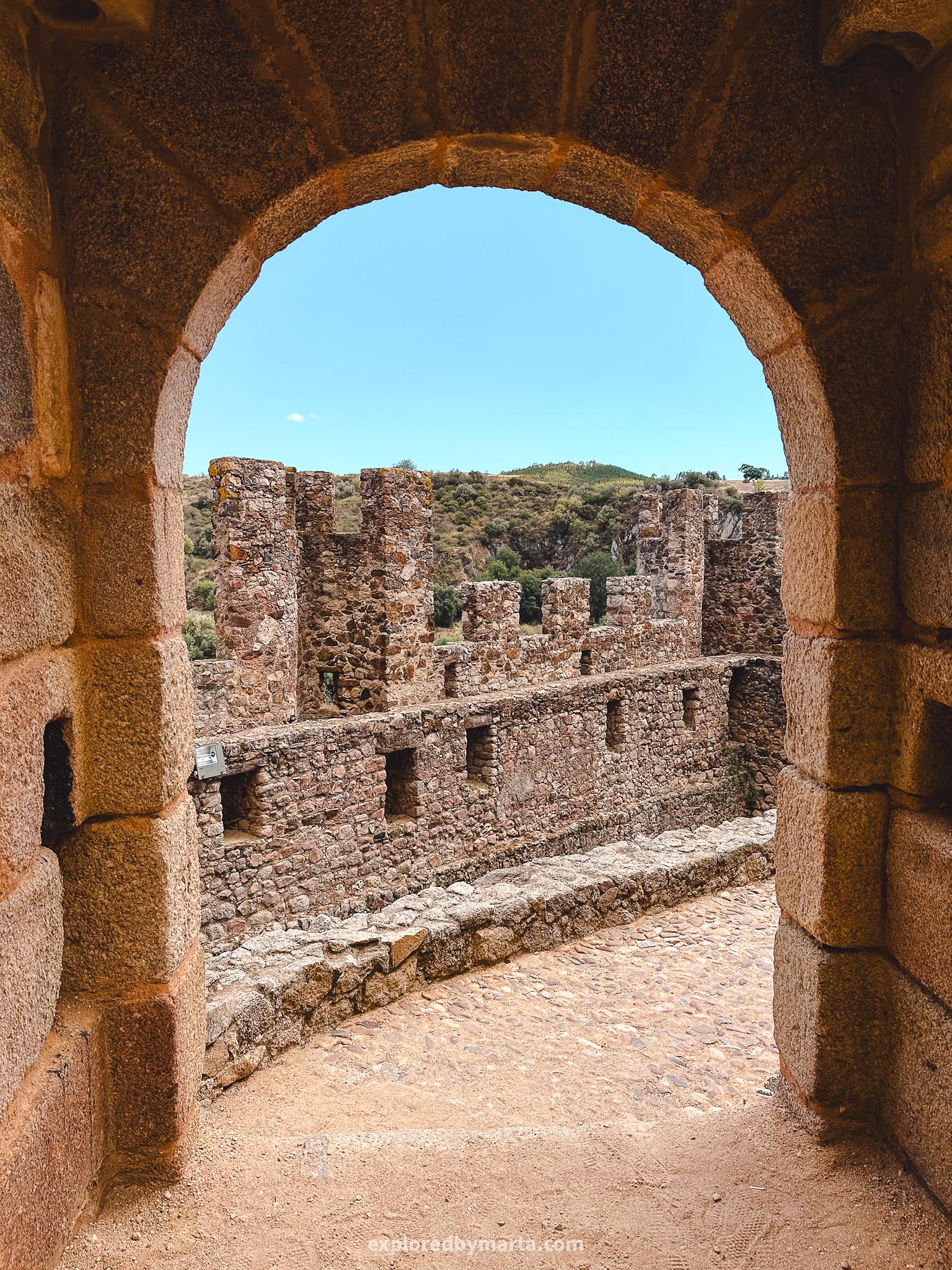

The visit to the Castle of Almourol felt like stepping back in time.
The castle has high walls and defensive towers where you can climb up and get a great view over the Tagus River. Be careful, as there are no fences protecting you from falling down the wall!
Although this is not amongst the most popular castles in Portugal, I loved visiting such a hidden gem with such a rich history. People who protected this hilltop fortress created the foundation of the Portuguese nation as it is today.
Location: Castelo de Almourol
15. Castelo de Bragança
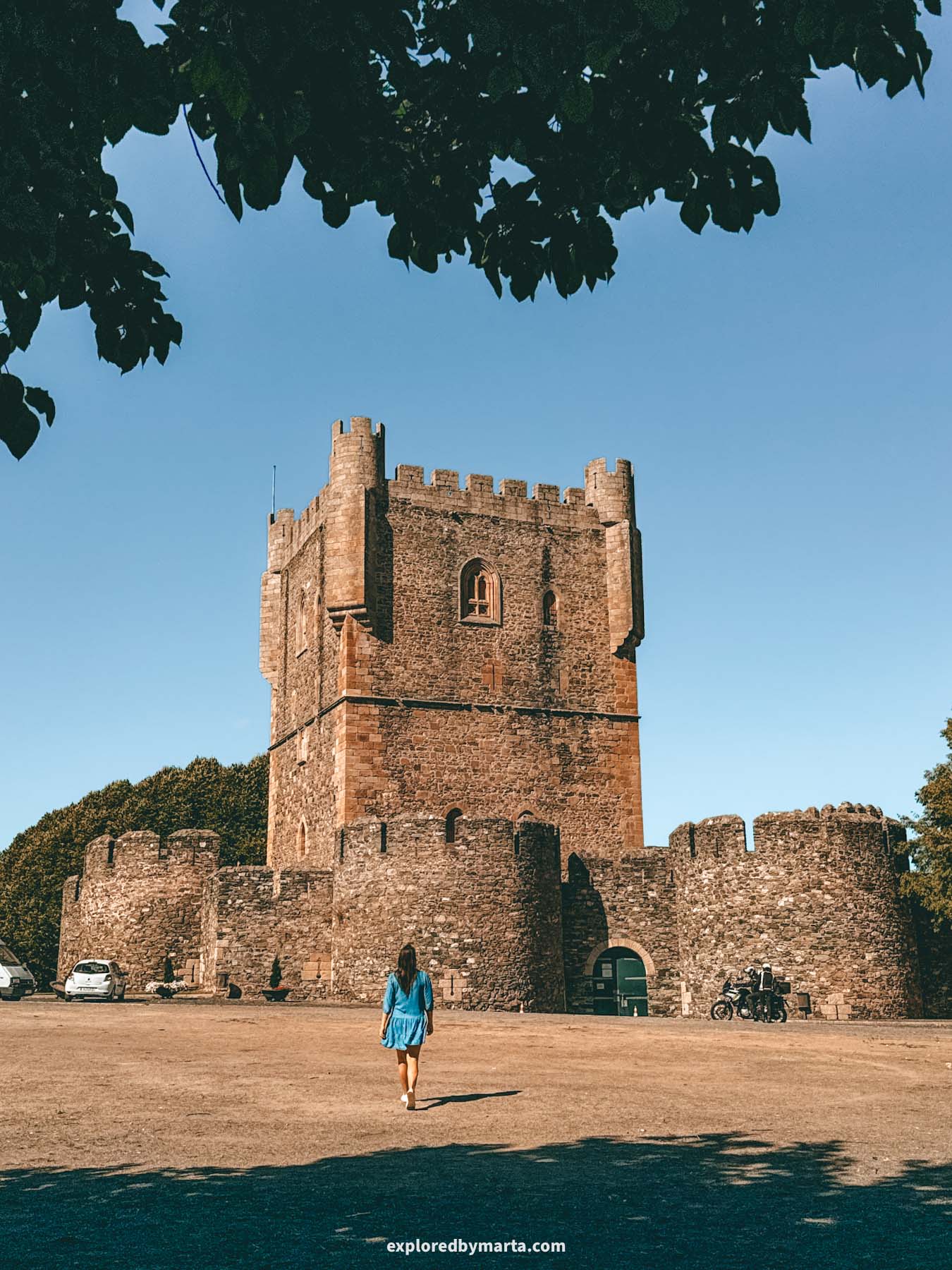
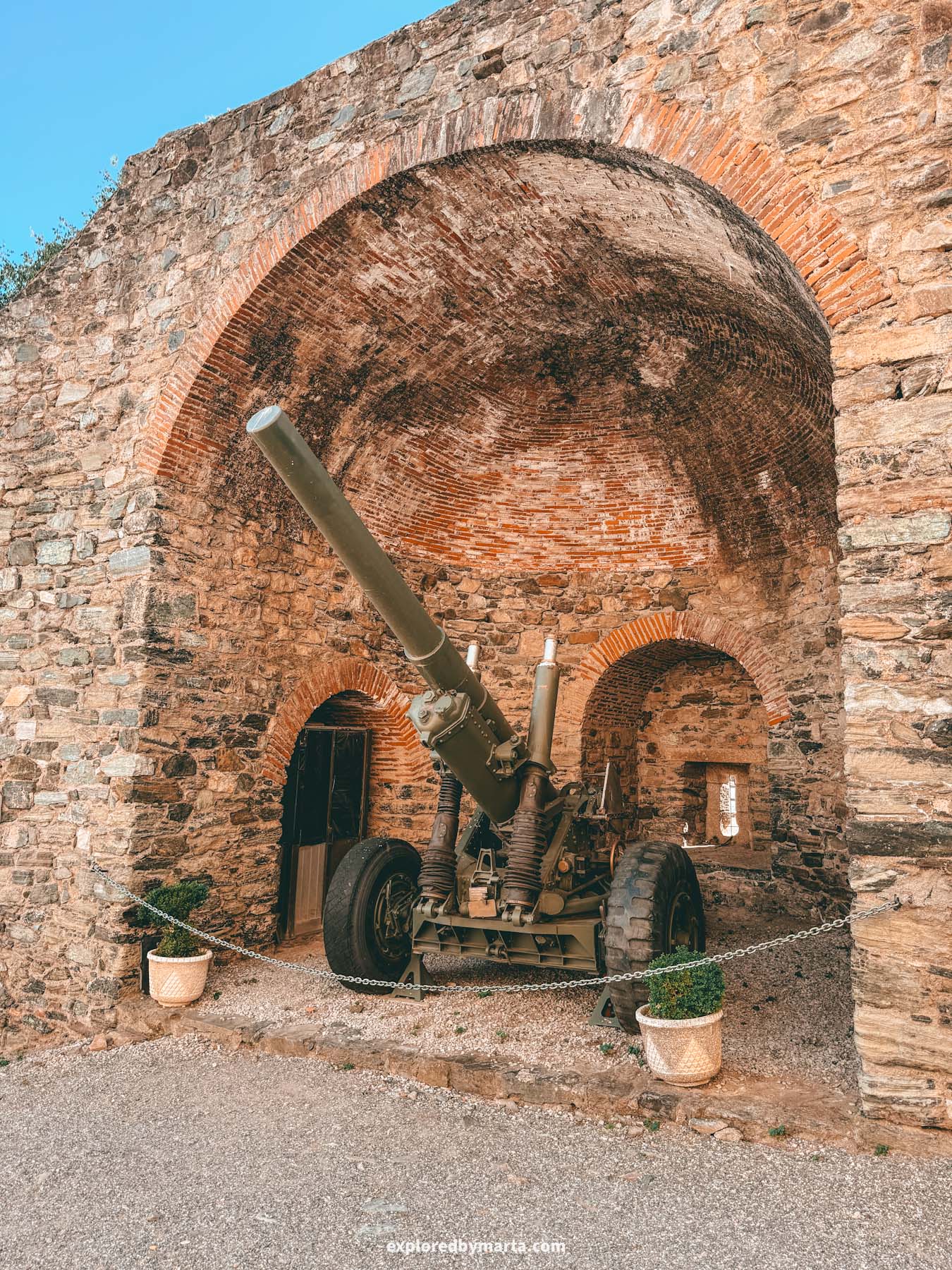
I’ve already mentioned the Palace of the Dukes of Bragança in Guimarães. But did you know that there is also Castelo de Bragança in Portugal?
Located close to the Spanish border, Bragança town is the capital of the Trás-os-Montes region, one of Portugal’s most remote and authentic areas. If you’re looking for a destination that feels off the beaten path, Bragança is a great choice!
The highlight of Bragança is its impressive medieval castle, Castelo de Bragança, which dominates the skyline. Built in the 12th century by King Sancho I, it is one of the best-preserved castles in Portugal.
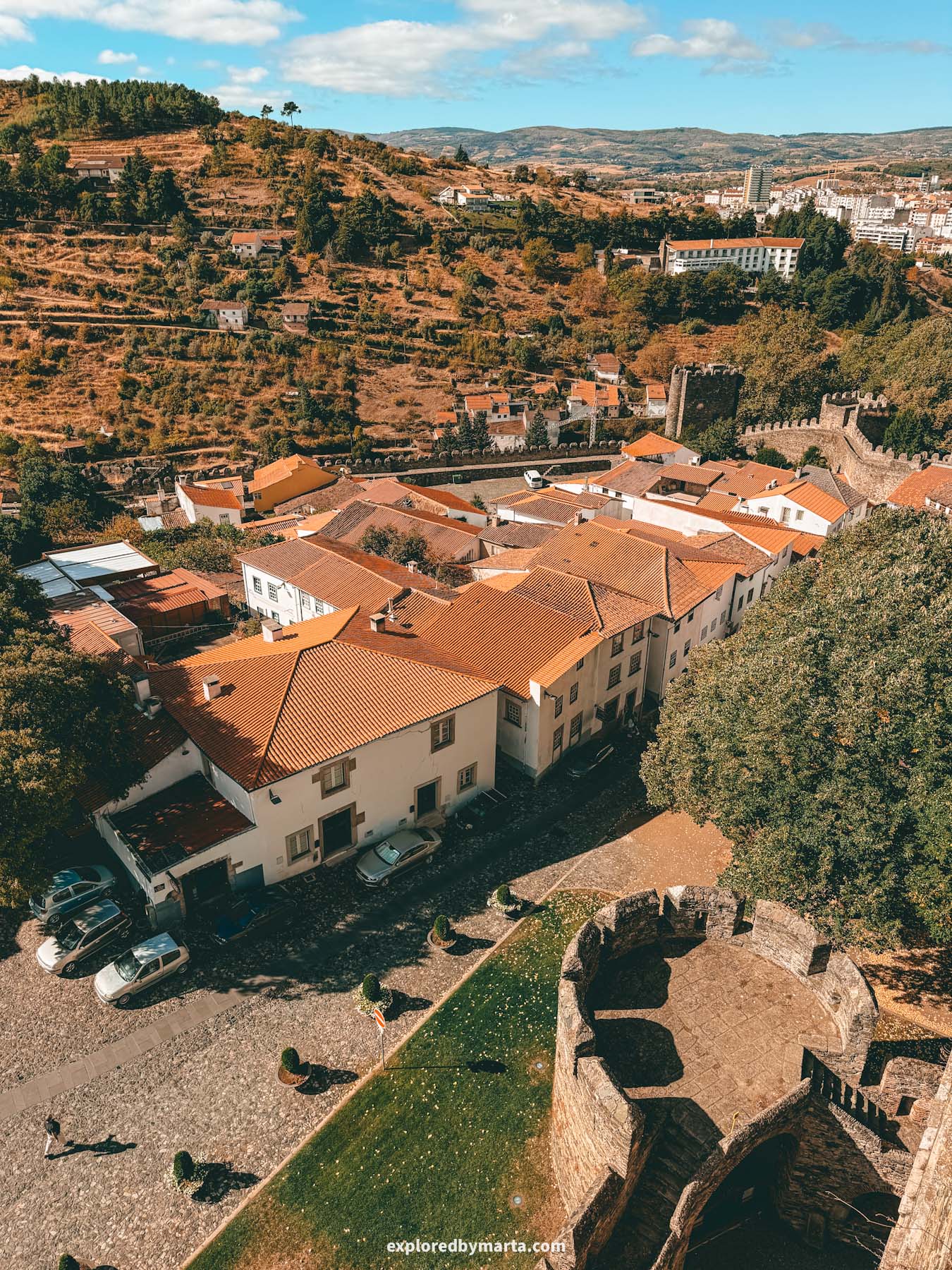

Inside the castle walls, you’ll find a small medieval village with cobblestone streets, traditional stone houses, and a charming church.
At first, I was actually quite skeptical about visiting this castle. We had to drive for hours to get there and then those same hours to get back to our apartment. However, it turned out to be one of my favorite medieval castles in Portugal.
For a small entrance fee (they asked for it in cash), you can not only explore the territory within the castle walls, but also climb the walls and the impressive, 33-meter castle tower for panoramic views of the city and the surrounding countryside.
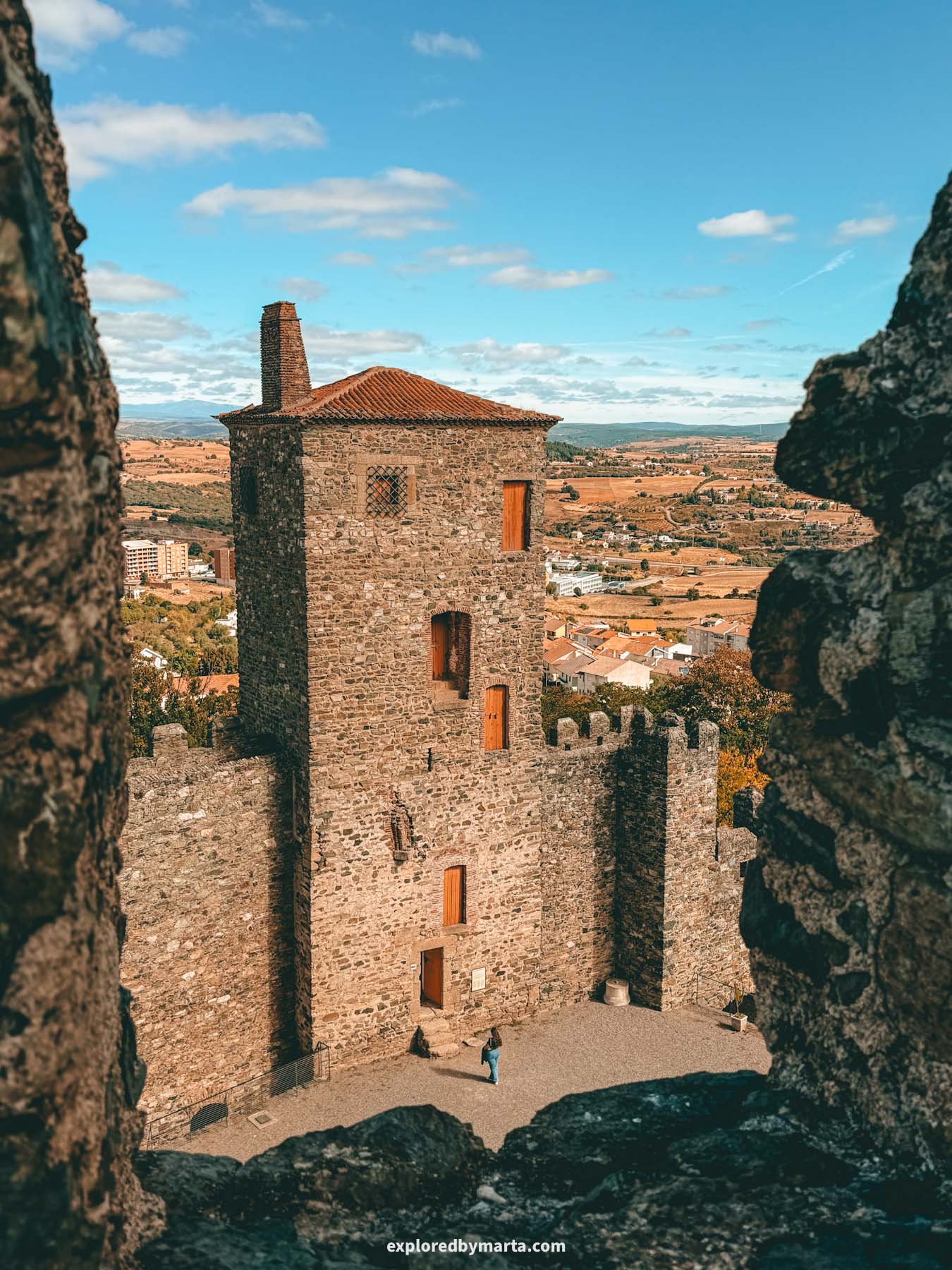
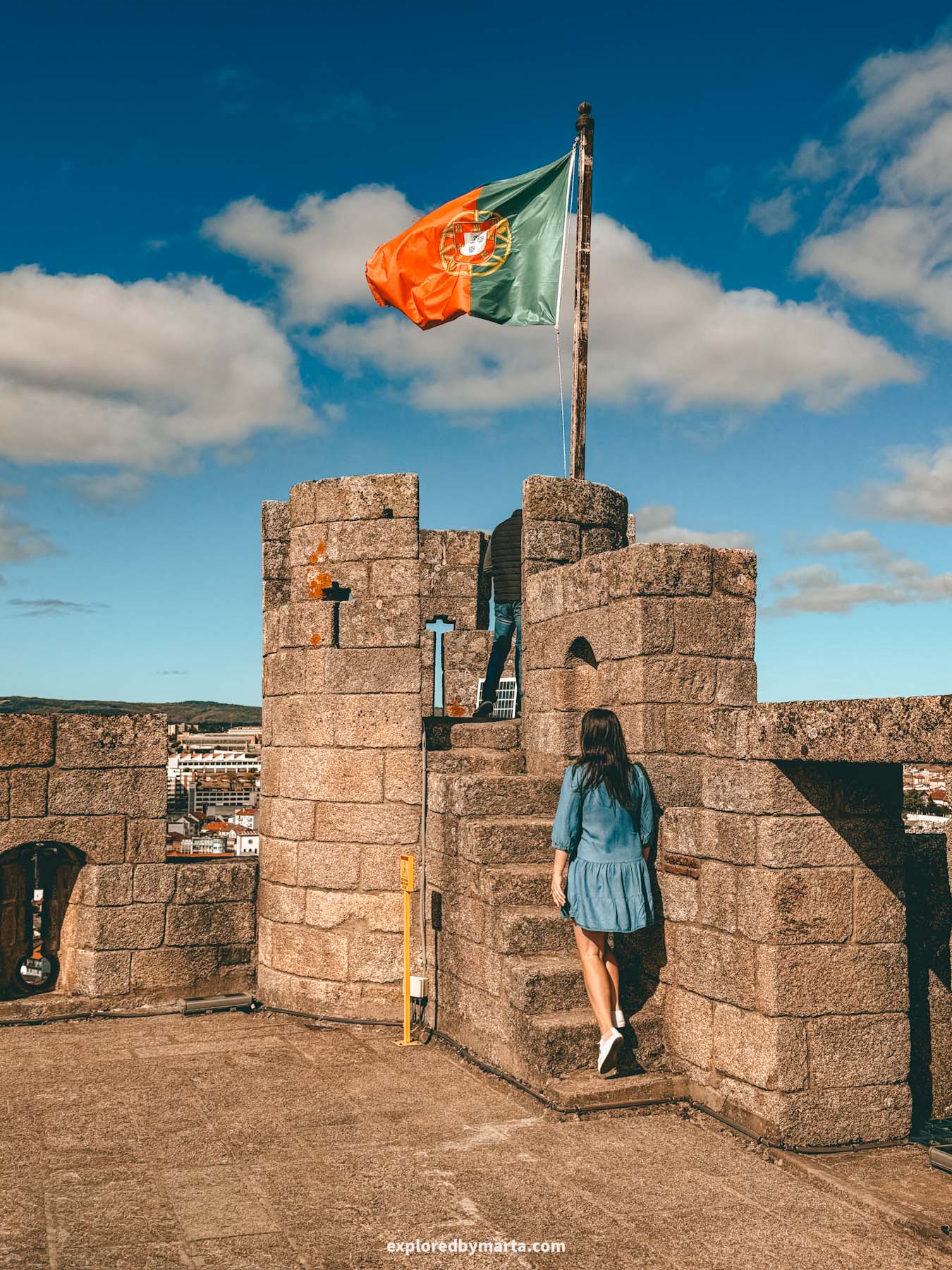
And not only that! The castle tower is actually a Military Museum, which houses a collection of ancient weapons, maps, flags, armor, and many more interesting artifacts from Portugal’s history. It was so cool and so interesting, we spent over an hour there!
Fun fact – the castle also gave its name to the House of Braganza, which is one of the most important royal dynasties in Portuguese history. They ruled over the country from the 17th to the 20th century and produced 15 Portuguese monarchs!
Bragança may not be as well-known as other cities in northern Portugal, but that’s part of its charm. It’s quiet, full of history, and gives you a real taste of traditional Portuguese life away from the crowds. If you happen to be nearby, do not hesitate to stop by this place!
Location: Castelo de Bragança
16. Palácio do Raio, the blue palace
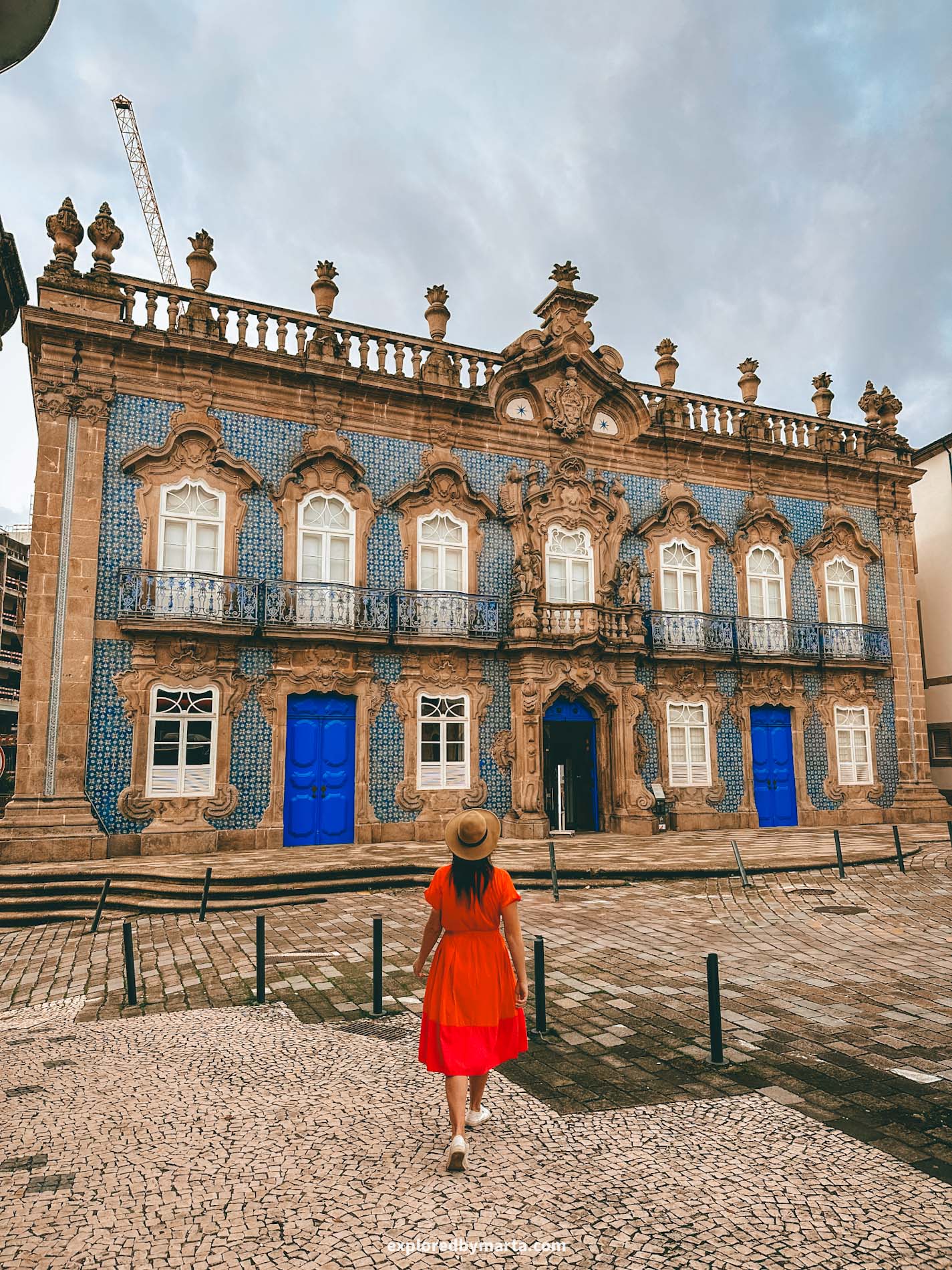
Palácio do Raio, the iconic blue palace, is one of the most important landmarks and one of the best places to visit in Braga. The 18th-century palace stands out with its striking blue facade. It immediately caught my eye!
This beautiful Baroque-and-Rococo-style palace, also known as Casa do Mexicano, was built for a wealthy local merchant and is the perfect place to visit to see how wealthy people lived back in the day. If you’re in Braga, don’t miss this spot!
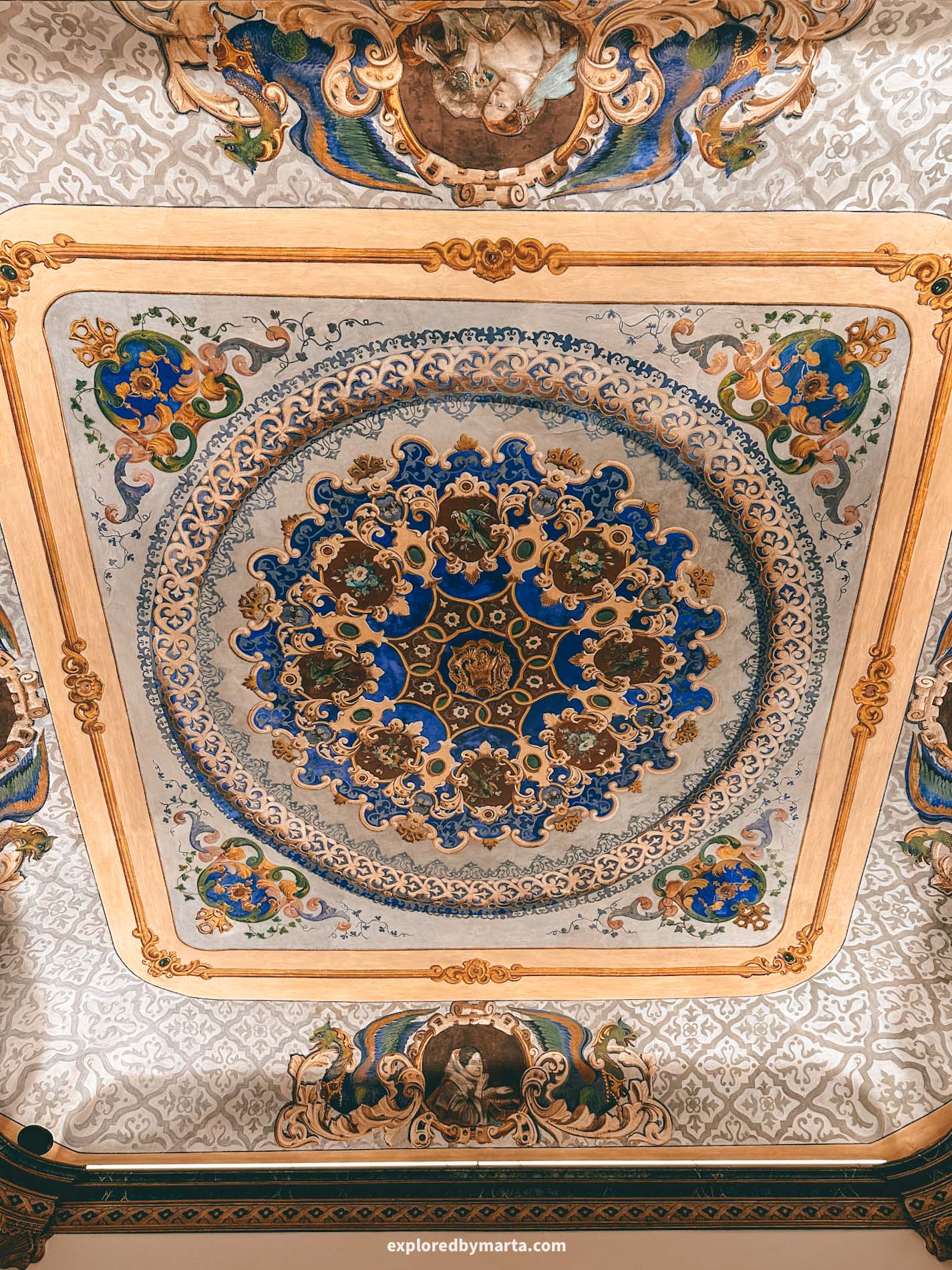

Palácio do Raio was designed by André Soares, the most famous architect in Braga, who has designed many popular landmarks in and around the city. He really did something unique here!
Inside, the palace houses a small museum that tells the story of Braga’s history and religious heritage. You’ll find a beautiful staircase, decorated rooms, and all kinds of art.
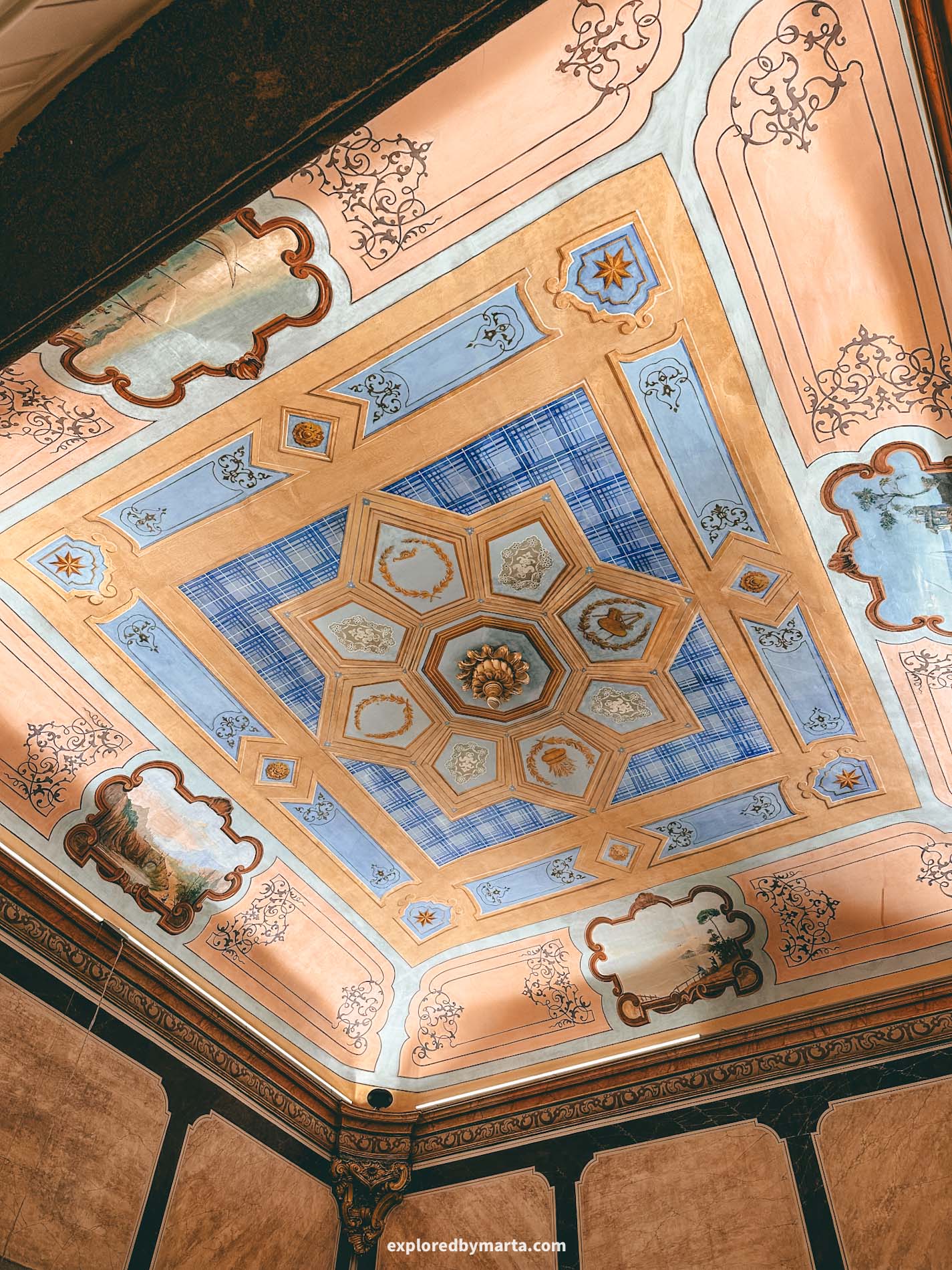
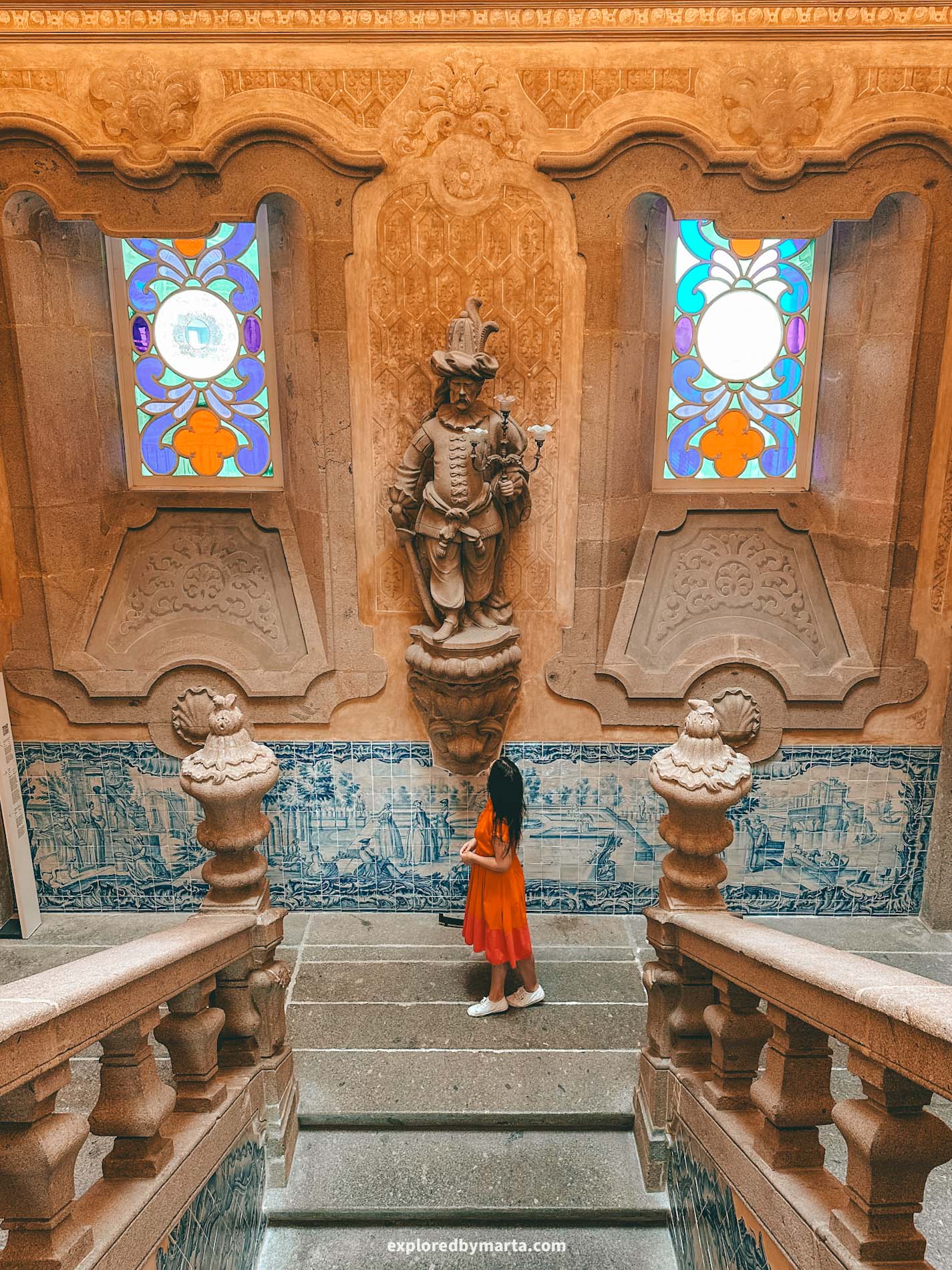
Probably, the most interesting thing was to see the decorated rooms and furniture, showcasing the way wealthy people lived here centuries ago. There is a small fee to enter the palace.
Even if you don’t go inside, it’s worth stopping by just to admire the facade and take some photos – the contrast of blue tiles against the stone and the sky makes it one of the most photogenic spots in Braga.
Location: Palácio do Raio
17. Castle of Santa Maria da Feira
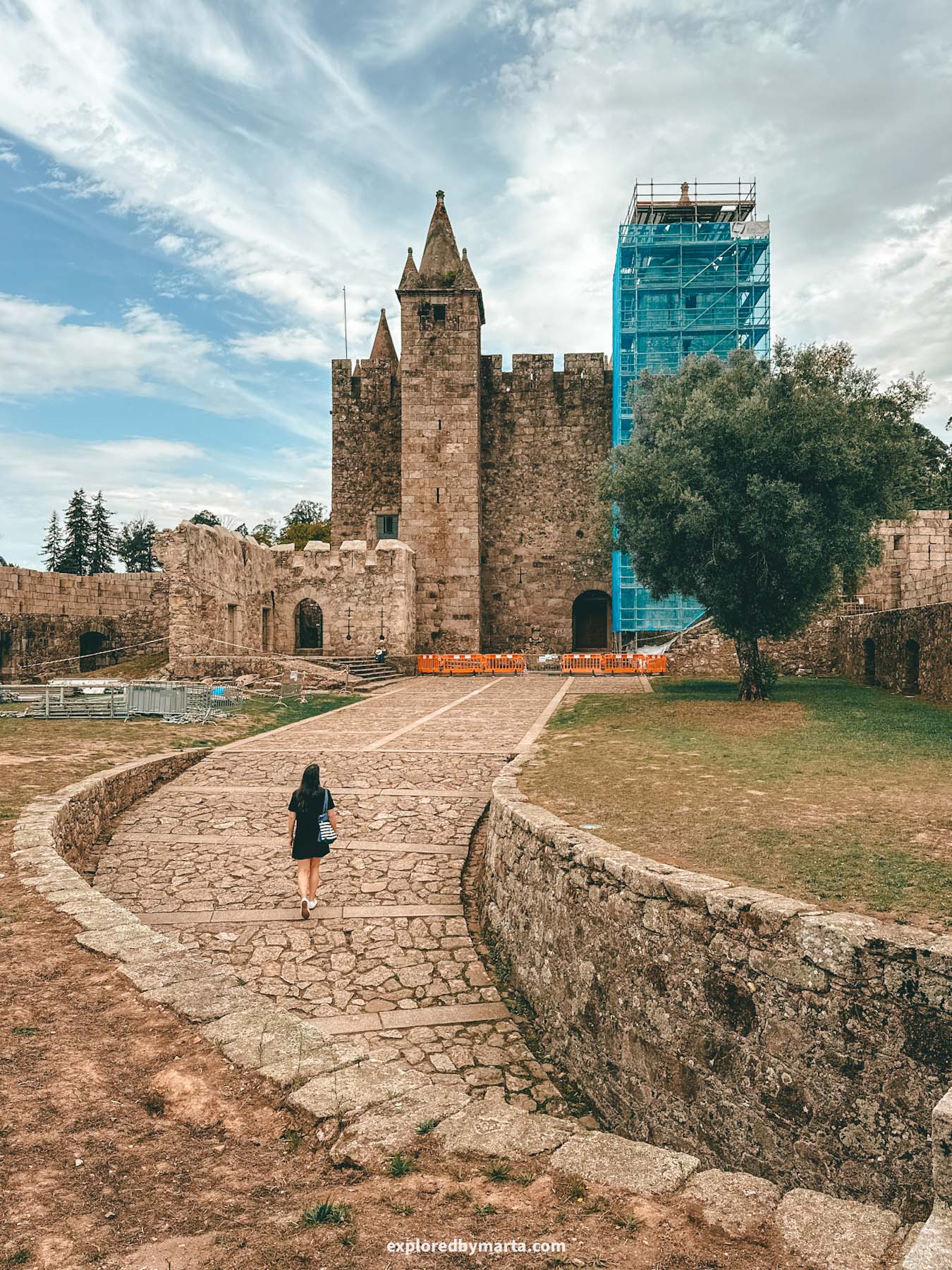
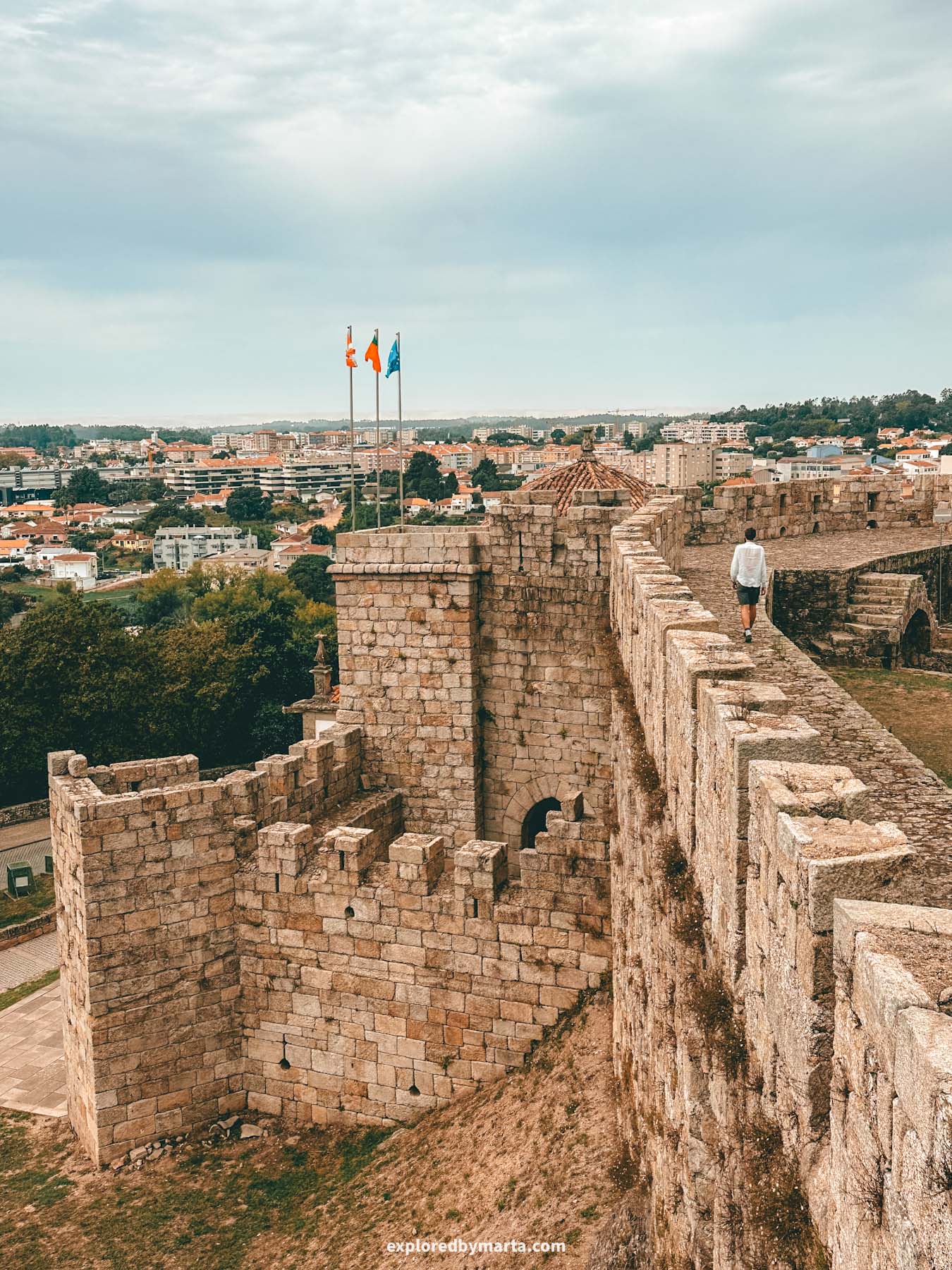
If you are staying in Porto (or somewhere nearby Porto!) and you enjoy exploring medieval castles, a visit to the Castle of Santa Maria da Feira makes a great day trip from Porto.
This wonderful fortress is one of the most important examples of medieval military architecture in Portugal and is located only about a 30-minute drive south of Porto.
So you don’t have to drive too far away to soak in those medieval vibes and atmosphere!

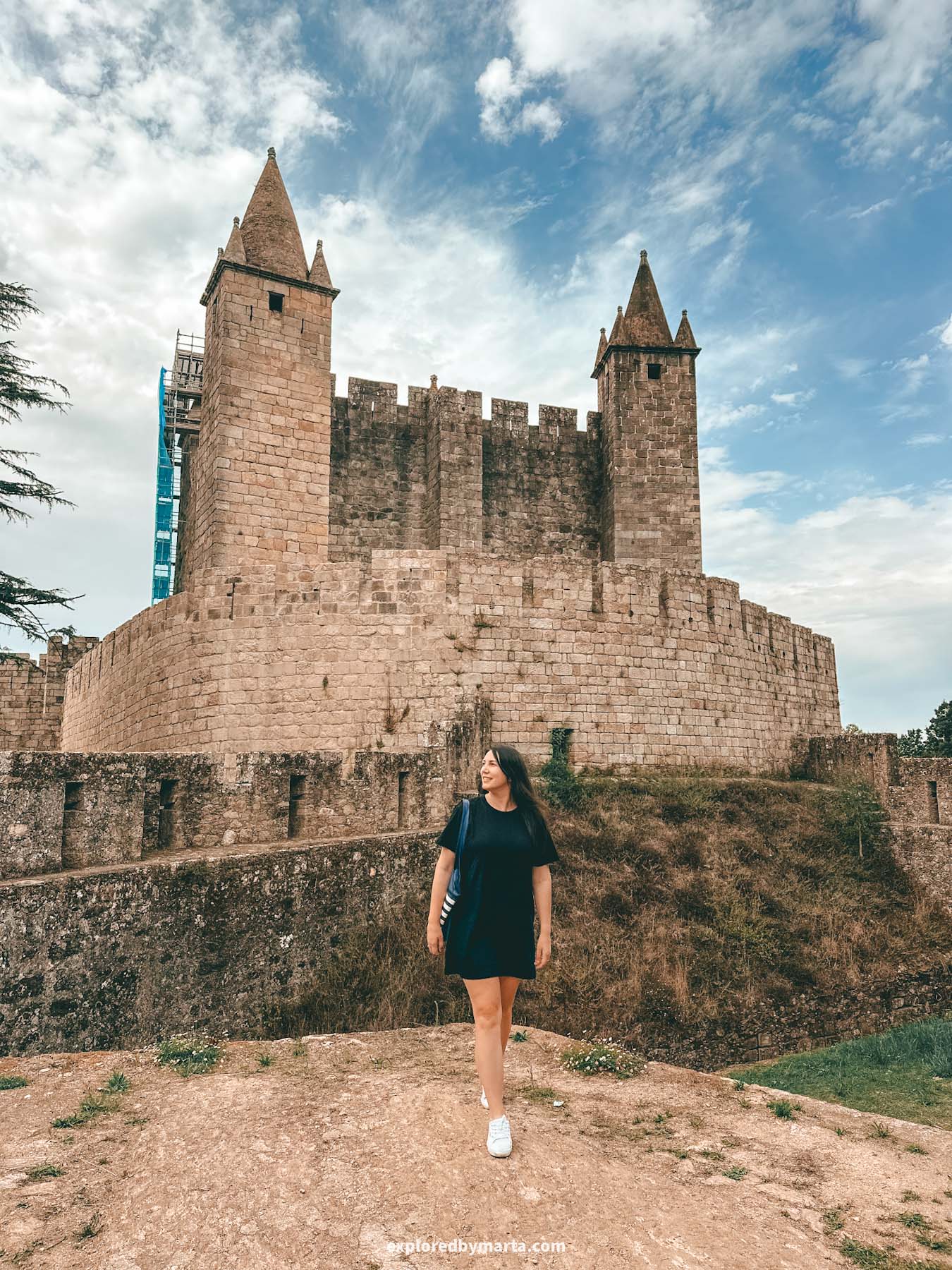
Although there have been some military fortifications in this place since the 9th century, the Castle of Santa Maria da Feira dates back to the 11th century and played a key role in defending the region and the newly created country of Portugal.
It is located in the heart of the town of Santa Maria da Feira, known for its lively festival Viagem Medieval – one of the largest medieval fairs in Europe that takes place here every summer.
During the event, the whole area around the castle transforms into a living medieval village. People walk around with medieval costumes, and there are different performers, artisans, and traditional food stalls.

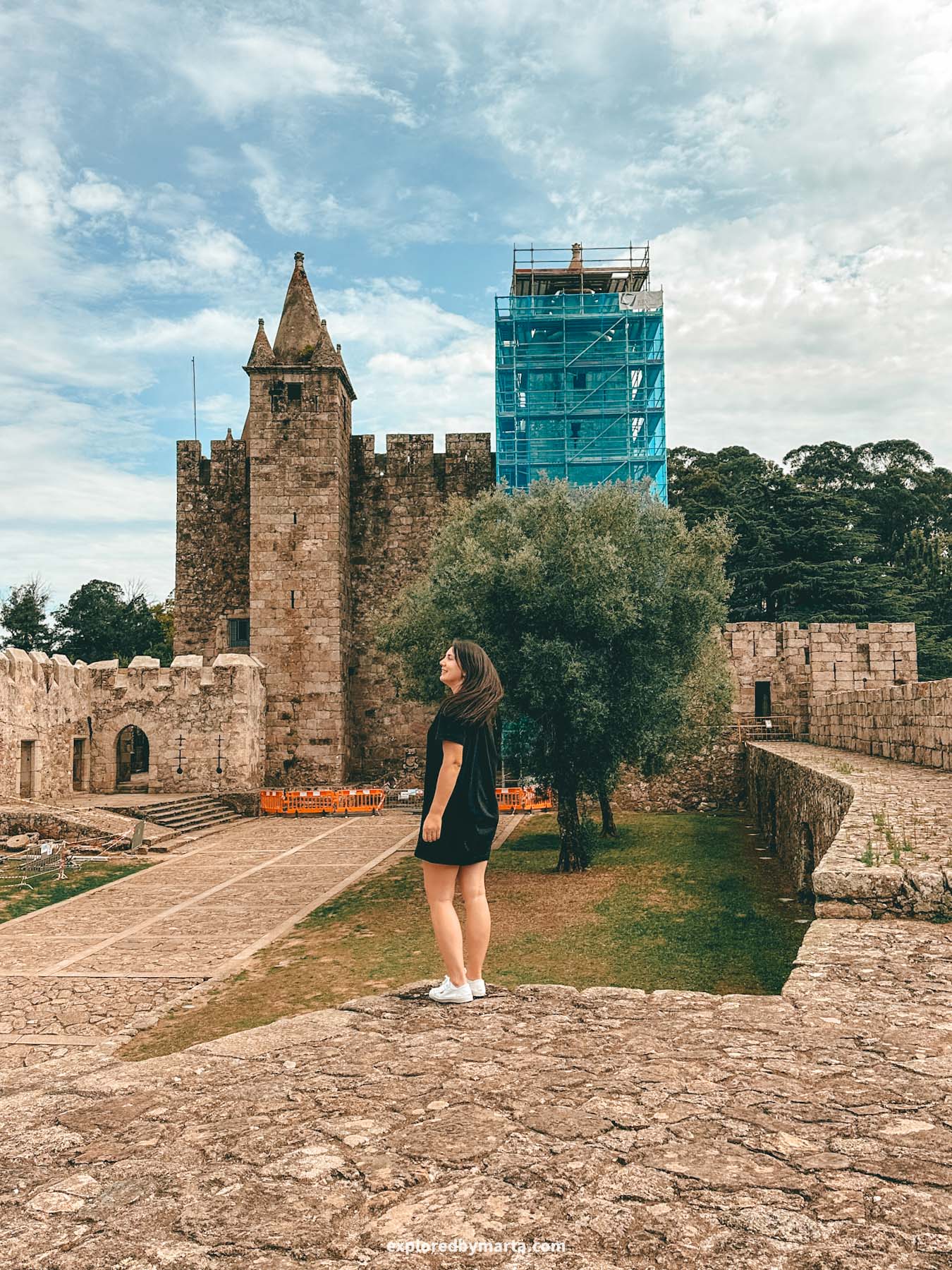
We weren’t here during the festival, and only explored the castle.
However, I very much liked its fairy-tale towers (although they renovated one of them during our visit), battlements, and stone walls with towers that overlook the whole town and the surrounding area.
We also got to explore some of the rooms inside and walk down through a tunnel to the lower floors. Even outside festival season, the Castle of Santa Maria da Feira is worth a visit. And it is definitely one of the most beautiful medieval castles in Portugal.
Truly feels like stepping back in time!
Location: Castle of Santa Maria da Feira
18. Castle of Marvão
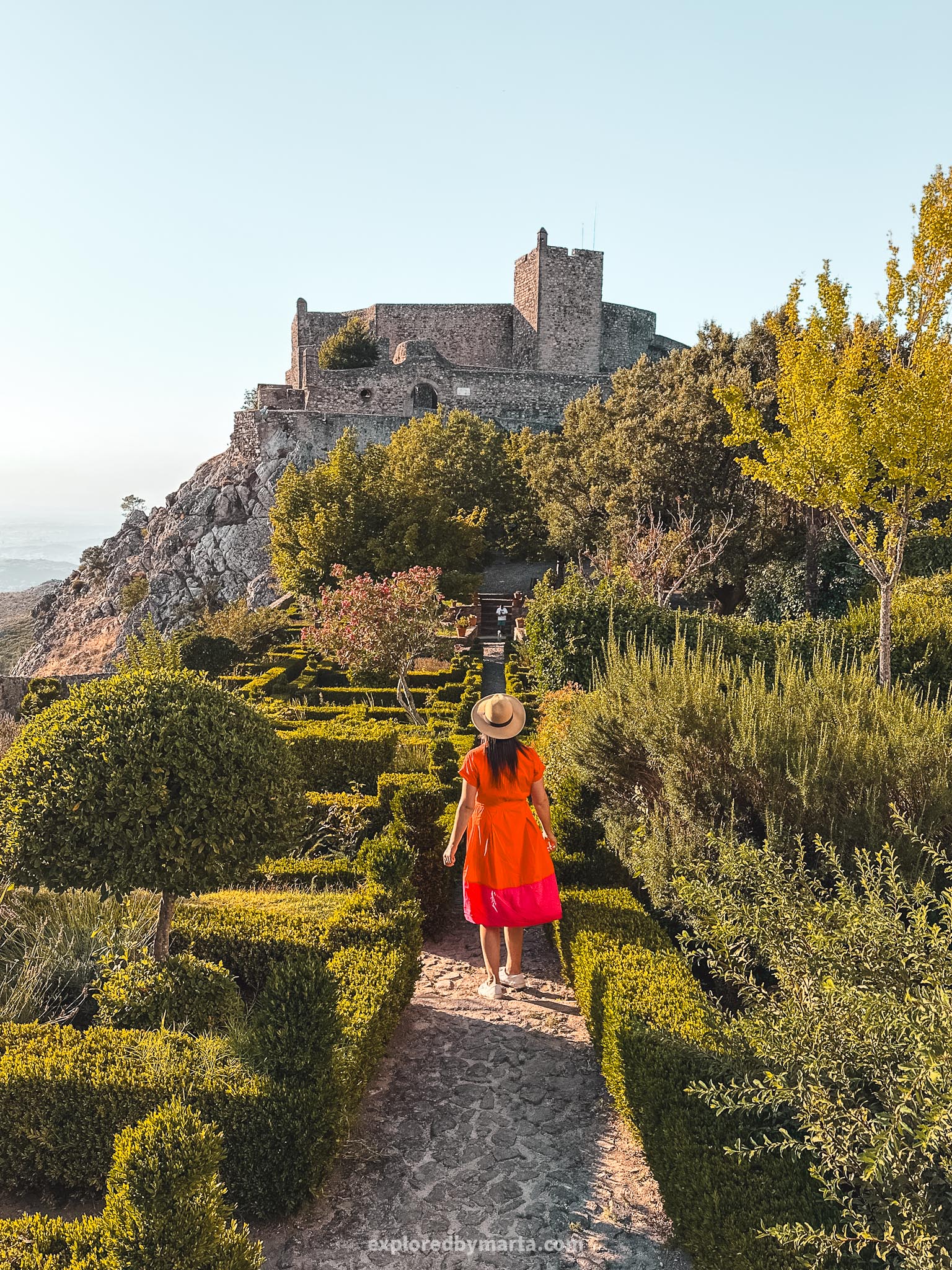
Marvão is one of Portugal’s most beautiful medieval villages, sitting 860 meters above sea level on a large quartzite rock in the Serra de São Mamede mountains in Eastern Portugal.
It is located near the Spanish border, a 2h 30min drive Northeast of Lisbon.
The village earned significant attention after it was listed in the #1 New York Times bestselling book ‘1000 Places to See Before You Die‘. With more than a thousand years of history, this village is a mystical place to discover.
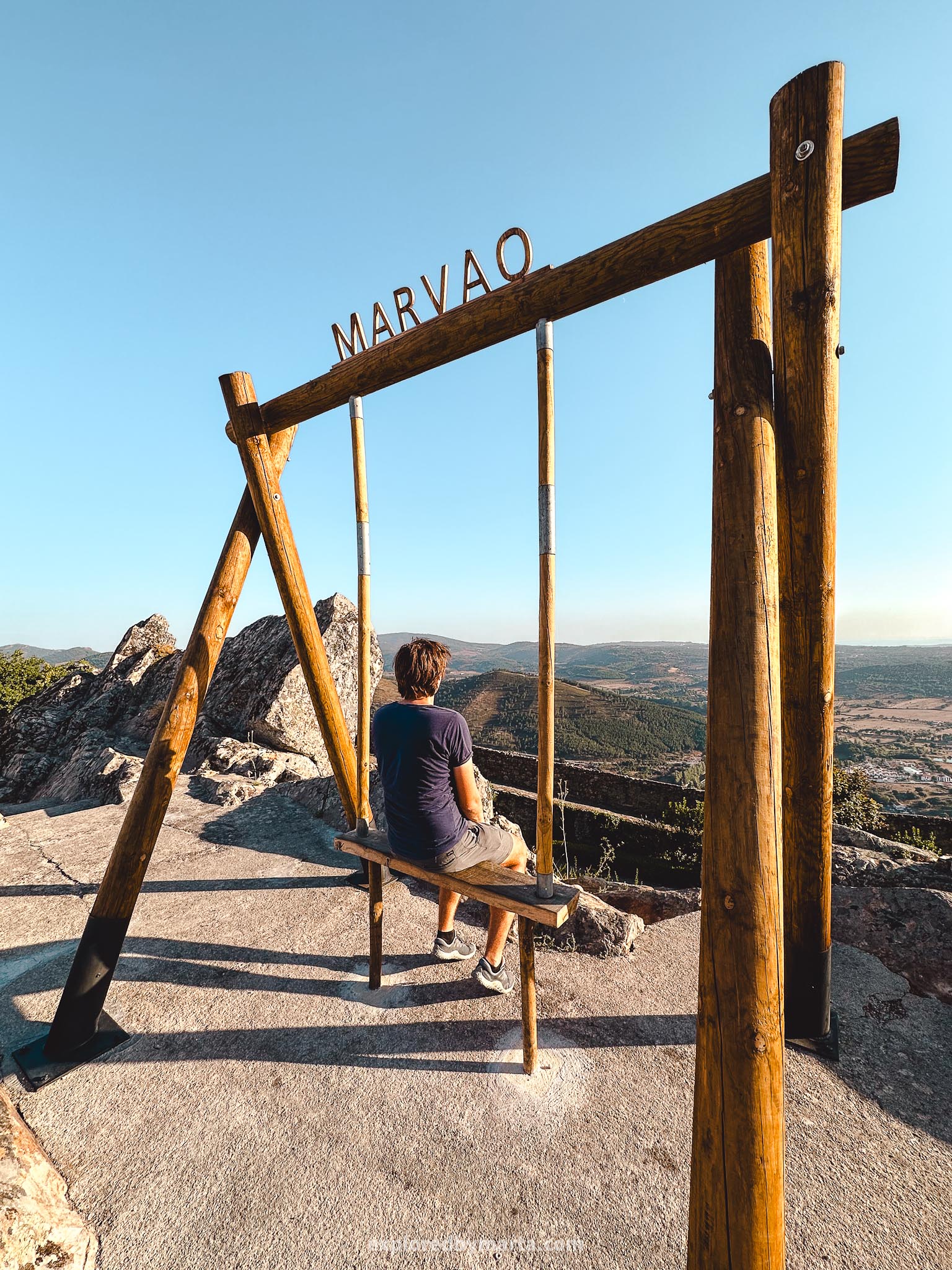

The most famous attraction in Marvão is the Castle of Marvão – a well-preserved medieval castle dating back to the 8th century.
You can access the castle’s walls, defensive towers, and courtyards for a small entrance fee (we paid 1.5 EUR each, a total bargain, if you ask me).
The whole hilltop village is a fortress with big stone walls completely surrounding the houses and the castle.
Once you step inside the fortification, you are thrown back to medieval times with those narrow cobblestone streets leading you into a maze of stone houses.
I love hidden places like these! I’m so glad we visited this forgotten place!
Location: Castle of Marvão
19. Palacio de Mateus
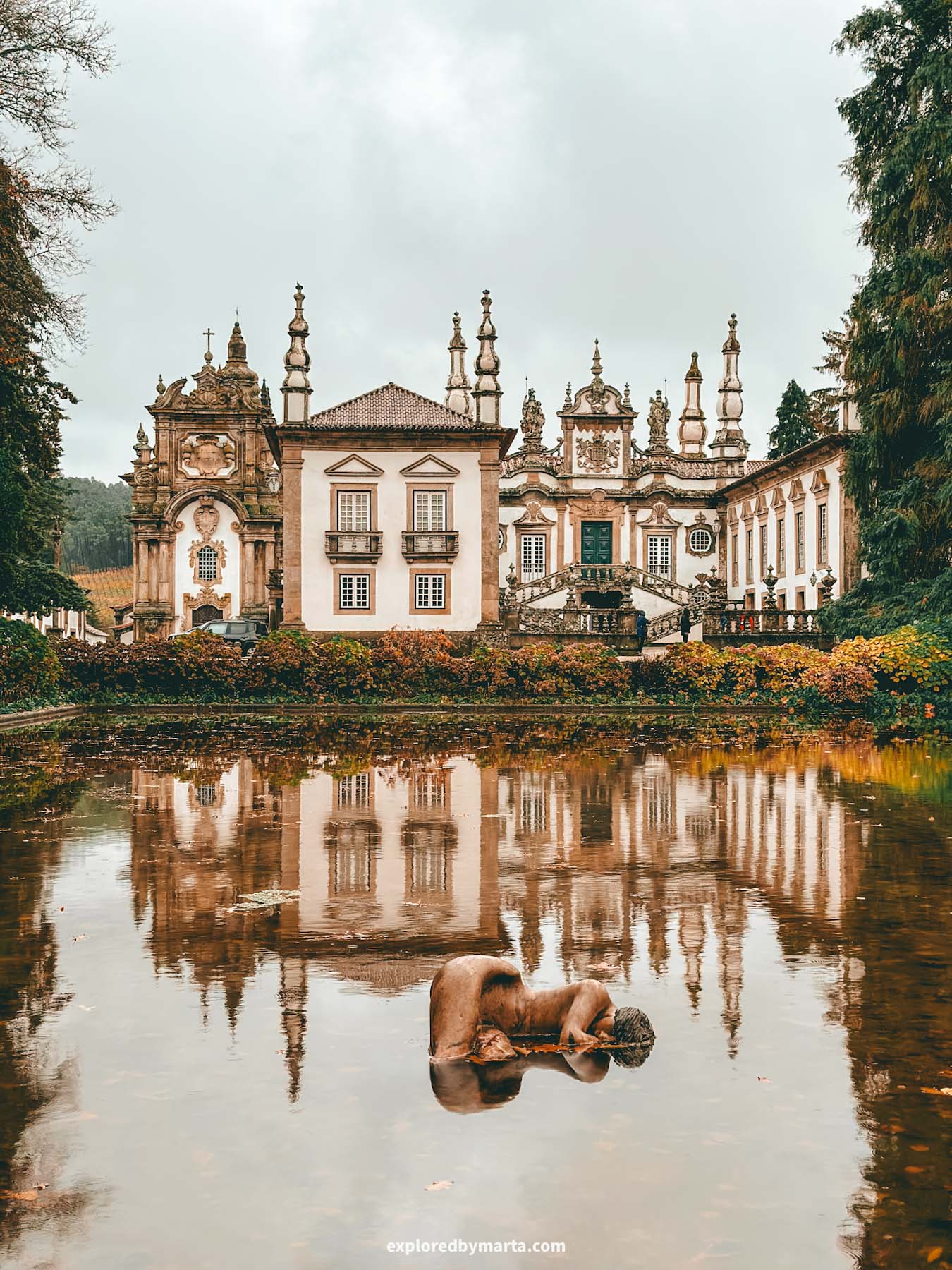
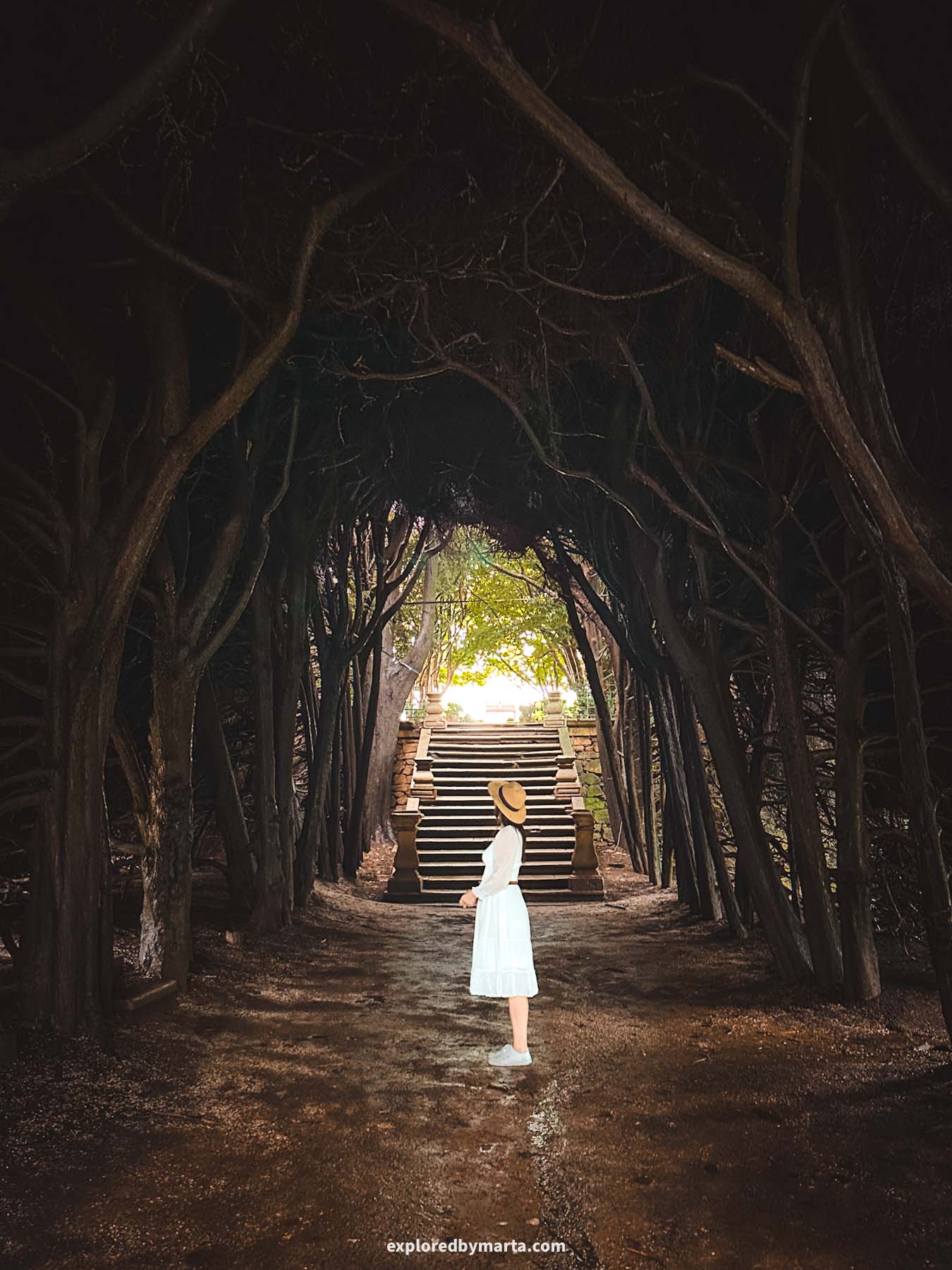
The Casa de Mateus, or Palacio de Mateus, is one of the most recognizable manor houses in Portugal. How so? The palace is featured on the label of Mateus wine.
Located near Vila Real in northern Portugal, this beautiful 18th-century estate is famous for its baroque architecture, beautiful gardens, and a reflection pond that perfectly mirrors the façade of the mansion.
I tried my best to take a picture like that, but it was raining a bit, so the reflection wasn’t the best – the water was moving all the time, haha!
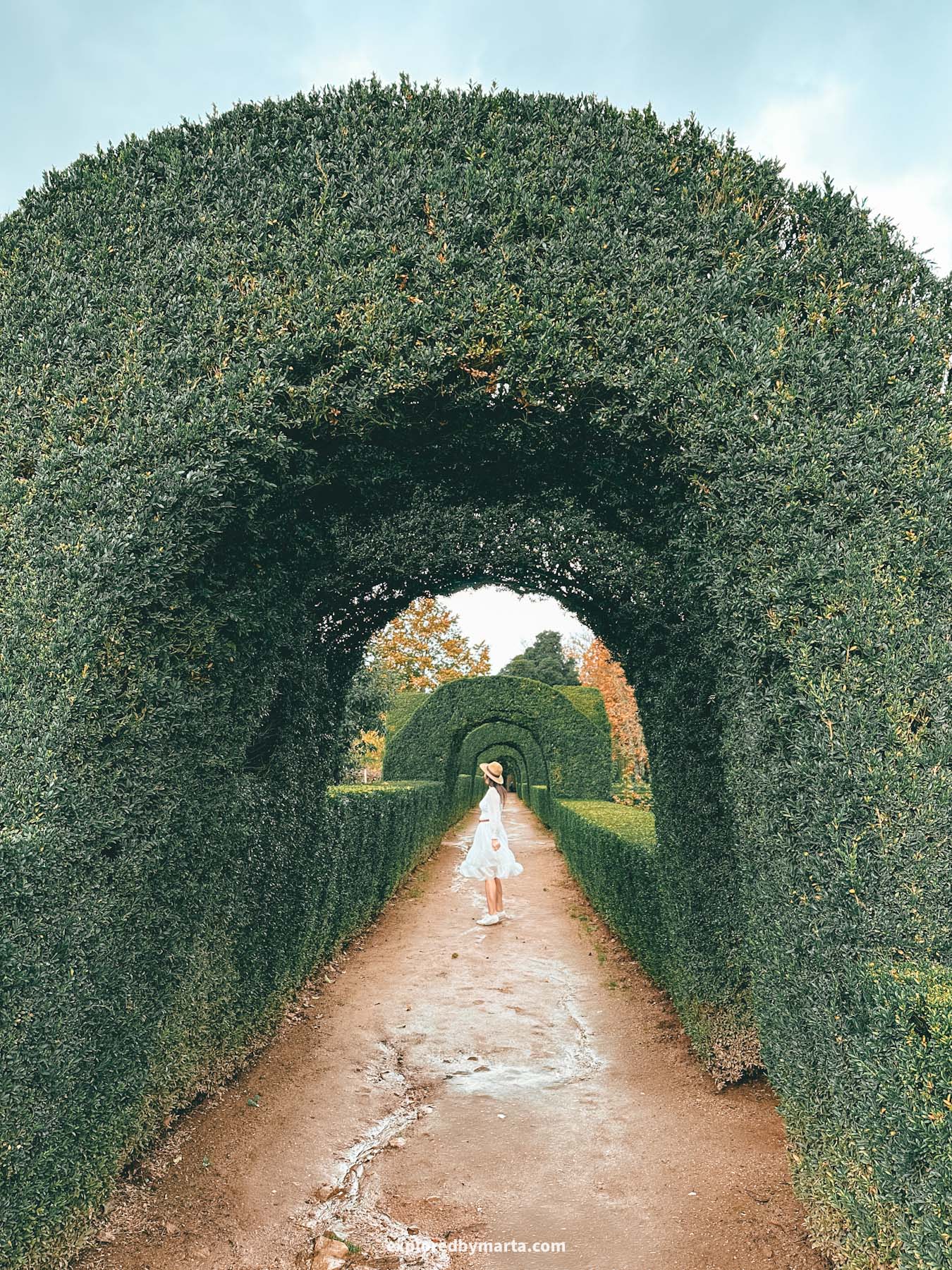
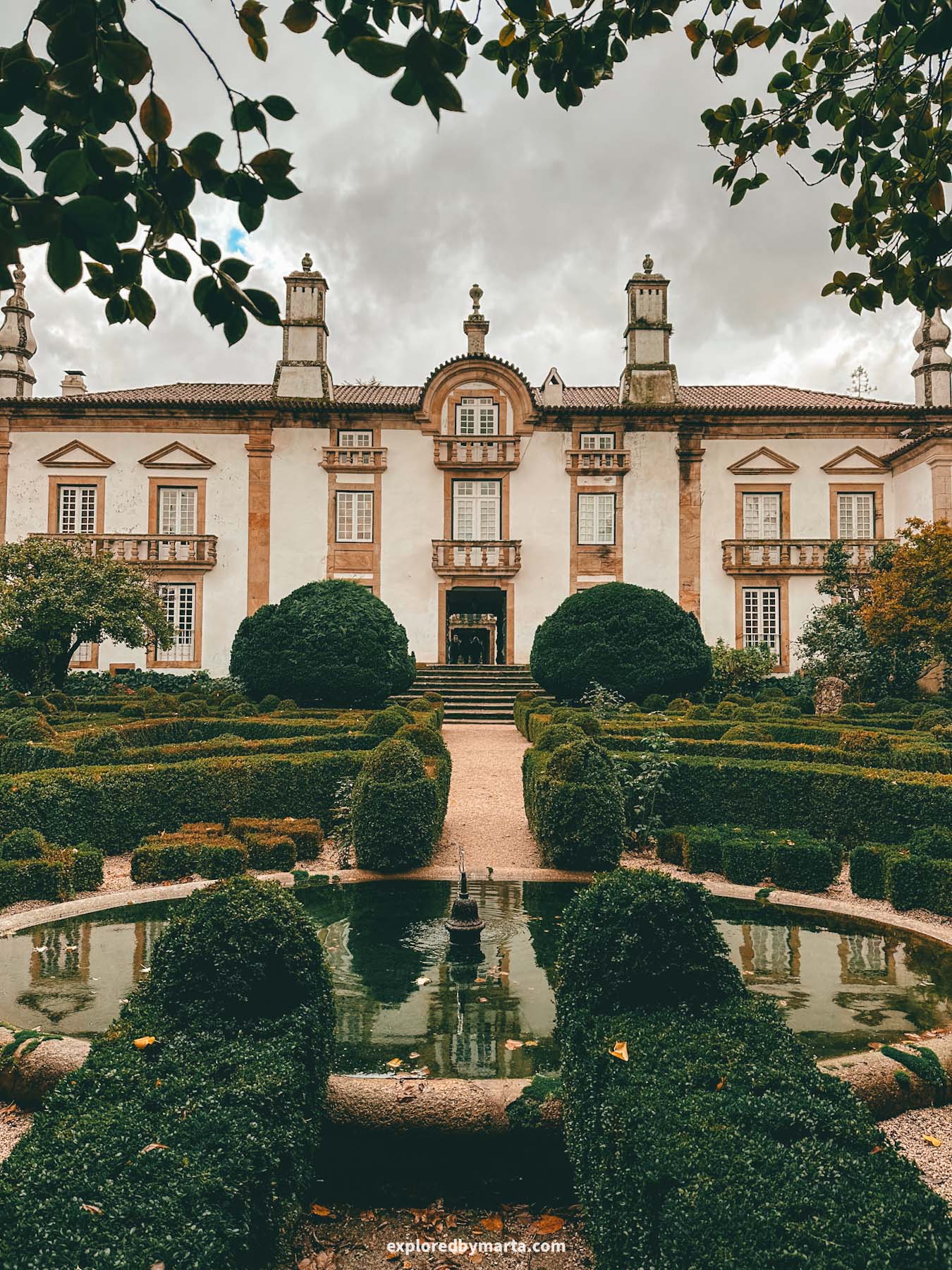
The mansion was designed by the Italian architect Nicolau Nasoni, who also worked on several landmarks in Porto (the most famous one – the Tower of Clérigos Church).
It is truly beautiful, but you can only visit the interior by joining a guided tour. There is also another option to buy a ticket for the exterior of the palace, where you can enjoy the pond, the gardens, the maze, and the forest paths.
This is what we did – the entrance fees are quite steep, but I wanted to at least see the exterior. And it was truly beautiful, even though it was raining a bit.
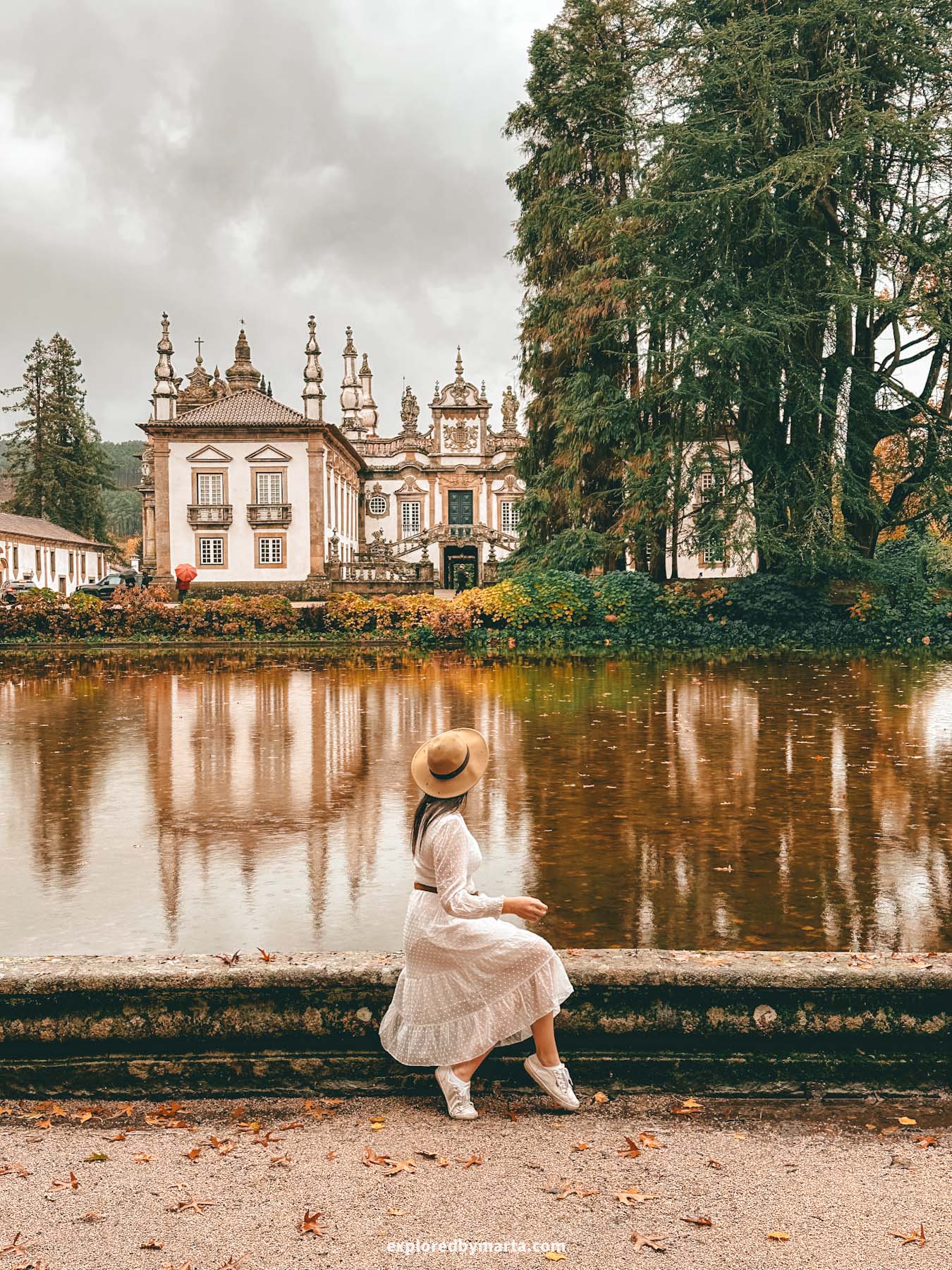

It’s a peaceful place to stroll, take photos, and enjoy the timeless atmosphere of the Portuguese countryside. I especially enjoyed the dark tunnel of the trees (see photos above!)!
Many visitors come here as part of cruise ship excursions, so you might see some larger groups of people if you come here.
If it were cheaper (we paid 12 EUR per person to see the gardens), I’d be more excited about this place, but I’ve been to better places with lower entrance fees. But, still, it was a beautiful place.
Location: Palacio de Mateus
20. Palace of Fronteira

Hidden near Monsanto forest park is one of the most beautiful places in Lisbon – the Palace of the Marquesses of Fronteira. It is a stunning 17th-century palace with an expansive garden.
The palace has an entrance fee – you can either pay a smaller fee to visit the palace’s gardens on your own, or pay a higher fee to see the interior of the palace (guided tours).
This palace is the perfect place to go if you wish to escape the city crowds and want to explore some hidden gems around Lisbon.
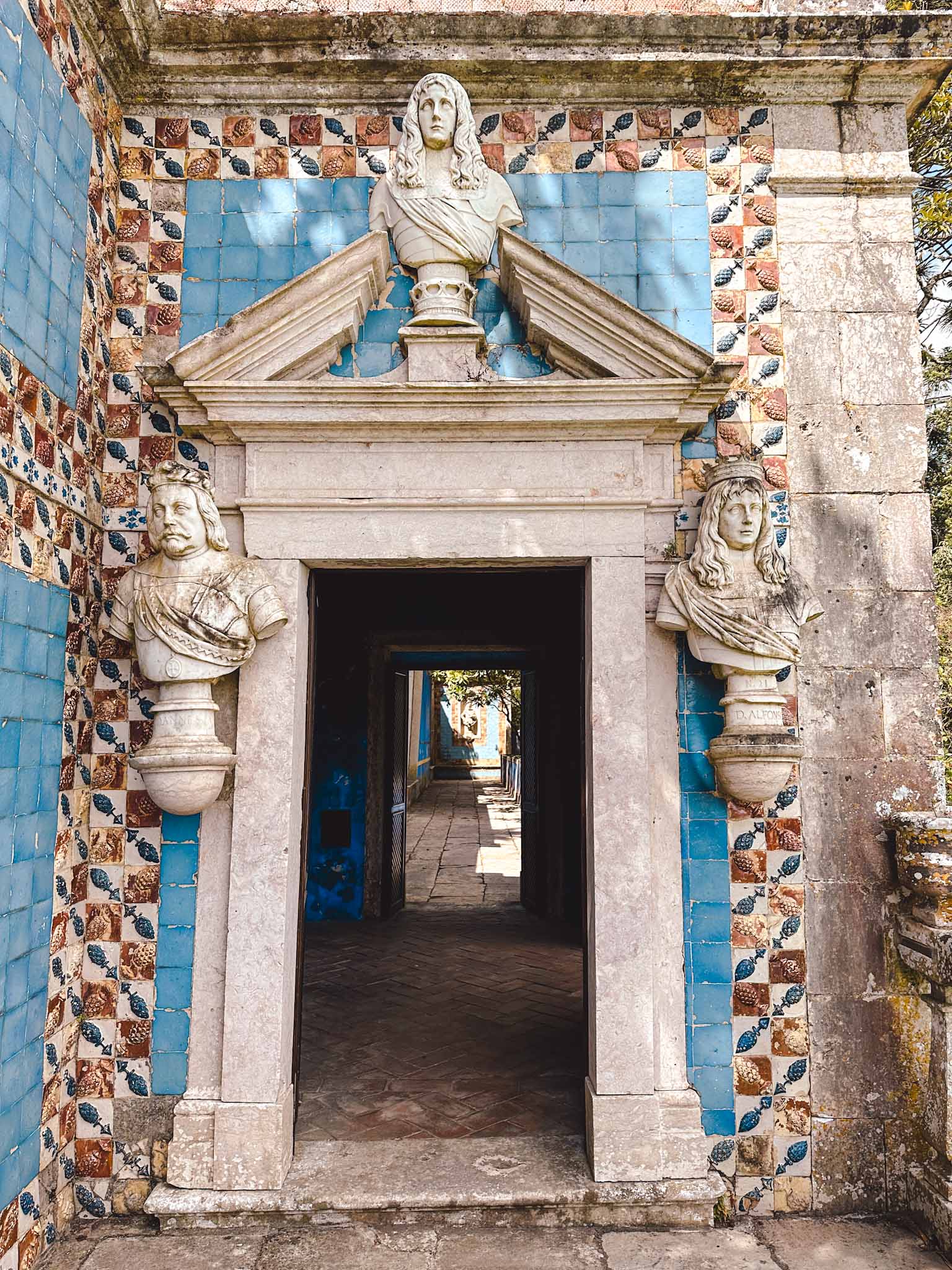
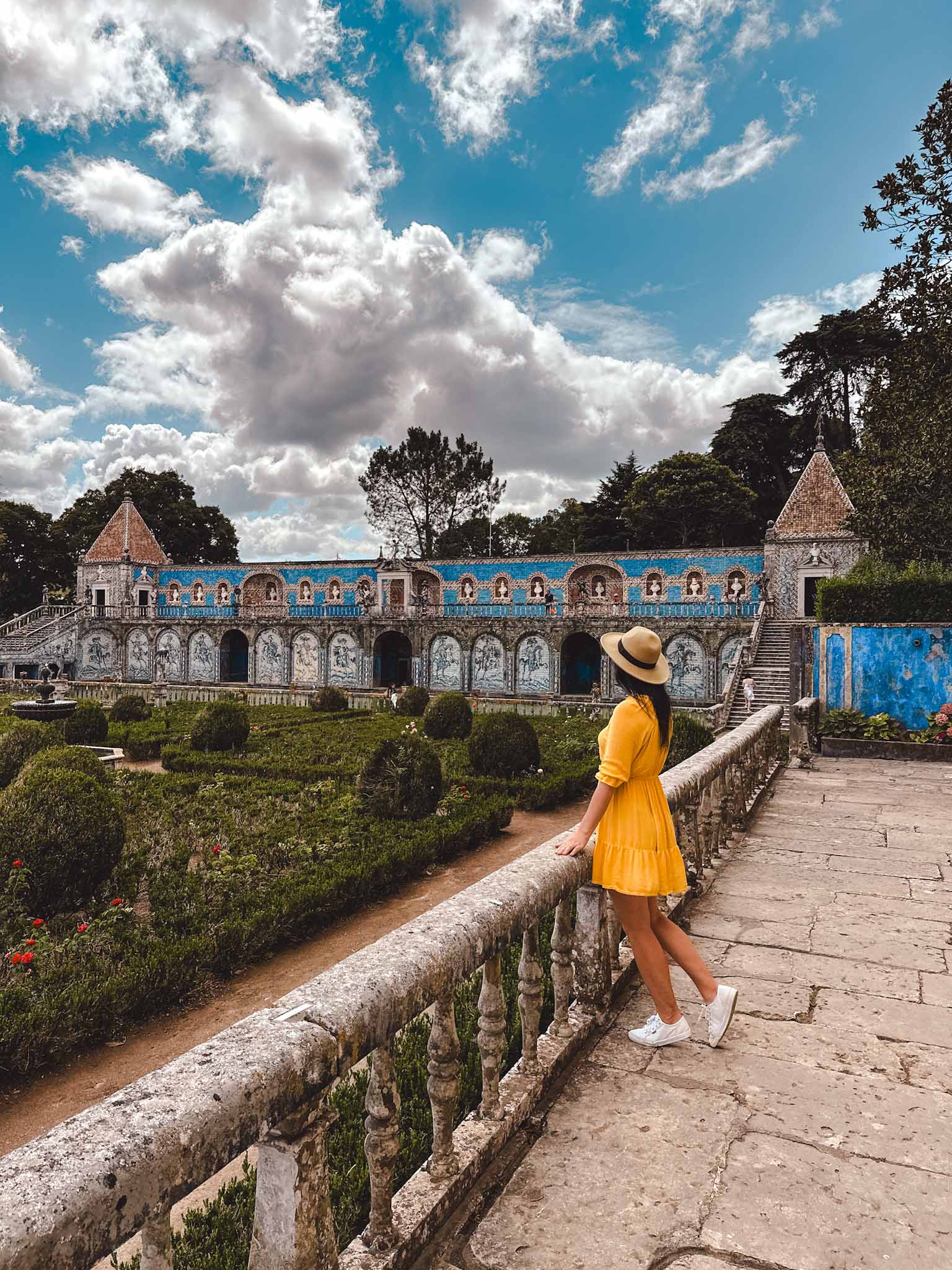
The visits inside the palace take place in guided tours, because the palace is still the private residence of the Marquesses of Fronteira. They do stay there at times!
We only visited the gardens, and it was definitely worth it!
The gardens feature a pond with swans, fountains, numerous sculptures, and benches to sit on. The whole area is full of decorative bushes and blooming plants. But the central piece of the garden is the blue wall next to the pond.
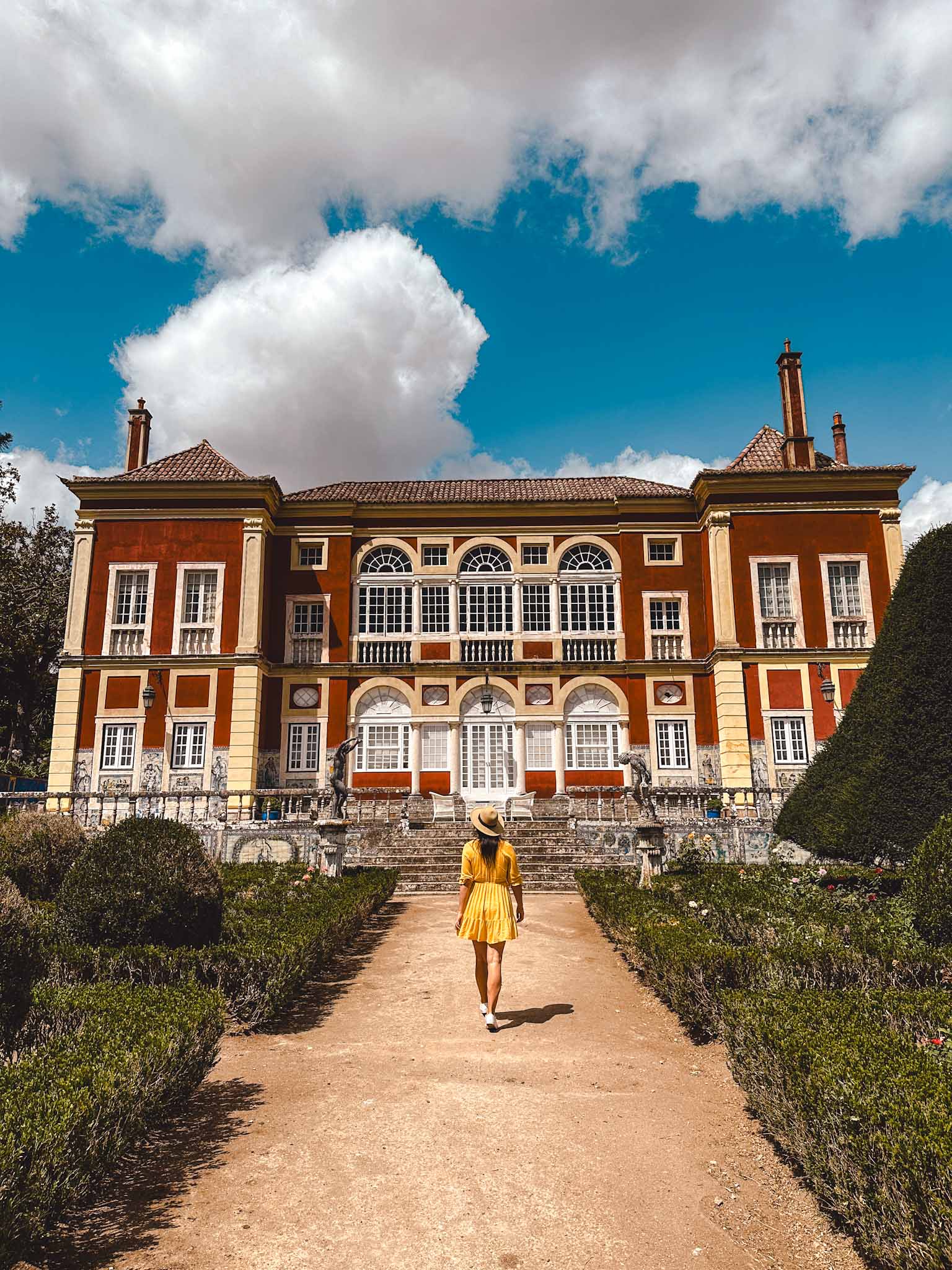
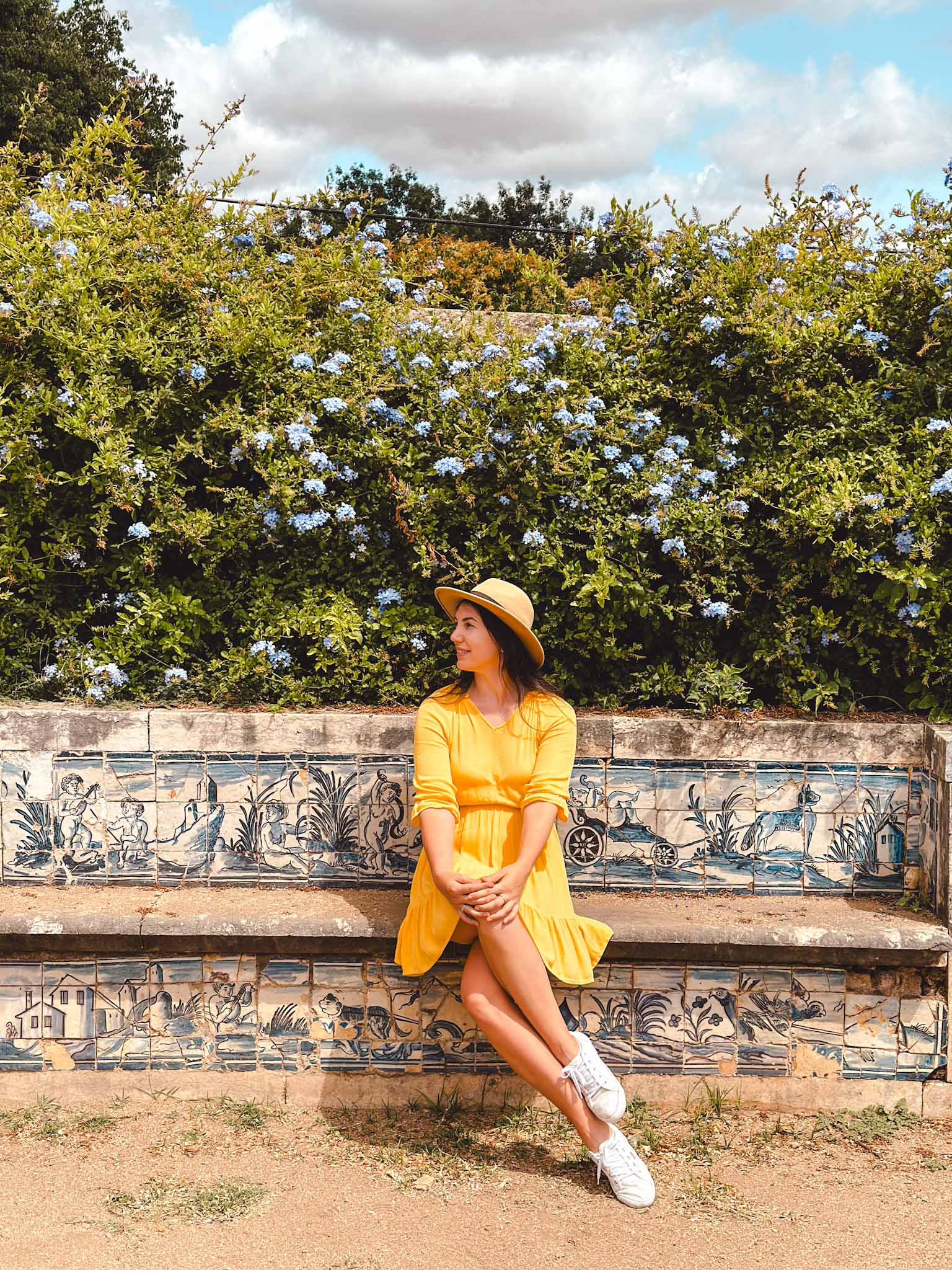
The blue wall has stairs on both sides where you can climb up to the upper part of the wall. It is lined with statues of the Kings of Portugal and decorated with glazed blue tiles.
Inside the garden, we also saw little benches all decorated with painted azulejo tiles (see my photos). Such an authentic Portuguese style!
The garden was super picturesque, even the weirdly green pond with black swans in it!

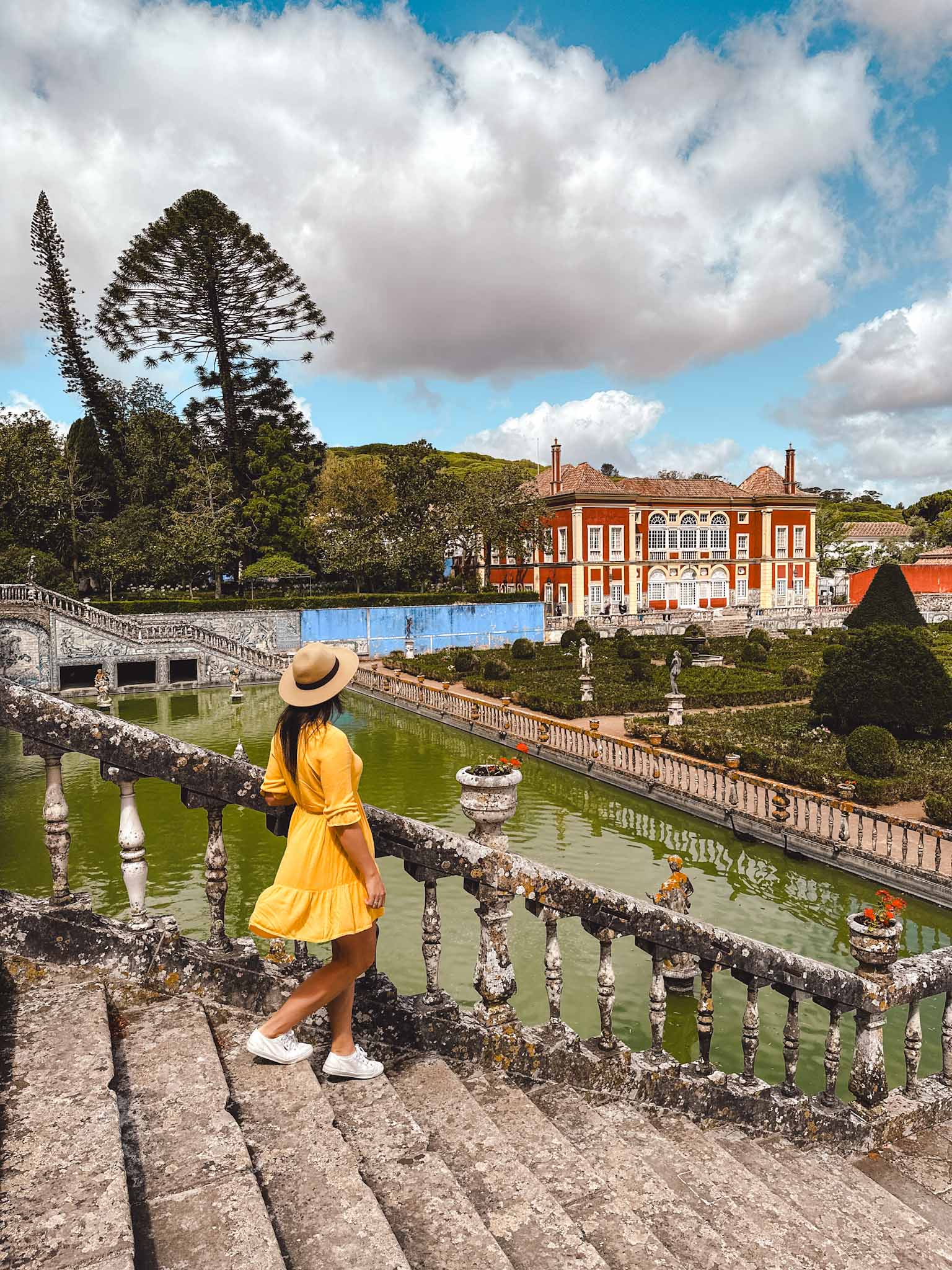
Hidden in the corner of the garden, you will find my favorite place in the whole garden – a tiny chapel.
The unique chapel is covered with stones, shells, and broken porcelain and glass – something I hadn’t seen before in Portuguese architecture. Such a hidden gem!
We had a rental car, so we got there on our own, but if you don’t rent a car, it is also very easy to reach by public transportation, as there are metro and train stations as well as bus stops close by. And you can always take a taxi.
Location: The Palace of Fronteira
21. Castelo de Monsaraz
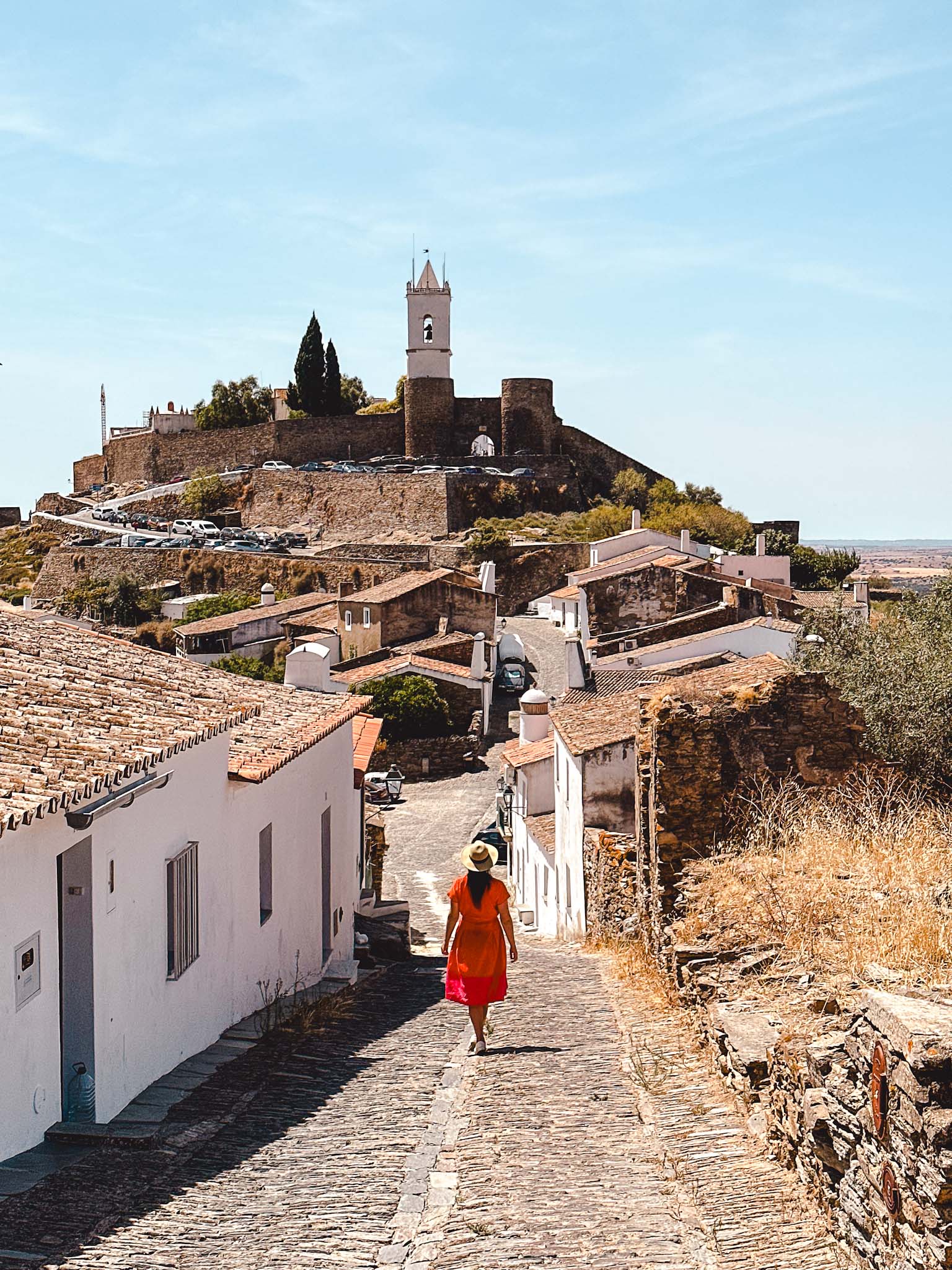
Monsaraz is a village in Évora district near the border of Spain. It sits on a scenic hill and is one of the oldest settlements in southern Portugal.
The most important landmark in Monsaraz is the medieval castle – Castelo de Monsaraz.
Due to its strategic location near the border and its advantageous position on a hill, it was once an important stronghold during many military conflicts that the country has experienced over the centuries. Monsaraz was under the rule of many different forces.
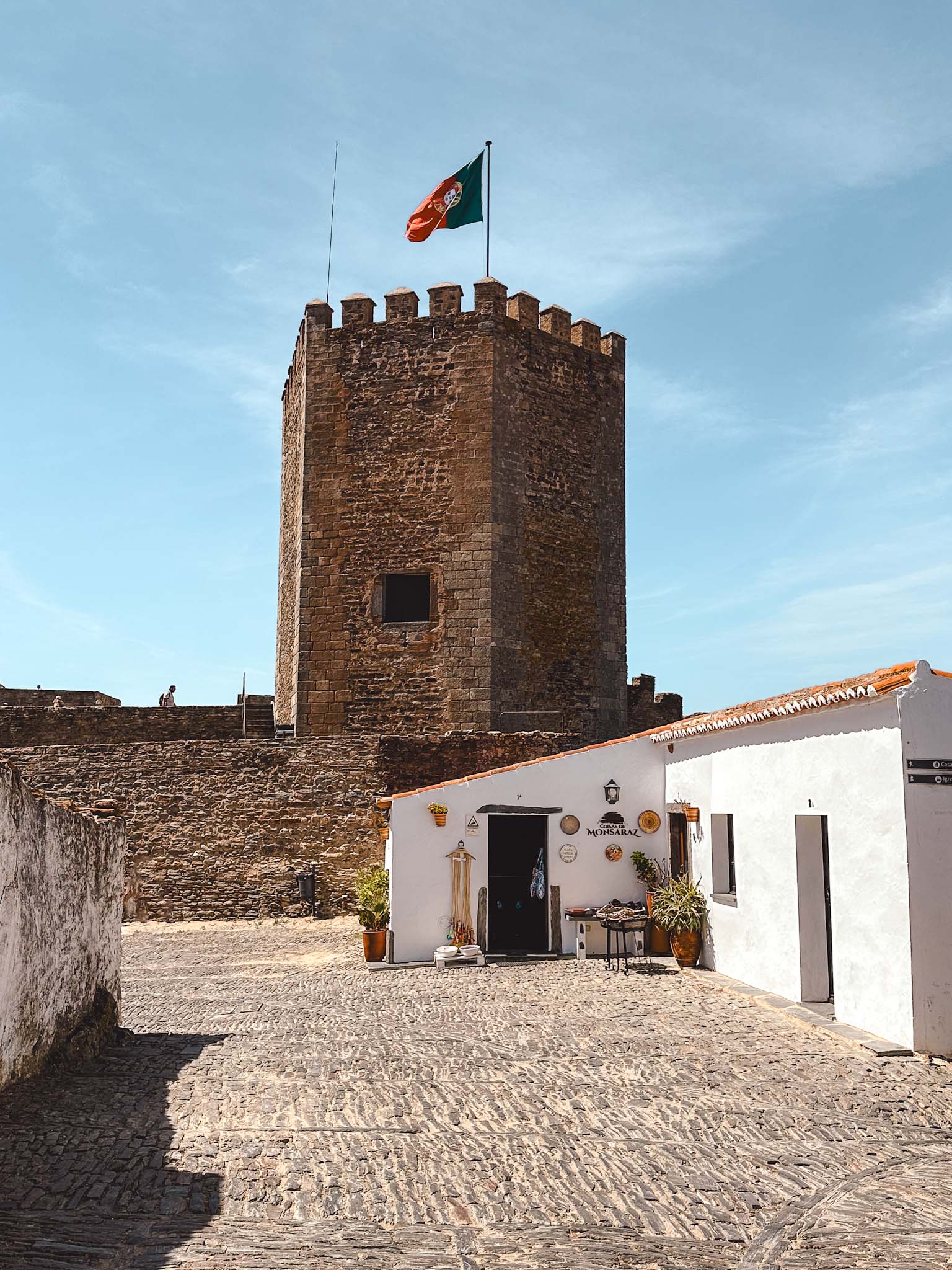
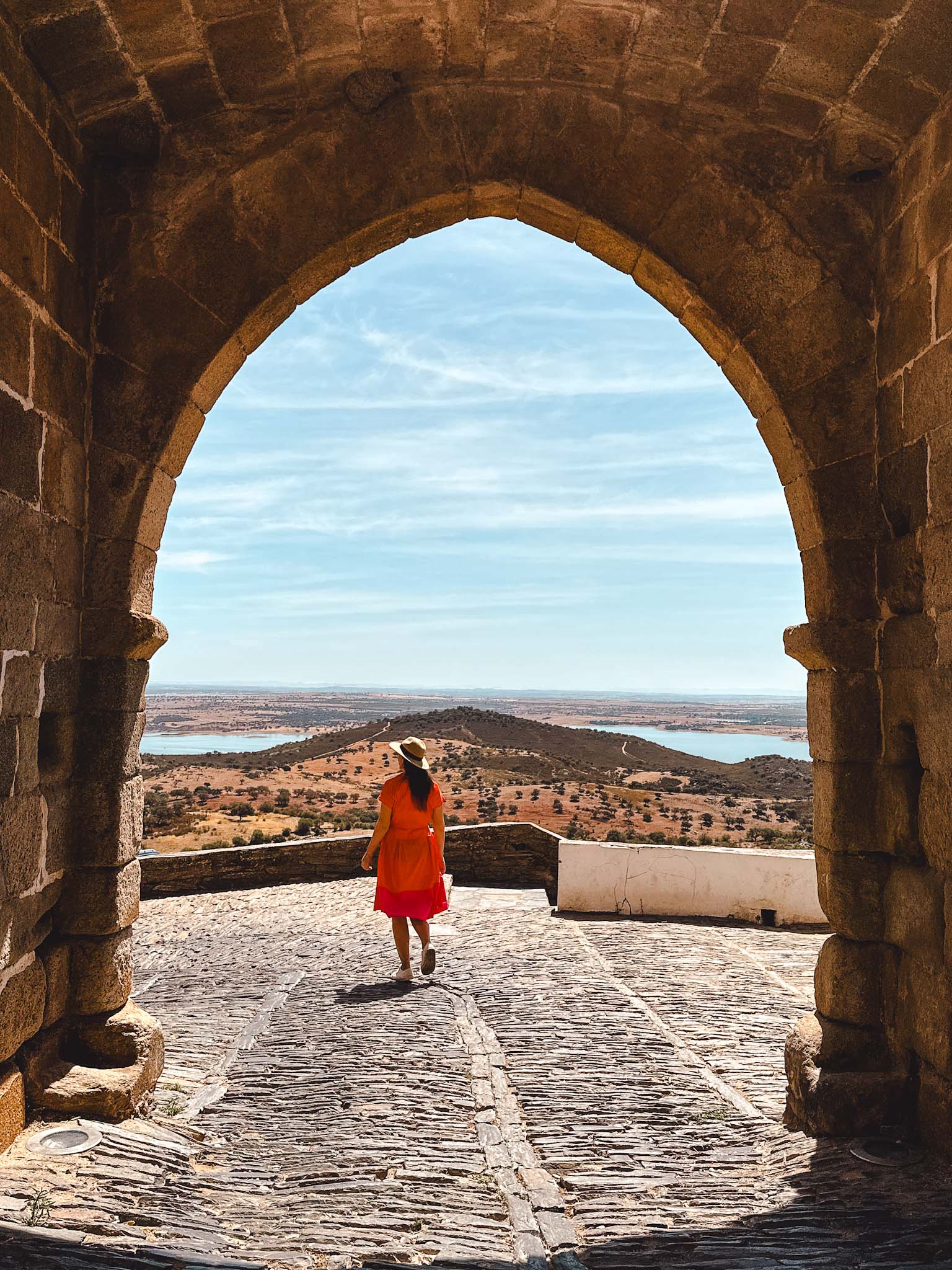
The imposing castle dates back to the 14th century. Much of what was built back then has still remained to this day. Walking around this medieval village felt like a time machine transporting me back in time.
You can visit the Castelo de Monsaraz for free.
From the top of the castle walls, you will get amazing views over the surrounding area, especially the Alqueva water reservoir created by the Guadiana River – it is the largest artificial lake in Western Europe.


There is not much left of the castle itself, so the views over the area, climbing up to the defensive walls, and walking around them were all that we got there. The inner enclosure of the castle today is used as a bullring.
But I really loved walking around the medieval village. It has whitewashed houses, narrow cobblestone streets, and stone defensive walls with only a couple of entrances, so you have to check where you can enter this fortification.
You can’t drive inside the village, so you will have to park your car outside the walls and then climb up to the village on foot. If you are into lost places from medieval times, then this is the perfect place for you!
Location: Castelo de Monsaraz – Parking lot
22. Castle of Monsanto

The Castle of Monsanto, a medieval fortress built in the 12th century by the powerful Knights Templar, is one of the most iconic castles in Portugal! Perched atop a hill at 763 meters (2,503 ft) above sea level, it offers stunning views of the surrounding landscape.
Did you know that it was the filming location for the House of the Dragon TV series?
Plus, the castle is located in the charming Monsanto village, which was voted as the most Portuguese village in Portugal. Pretty iconic, if you ask me!


Unfortunately, not much remains of the castle itself, as it suffered partial destruction in the 19th century due to an explosion in the gunpowder magazine, which severely damaged its structure.
But it feels surreal that this place has been standing here since the Middle Ages!
Today, you can access the castle territory for free. There are three inner courtyards with three walls and four defensive towers. You can actually climb up the walls and walk around the perimeter of the castle.
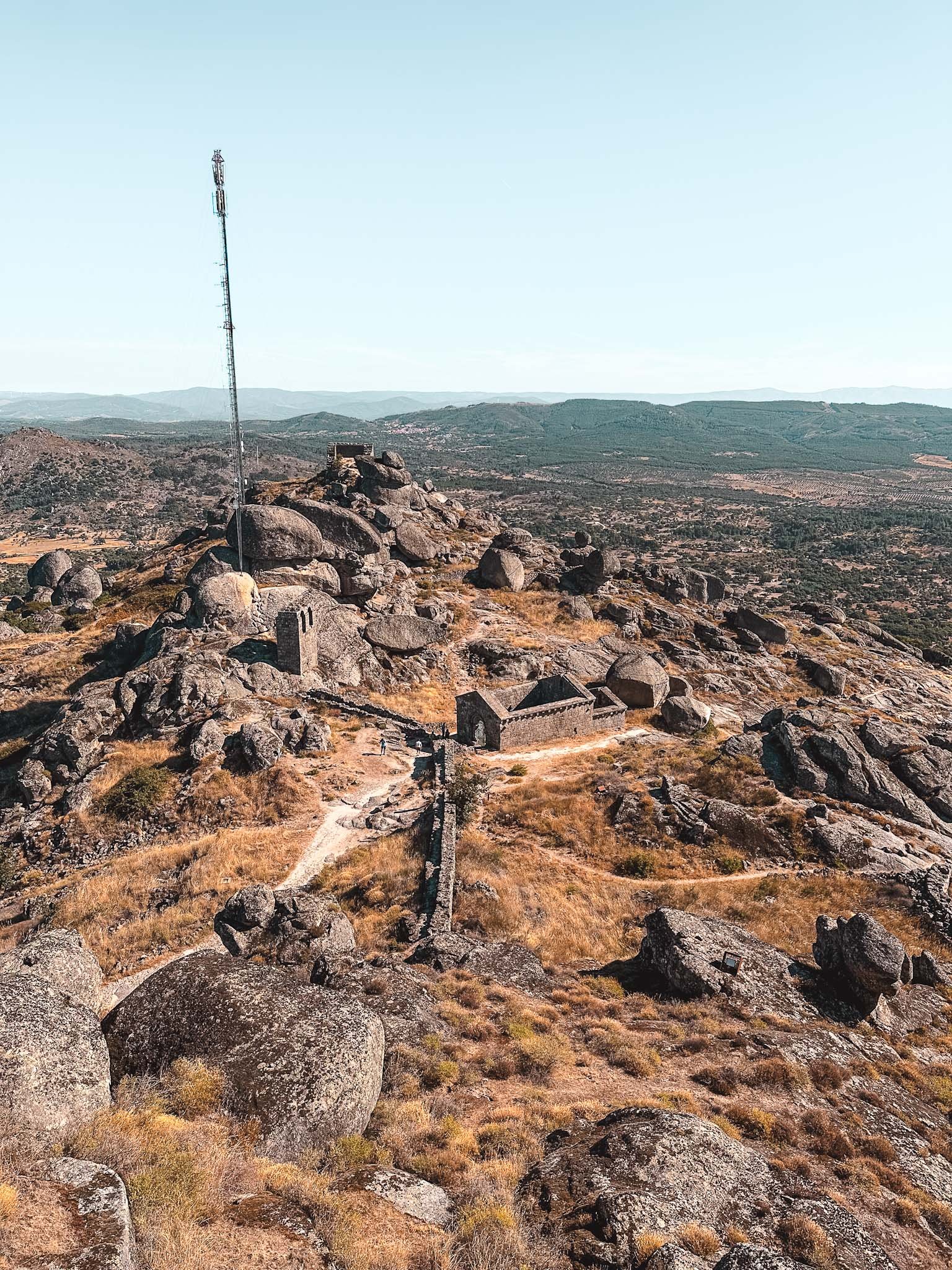
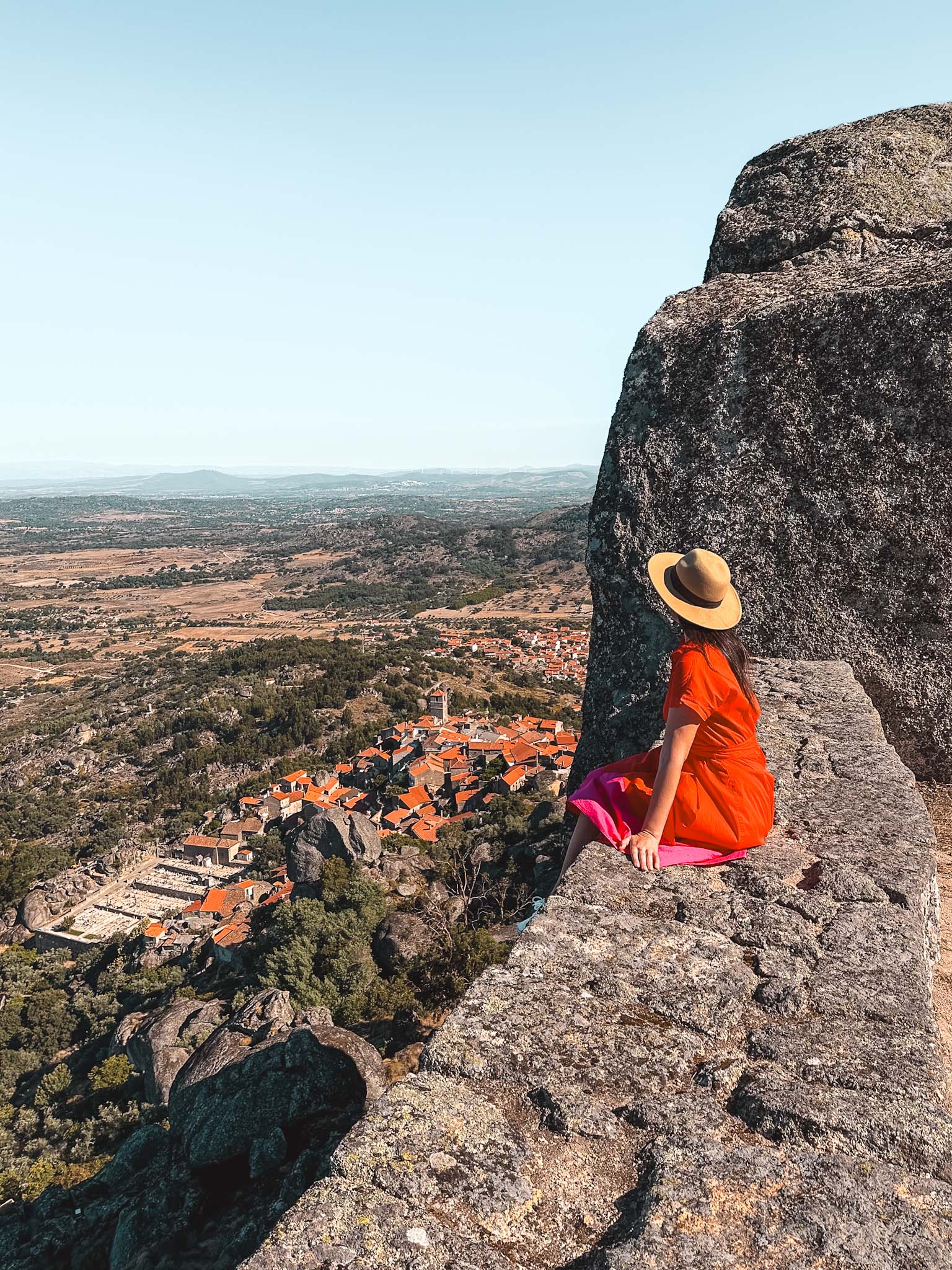
Inside the walls, you will notice a water cistern as well as the Chapel of Nossa Senhora do Castelo. I also recommend taking a stroll around the outside of the walls – there are some interesting historical locations nearby.
From the castle walls, you will get amazing views overlooking the village of Monsanto and the surrounding area. Sunset views are especially amazing!
The best time to visit the iconic castle is early in the morning, before the tourist buses arrive, or around sunset. It does get busy sometimes! Monsanto is a popular day trip destination from Lisbon and other parts of Portugal.
Location: Castle of Monsanto
23. Castelo de Montemor-o-Novo
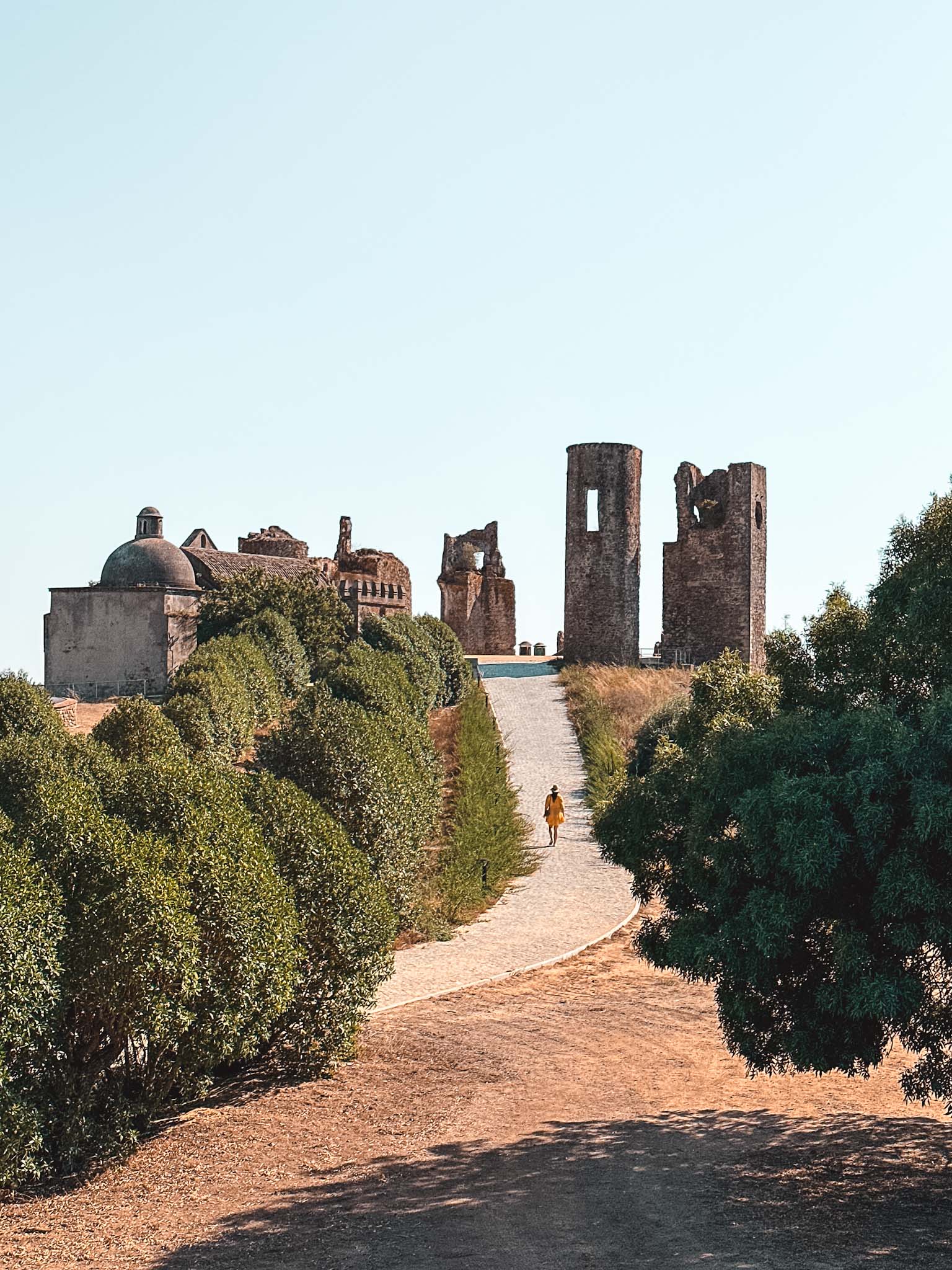
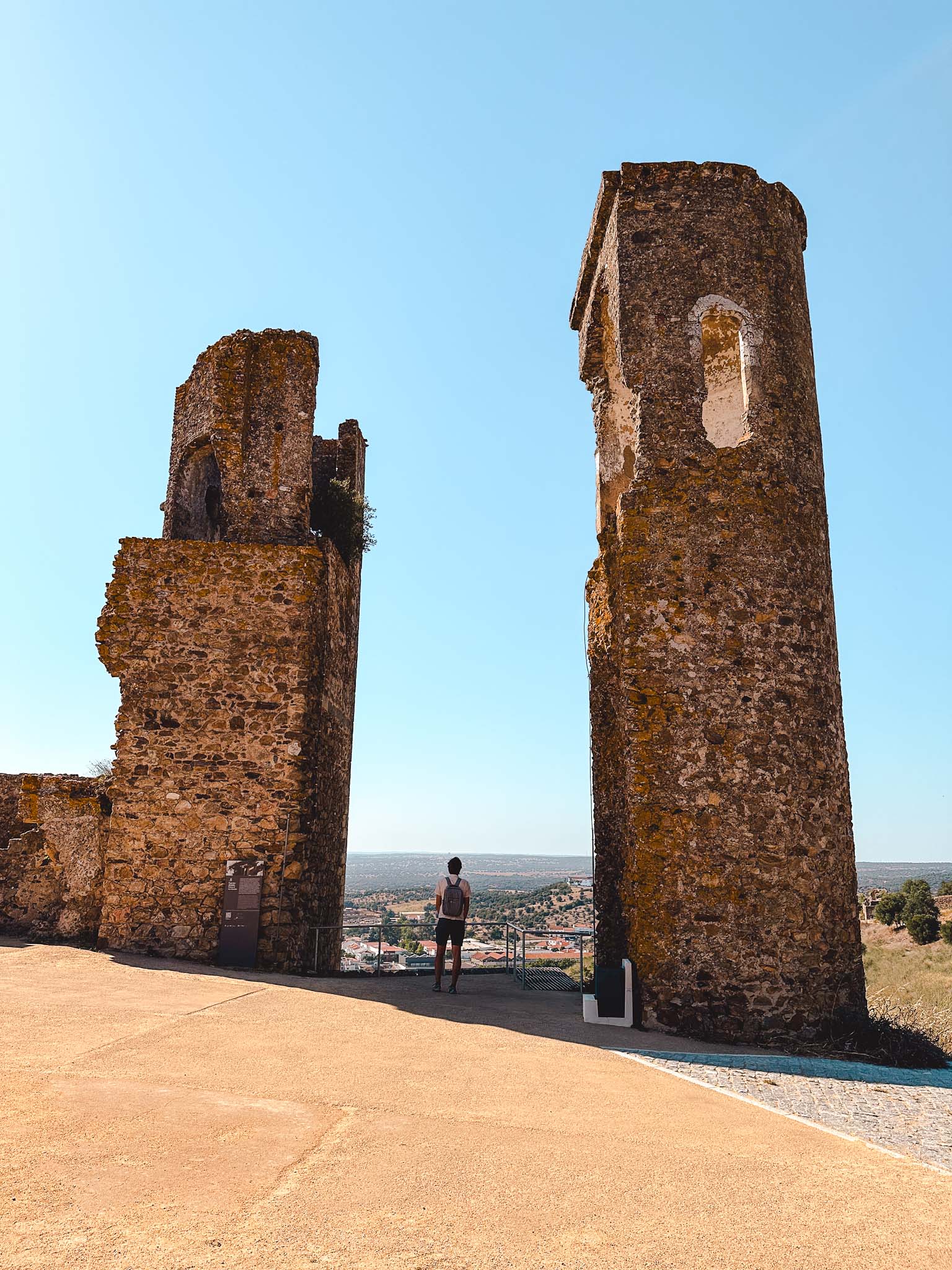
In case you are traveling to or back from Évora city to Lisbon, there is a cool place to stop by along that route – Castelo de Montemor-o-Novo. There are remains of a medieval hilltop village and castle with scenic views over the area.
It is believed that the construction of the castle started in the 13th century. The most notable thing about the castle is that Vasco da Gama finalized his plans for his famous sea voyage to India right here in this castle.


This was once a majestic castle with a village inside the fortress. However, over time, it has all disappeared. Now you can walk around the remains of the castle, read about the past on information boards, and see the views from the hilltop castle remains.
The best part about it is that the entrance is free. You can walk around the area freely and explore everything you want to see. We went there on a hot day when nobody was around. It was a unique moment to be there next to the castle – a reminder of the past.
Location: Castelo de Montemor-o-Novo
Happy exploring!
Portugal is a country straight out of a storybook, filled with grand palaces, medieval castles, and timeless charm around every corner. From the colorful hills of Sintra to the majestic fortresses guarding ancient towns, each castle tells a part of Portugal’s history.
Whether you’re wandering through royal halls once walked by kings and queens, or climbing up stone towers with sweeping views of the countryside, visiting castles in Portugal is like stepping into the past.
We’ve explored more places than we can count during our travels around Portugal, and castles always left a lasting impression on me. I hope this list helps you plan your own adventure and inspires you to discover more of Portugal’s wonders! Cheers!
PIN FOR LATER!

